Ab P2101
User Manual: Pdf Ab-p2101
Open the PDF directly: View PDF ![]() .
.
Page Count: 73
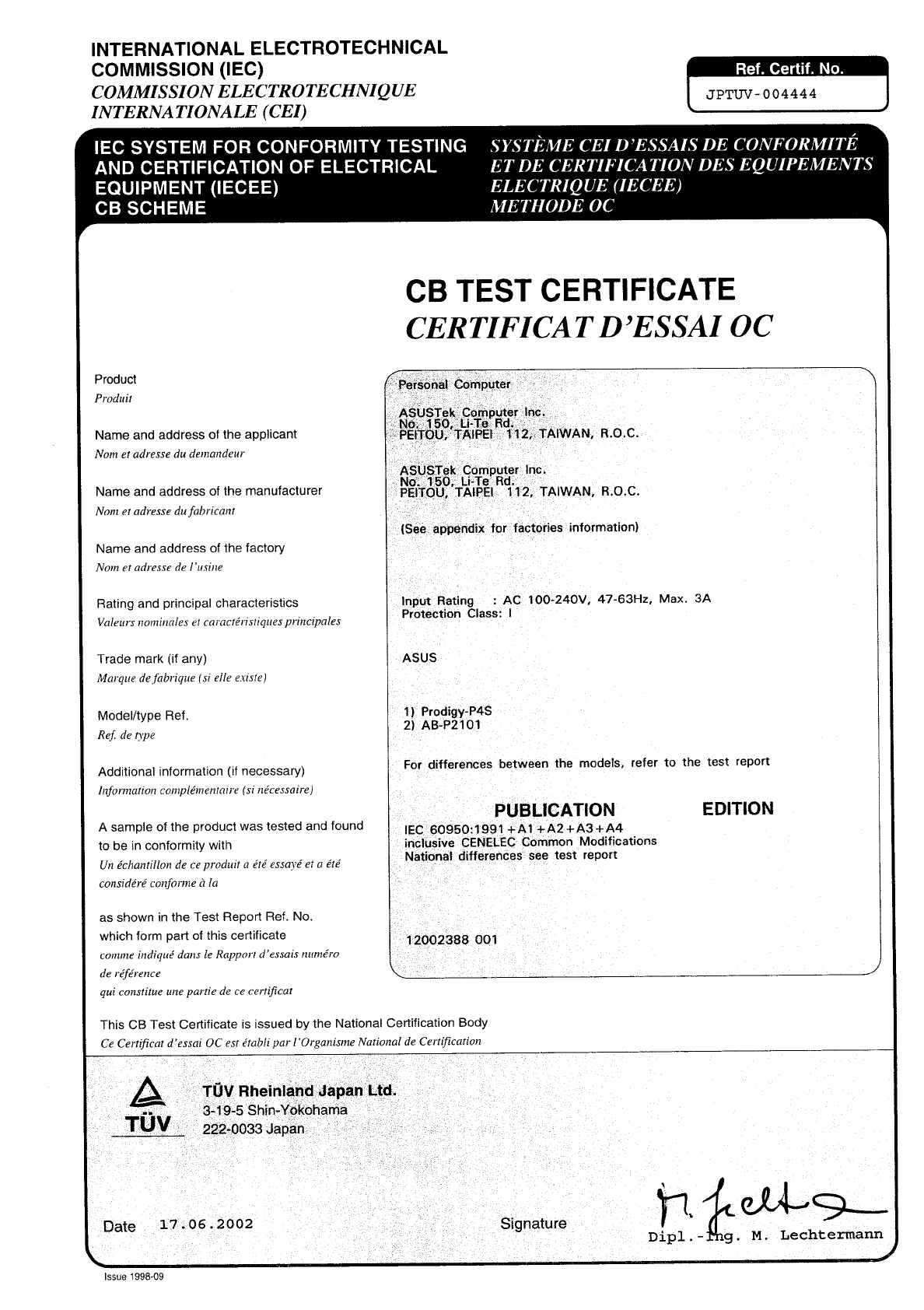
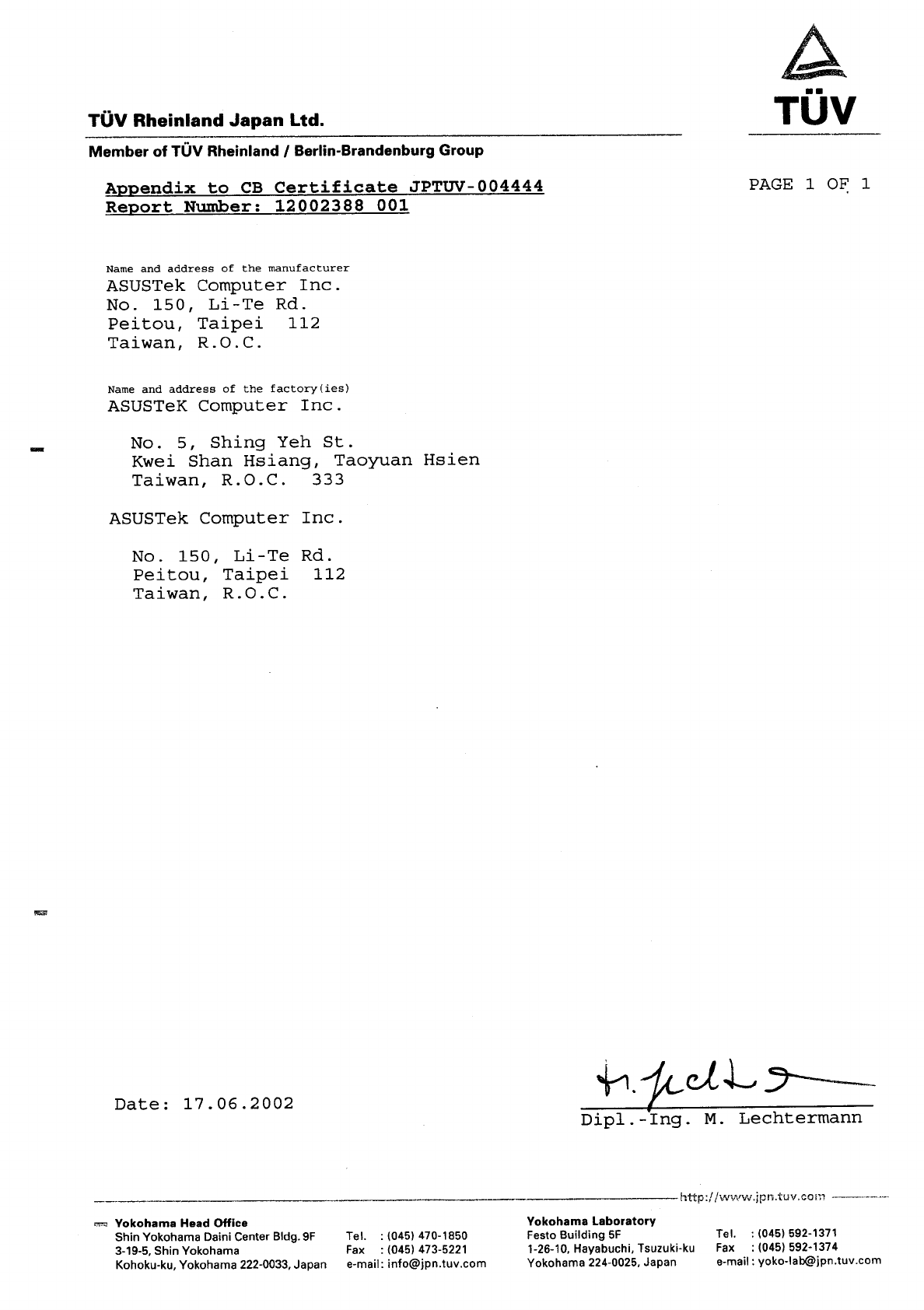
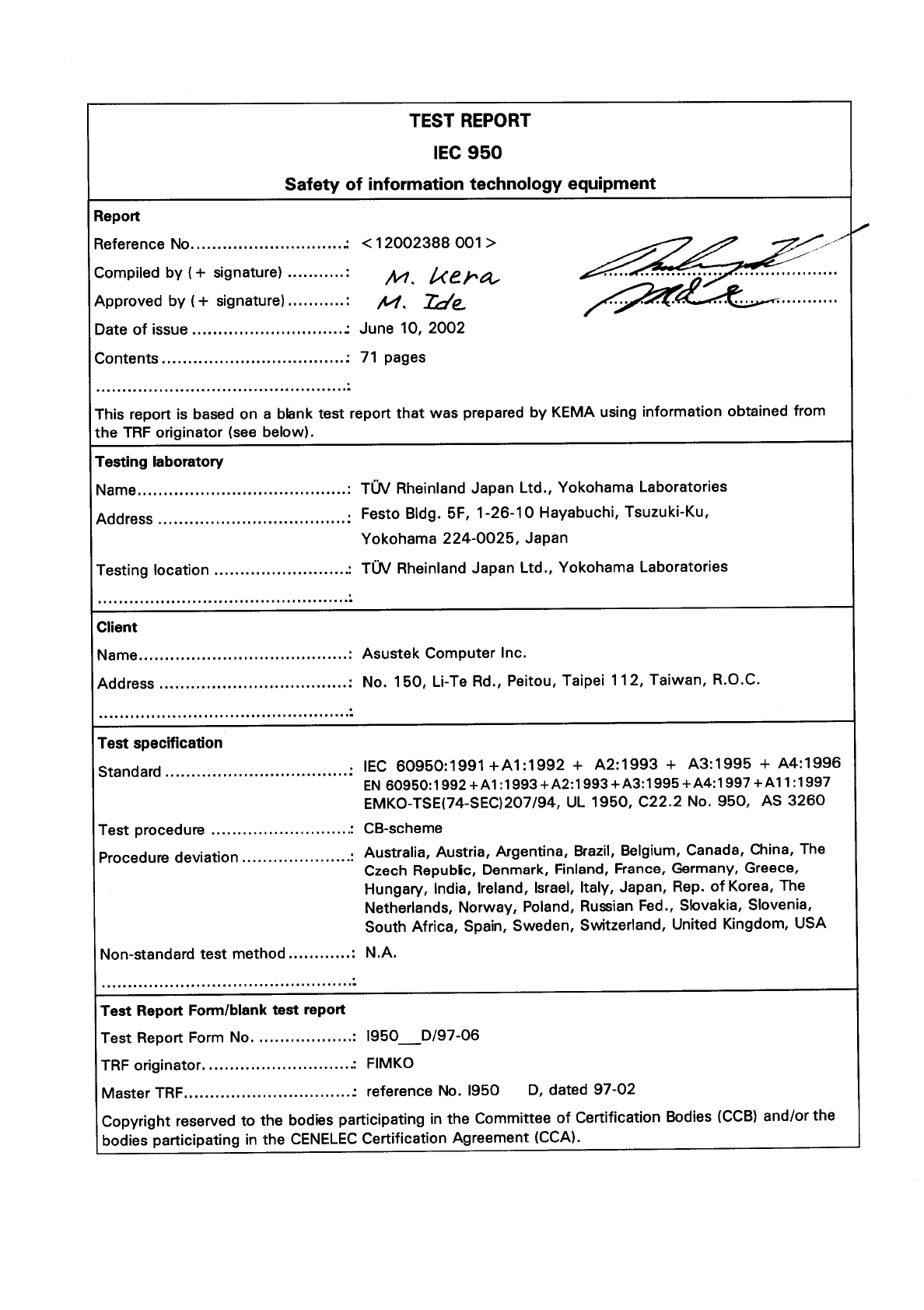
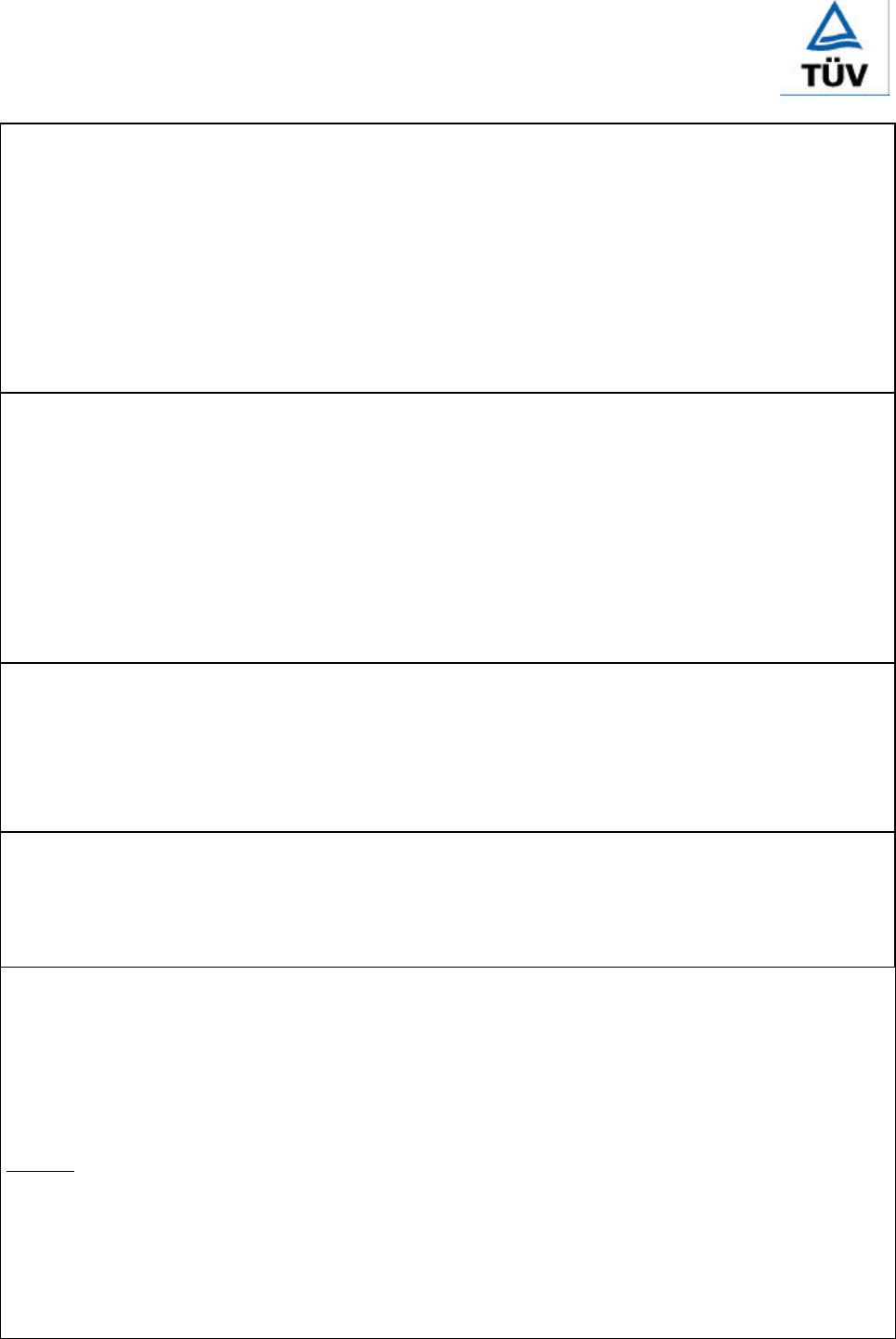
<12002388 001> Page 2
TRF No.: I950___D TRF originator: FIMKO
Test item
Description.................................:Personal Computer
Trademark..................................:ASUS
Model and/or type reference..........:1. Prodigy-P4S
2. AB-P2101
Manufacturer..............................:Same as client.
Rating(s) ....................................:100-240Vac, 47-63Hz, Max. 3A
.................................................:
Particulars: test item vs. test requirements
Equipment mobility............................................:Movable equipment
Operating condition............................................:Continuous operation
Tested for IT power systems...............................:Yes
IT testing, phase-phase voltage (V)......................:IT, 230V for Norway
Class of equipment............................................:Class I
Mass of equipment (kg)......................................:7.4kg
Protection against ingress of water ......................:IPX0
Test case verdicts
Test case does not apply to the test object...........:N(.A.)
Test item does meet the requirement ...................:P(ass)
Test item does not meet the requirement..............:F(ail)
.......................................................................:
Testing
Date of receipt of test item ................................:May, 2002
Date(s) of performance of test ............................:May, 2002
.......................................................................:
General remarks
This test report shall not be reproduced except in full without the written approval of the testing
laboratory.
The test results presented in this report relate only to the item tested.
"(see remark #)" refers to a remark appended to the report.
"(see appended table)" refers to a table appended to the report.
Throughout this report a point is used as the decimal separator.
Factory:
1. ASUSTek Computer Inc.
No. 5, Shing Yeh Street, Kwei Shan Hsiang, Taoyuan Hsien 333, Taiwan, R.O.C.
2. ASUSTeK Computer Inc.
No. 150, Li-Te Rd., Peitou, Taipei, Taiwan, R.O.C.
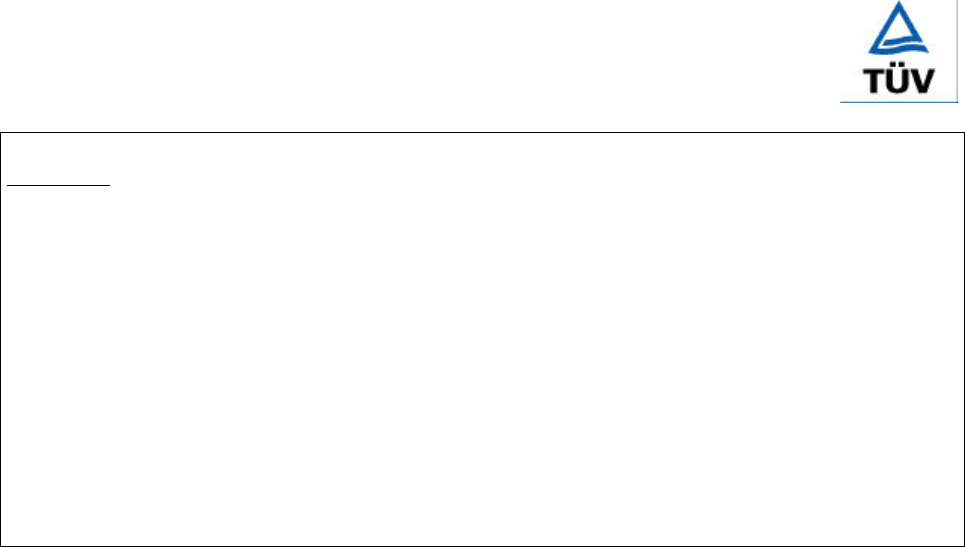
<12002388 001> Page 3
TRF No.: I950___D TRF originator: FIMKO
Comments:
Brief description of the test sample:
The model Prodigy-P4S and AB-P2101 are personal computers for general office use. These two models
are identical except for model name.
The internal building-in switching power supply is CB approved and evaluated according to Standard IEC
60950:A1+A2+A3+A4. Details of the power supply see appended table 1.5.1.
Unless otherwise specified, all tests were performed on model AB-P2101 to represent the other similar
model. The test samples were pre-production sample without serial numbers.
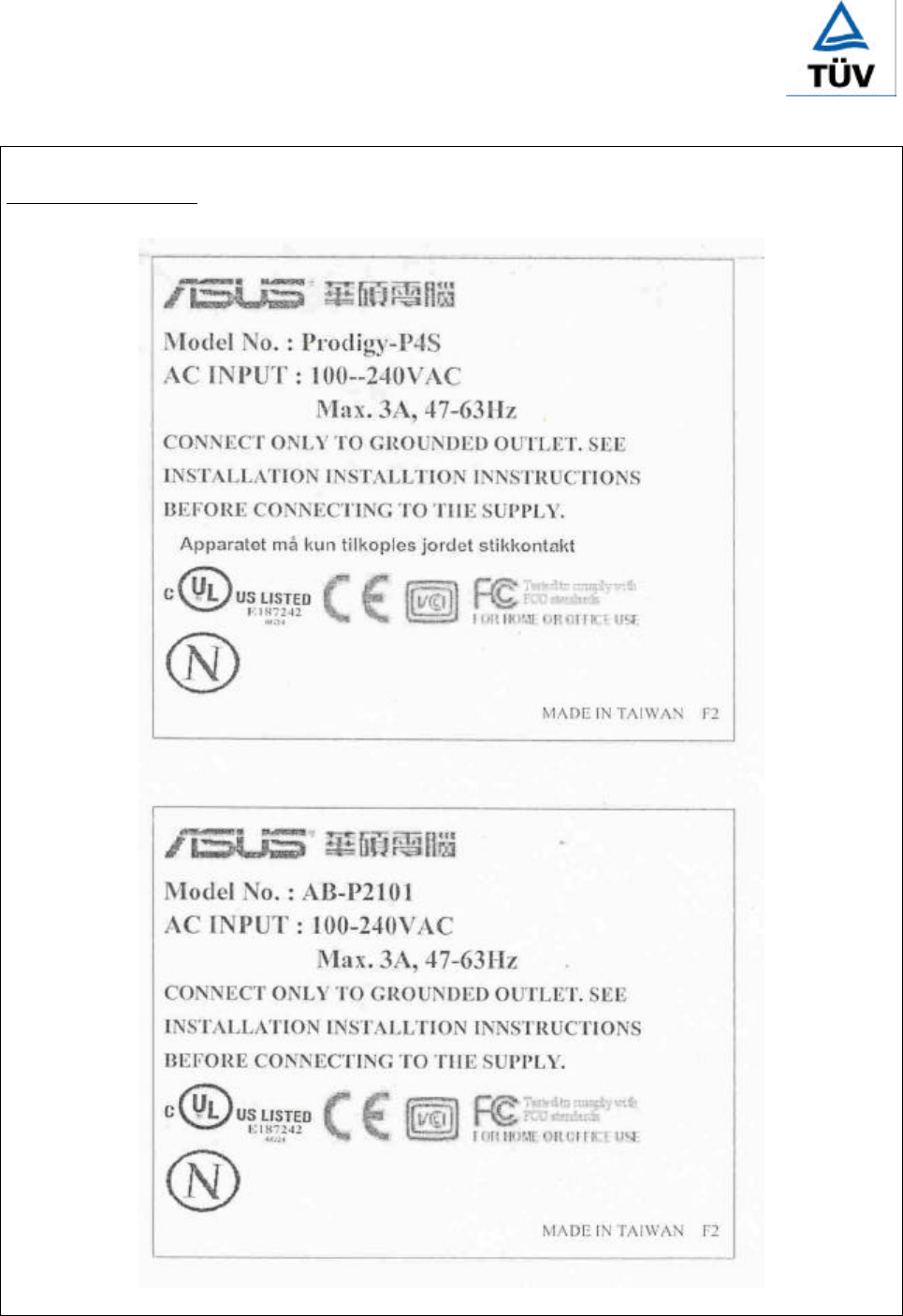
<12002388 001> Page 4
TRF No.: I950___D TRF originator: FIMKO
Copy of marking plate:
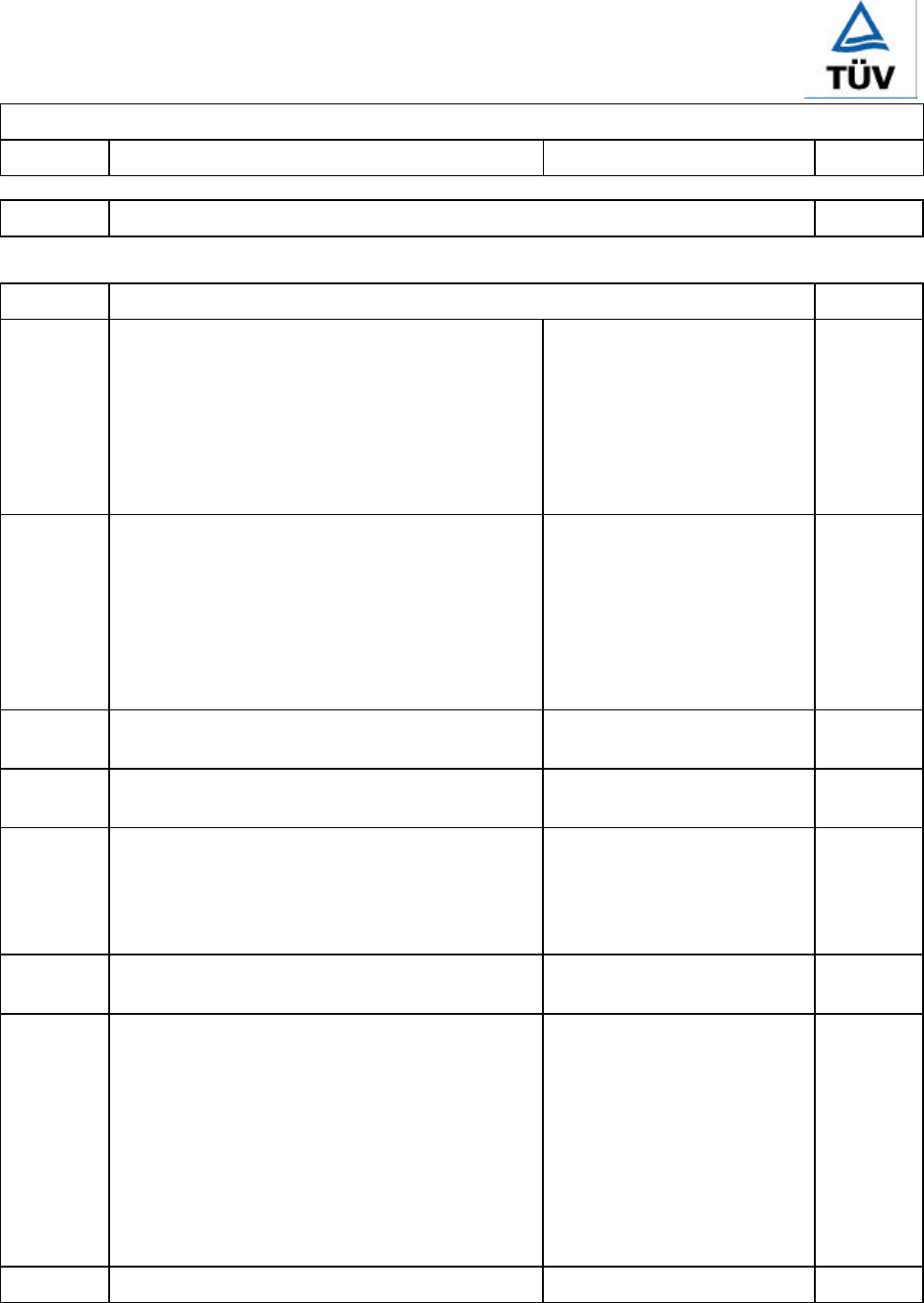
<12002388 001> Page 5
IEC 950
Clause Requirement − Test Result – Remark Verdict
TRF No.: I950___D TRF originator: FIMKO
1GENERAL P
1.5 Components P
1.5.1 Comply with IEC 950 or relevant component
standard Components which were
found to affect safety
aspects comply with the
requirements of this standard
or within the safety aspects
of the relevant IEC
component standards.
(see appended tables)
P
1.5.2 Evaluation and testing of components Components which are
certified to IEC and /or
national standards are used
correctly within their ratings.
Components not covered by
IEC standards are tested
under the conditions present
in the equipment.
P
Dimensions (mm) of mains plug for direct
plug-in ........................................................:The equipment is not plug-in
type N
Torque and pull test of mains plug for direct
plug-in; torque (Nm); pull (N) N
1.5.3 Transformers Transformer used are suitable
for their intended application
and comply with the relevant
requirements of the standard
and particularly Annex C.
P
1.5.4 High voltage components (component;
manufacturer; flammability) ...........................:No high voltage components
used. N
1.5.5 Interconnecting cables Interconnection cable for
signal output to other devices
and signal input from
accessories are carrying only
SELV voltages on an energy
level below 240VA.
→ Except for the insulation
material, there are no further
requirements to the
interconnection cable.
P
1.5.6 Mains capacitors In approved SPS. N
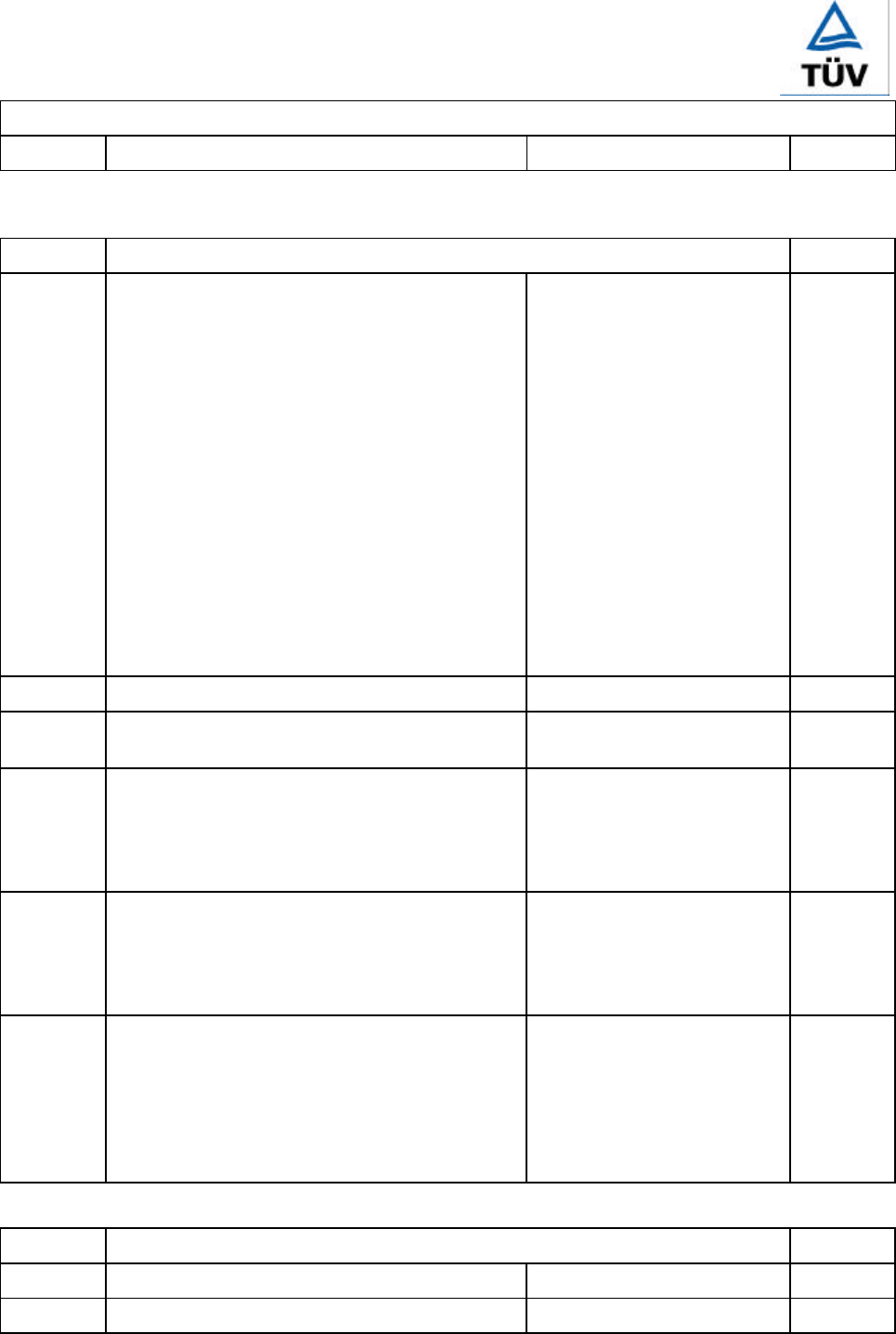
<12002388 001> Page 6
IEC 950
Clause Requirement − Test Result – Remark Verdict
TRF No.: I950___D TRF originator: FIMKO
1.6 Power interface P
1.6.1 Steady state input current Highest load according to
1.2.2.1 for this equipment is
the FDD, HDD, CD-RW,
DVD-ROM and CD-ROM
permanently access, the
dummy loads of 2.5W in
each USB connections and a
dummy load of 5Vdc/10W to
represent each slots on
computer mainboard. The
operator can connect
additional options like a
parallel printer or a serial
device. The output power of
max. 0.5W is considered to
be negligible.
(see appended table)
P
Current deviation during normal operating cycle <+10% P
1.6.2 Voltage limit of hand-held equipment This appliance is not a hand-
held equipment. N
1.6.3 Neutral conductor insulated from earth and body The neutral is not identified in
the equipment. Basic
insulation for rated voltage
between earthed parts and
primary phases.
P
1.6.4 Components in equipment intended for IT power
system Phase to earth designed in
according to phase-to-phase
working voltage. The Y2 type
capacitor used between
phase-to-earth.
P
1.6.5 Mains supply tolerance (V) ............................:+6%, -10%
Documentation specifies a
rating of AC 100-240V at
47-63Hz with +6%, -10%
tolerance. Relevant tests
were done with the range of
90-254V at 47-63Hz.
P
1.7 Marking and instructions P
1.7.1 Rated voltage (V) .........................................:100-240VAC P
Symbol of nature of supply for d.c. ................:Mains from AC source N
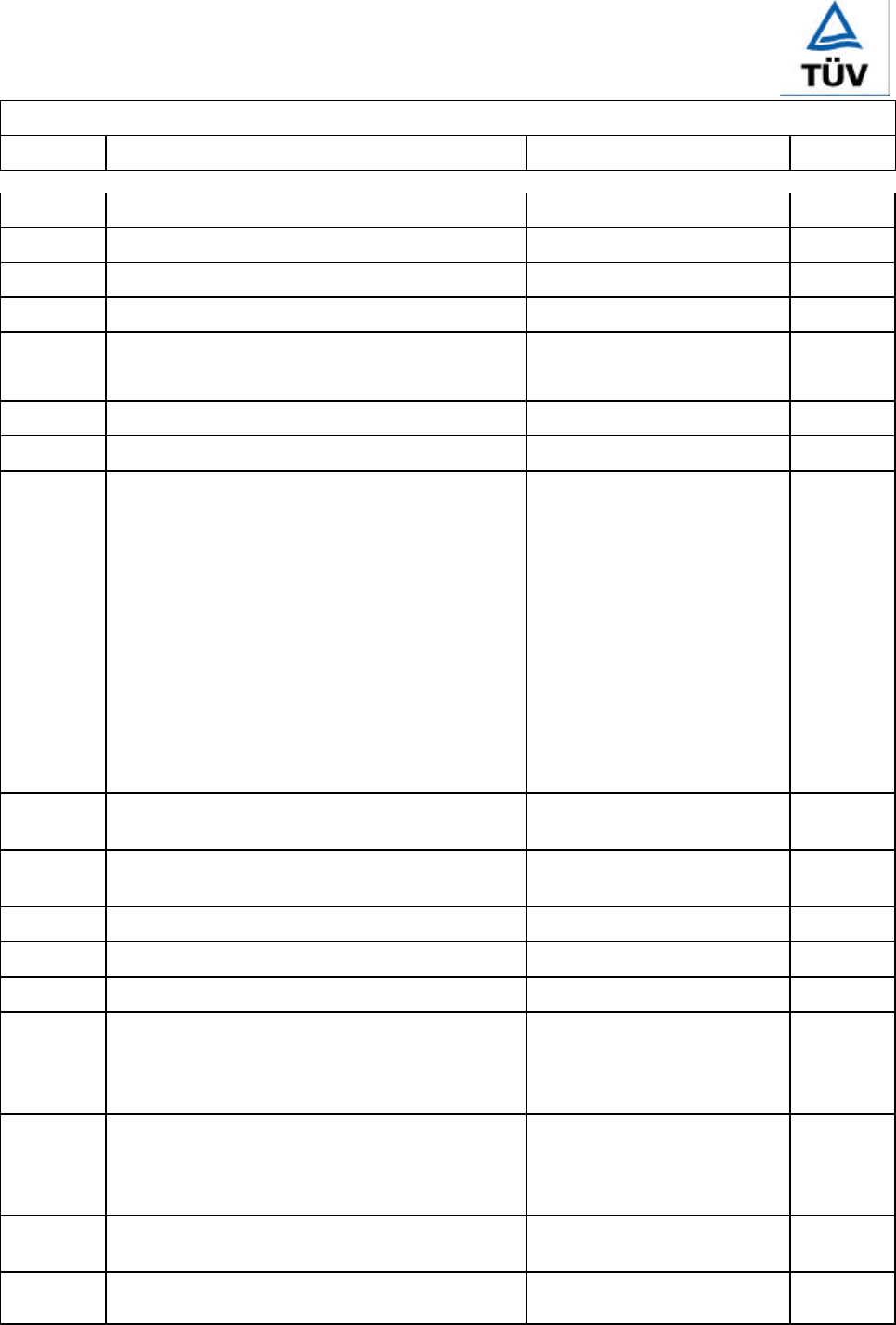
<12002388 001> Page 7
IEC 950
Clause Requirement − Test Result – Remark Verdict
TRF No.: I950___D TRF originator: FIMKO
Rated frequency (Hz) ....................................:47-63Hz P
Rated current (A) .........................................:Max. 3A P
Manufacturer ...............................................:Not shown P
Trademark ..................................................:ASUSP
Type/model .................................................:1. Prodigy-P4S
2. AB-P2101
P
Symbol of Class II ........................................:Class I equipment N
Certification marks .......................................:N, UL, CUL N
1.7.2 Safety instructions The users manual contains
information for operation,
installation, servicing,
transport, storage and
technical data.
Marking for laser class 1
type CD-ROM (or CD-RW,
DVD-ROM), with the
following wording:
CLASS 1 LASER PRODUCT
APPAREIL A LASER DE
CLASSE 1
LASERSCHUTZKLASSE1
PRODUKT
P
1.7.3 Short duty cycles Equipment is designed for
continuous operation. N
1.7.4 Marking for voltage setting/frequency setting ...:Full range design, no
necessary adjustment. N
1.7.5 Marking at power outlets ..............................:No outlet. N
1.7.6 Marking at fuseholders ..................................:In approved SPS. N
1.7.7.1 Protective earthing terminals Appliance inlet used. N
1.7.7.2 Terminal for external primary power supply
conductors
The equipment with appliance
inlet is intended to be used
with the detachable type
power supply cord.
N
1.7.8.1 Identification and location of switches and
controls ......................................................:The marking and indication of
the functional switch is
located that indication of
function clearly.
P
1.7.8.2 Colours of controls and indicators ..................:No safety relevant controls or
indicators. N
1.7.8.3 Symbols according to IEC 417 .......................:The switch on front panel
with symbol according to IEC P
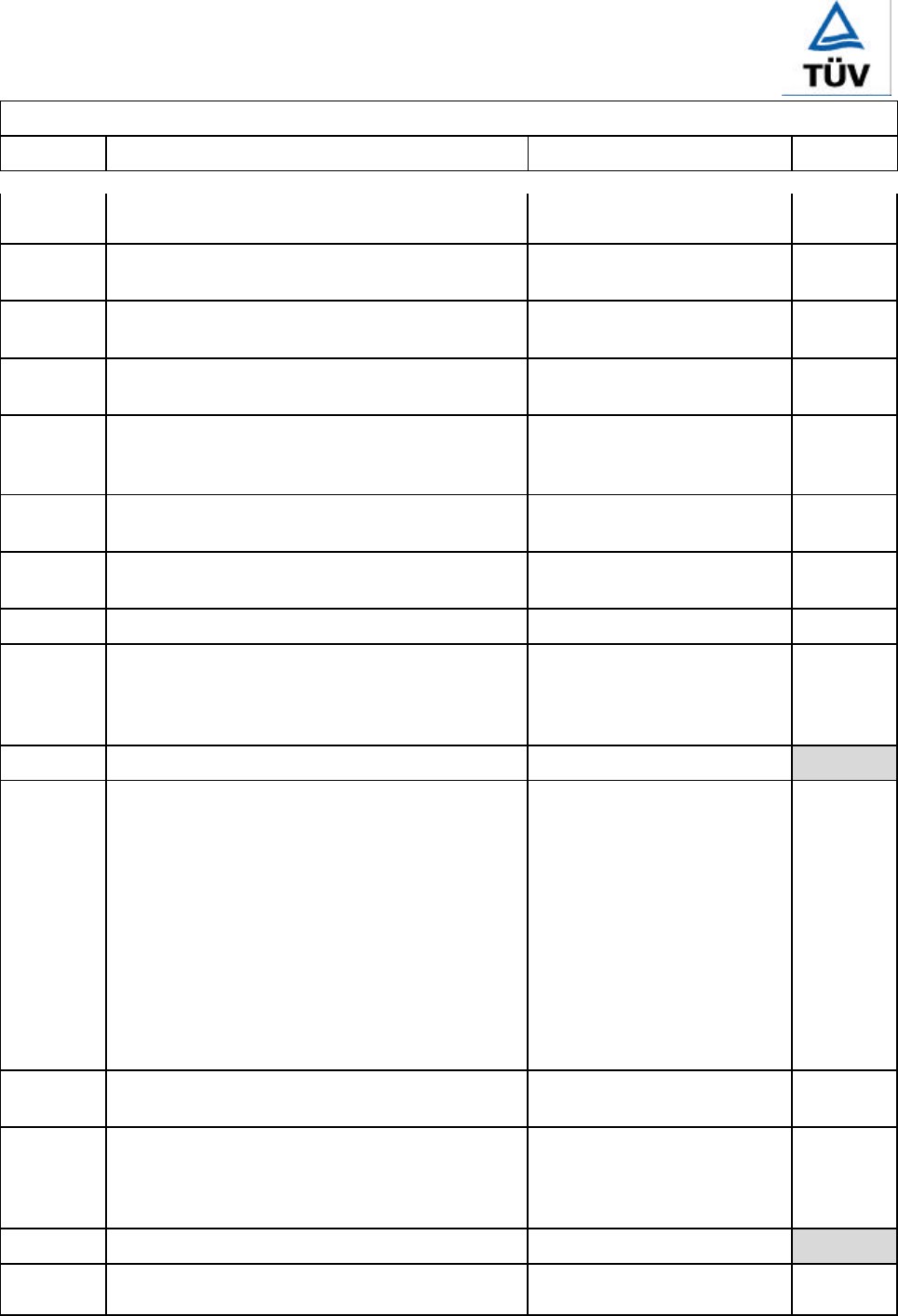
<12002388 001> Page 8
IEC 950
Clause Requirement − Test Result – Remark Verdict
TRF No.: I950___D TRF originator: FIMKO
60417, No. 5009 (line half
inside circle).
1.7.8.4 Figures used for marking ...............................:No indicator for different
position. N
1.7.8.5 Location of markings and indications for
switches and controls ...................................:Switch marking placed on
the switch knob. P
1.7.9 Isolation of multiple power sources .................:Only one supply from the
mains. N
1.7.10 Instructions for installation to IT power system The instructions will be
provided when national
approval.
N
1.7.11 Instructions when protection relies on building
installation Connected to the mains by
pluggable type A. N
1.7.12 Marking when leakage current exceeds 3,5 mA Leakage current does not
exceed 3.5mA. N
1.7.13 Indication at thermostats and regulating devices No adjustable thermostats. N
1.7.14 Language of safety markings/instructions User’s manual provided in
English. Version in other
languages will be provided
when national approval.
P
Language ....................................................:English
1.7.15 Durability and legibility The label was subjected to
the permanence of marking
test. The label was rubbed
with cloth soaked with water
for 15 sec. and then again
for 15 sec. with the cloth
soaked with petroleum spirit.
After this test there was no
damage to the label. The
marking on the label did not
fade. There was no curling
nor lifting of the label edge.
P
1.7.16 Removable parts No required markings placed
on removable parts. P
1.7.17 Warning text for replaceable lithium batteries Lithium battery for real time
clock is exchangeable.
Warning sentence printed in
manual.
P
Language ....................................................:English
1.7.18 Operator access with a tool ...........................:The inside of the personal
computer is regarded to be P
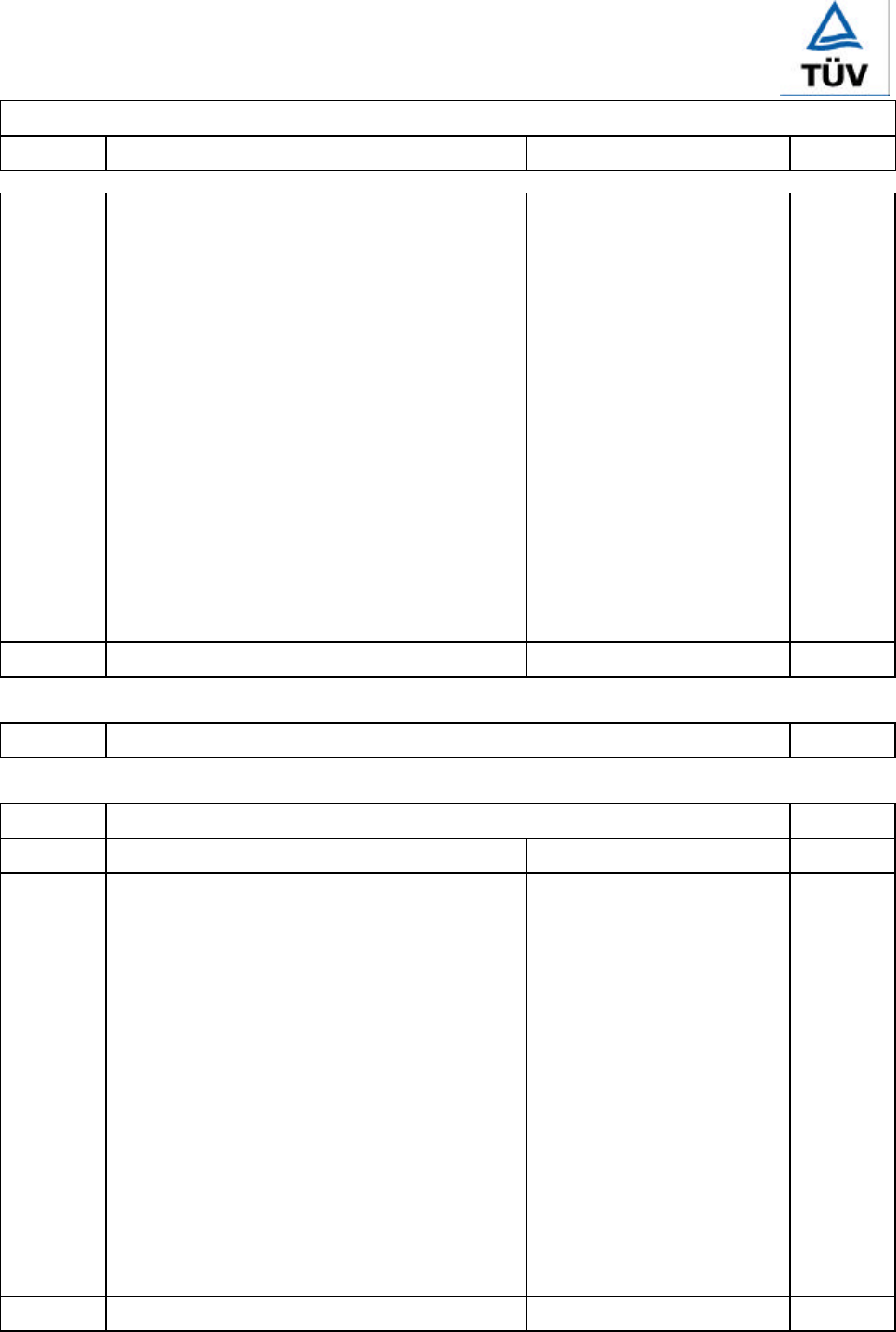
<12002388 001> Page 9
IEC 950
Clause Requirement − Test Result – Remark Verdict
TRF No.: I950___D TRF originator: FIMKO
operator access area. This
area is accessible when
enclosure of computer is be
disassembled with a
screwdriver.
When the enclosure is
disassembled, the earthed
metal enclosure of SPS is
accessible.
However, the SPS enclosure
can be opened with the same
screw driver as the screw
head is in same construction.
Therefore, the SPS provided
with electric shock hazard
symbol (ISO 3864, No.
5036) on its rating label to
discourage the user to
access.
1.7.19 Equipment for restricted access locations ........:No restricted access location. N
2PROTECTION FROM HAZARDS P
2.1 Protection against electric shock and energy hazards P
2.1.1 Access to energized parts See below. P
2.1.2 Protection in operator access areas As the user’s manual
specifies directions for the
operator how to add
additional memory cards or
add-on cards inside the
enclosure, the inside of this
server is regarded to be
operator access area. With
the disassembled server
enclosure, the accessible SPS
is covered with an earthed
metal enclosure.
The construction of this metal
enclosure prevents the
accessibility to any parts with
only basic insulation to ELV
or hazardous voltage with
test pin or test finger.
P
Test by inspection ........................................:dto P
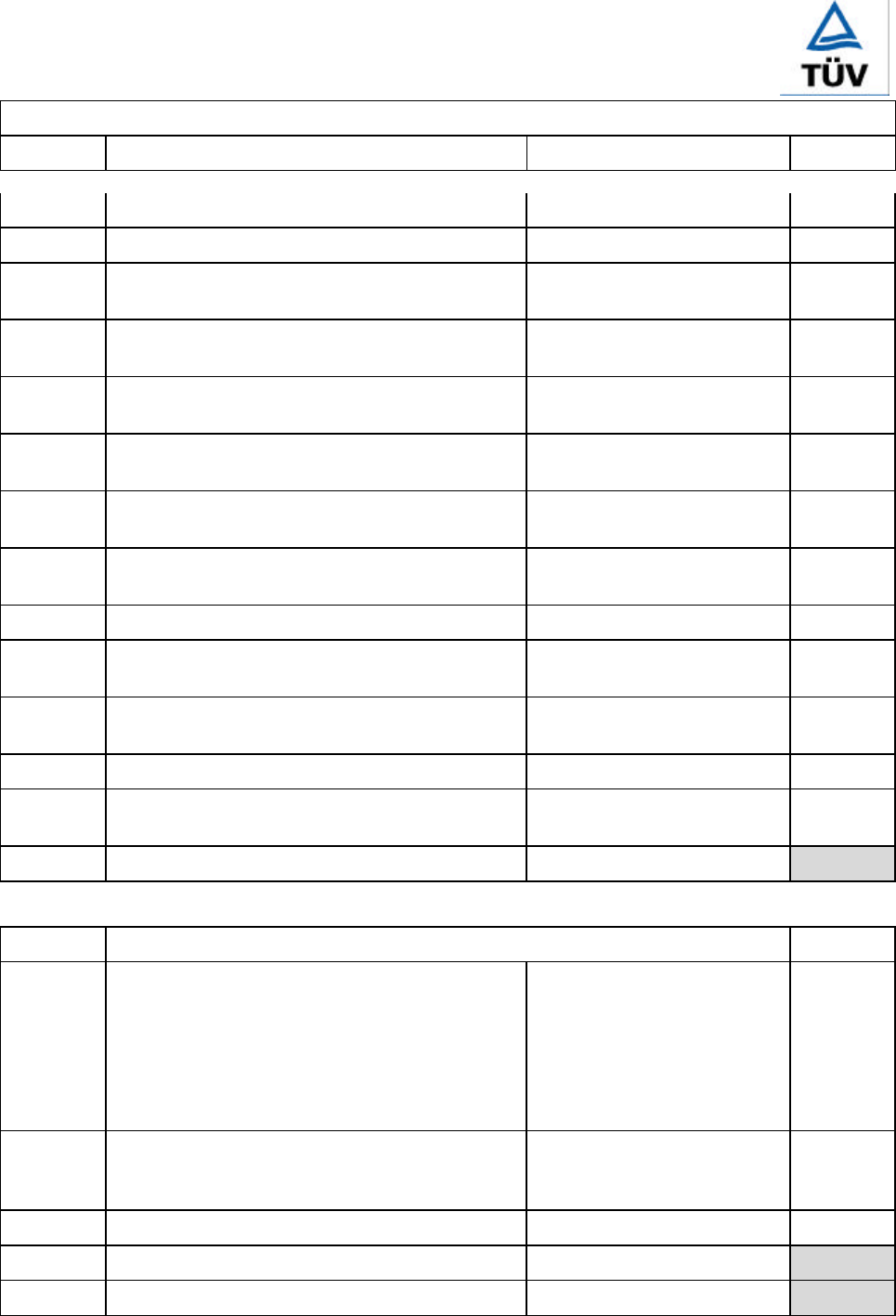
<12002388 001> Page 10
IEC 950
Clause Requirement − Test Result – Remark Verdict
TRF No.: I950___D TRF originator: FIMKO
Test with test finger .....................................:dto P
Test with test pin ........................................:dto P
2.1.3.1 Insulation of internal wiring in an ELV circuit
accessible to operator No ELV wiring in operator
accessible area. N
Working voltage (V); distance (mm) through
insulation ....................................................:N
2.1.3.2 Operator accessible insulation of internal wiring
at hazardous voltage No hazardous voltage wiring
in operator accessible area. N
2.1.4.1 Protection in service access areas No maintenance work in
operation mode necessary. N
2.1.4.2 Protection in restricted access locations It is not intended to be used
in restricted locations N
2.1.5 Energy hazard in operator access area The overall output of the SPS
is below 240VA. P
2.1.6 Clearances behind conductive enclosures Refer to 4.2. P
2.1.7 Shafts of manual controls None at ELV or hazardous
voltage N
2.1.8 Isolation of manual controls None at ELV or hazardous
voltage N
2.1.9 Conductive casings of capacitors In approved SPS. N
2.1.10 Risk of electric shock from stored charge on
capacitors connected to mains circuit In approved SPS. N
Time-constant (s); measured voltage (V) .........:—
2.2 Insulation P
2.2.1 Methods of insulation The insulation materials
provided in the equipment
with adequate thickness and
adequate creepage distance
over their surface and
clearance distance through
air.
P
2.2.2 Properties of insulating materials Natural rubber, asbestos or
hygroscopic materials are not
used
P
2.2.3 Humidity treatment Total time elapsed: 48 hrs P
Humidity (%) ...............................................:95% R.H.
Temperature (°C) .........................................:25°C
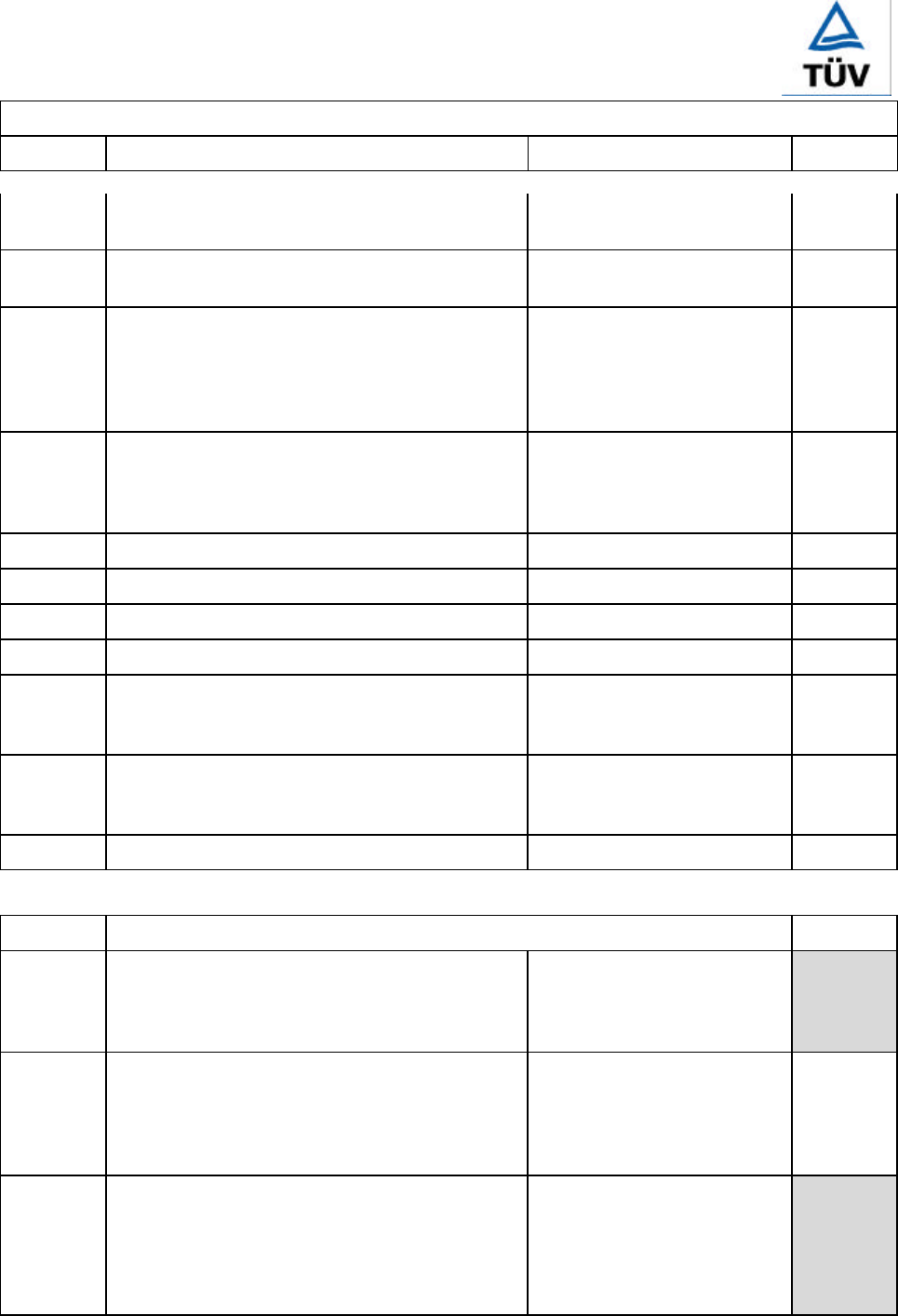
<12002388 001> Page 11
IEC 950
Clause Requirement − Test Result – Remark Verdict
TRF No.: I950___D TRF originator: FIMKO
2.2.4 Requirements for insulation Please refer to 5.3, 2.9 and
5.1. P
2.2.5 Insulation parameters Both parameters were
considered. P
2.2.6 Categories of insulation The adequate levels of safety
insulation is provided and
maintained to comply with
the requirements of this
standard.
P
2.2.7.1 General rules for working voltages The rms and the peak
voltages were measured on
the approved building-in
switching power supply.
P
2.2.7.2 Clearances in primary circuits Considered P
2.2.7.3 Clearances in secondary circuits
See clause 5.4.4.
N
2.2.7.4 Creepage distances Considered P
2.2.7.5 Electric strength tests Considered P
2.2.8.1 Bridging capacitors .......................................:No component bridged
reinforced or double
insulation.
N
2.2.8.2 Bridging resistors No component bridged
reinforced or double
insulation.
N
2.2.8.3 Accessible parts N
2.3 Safety extra-low voltage (SELV) circuits P
2.3.1 Voltage (V) of SELV circuits under normal
operating conditions and after a single fault .....:42.4V peak or 60VDC are
not exceeded in SELV circuit
under normal operation or
single fault condition
2.3.2 Voltage (V) between any two conductors of
SELV circuit(s) and for Class I equipment
between any conductor of SELV circuit and
equipment protective earthing terminal under
normal operating conditions ...........................:
Between any SELV circuits
42.4V peak or 60VDC are
not exceeded
P
2.3.3 Voltage (V) of SELV in the event of a single
failure of basic or supplementary insulation or of
a component ...............................................:
Single fault did not cause
excessive voltage in
accessible SELV circuits.
Limits of 71V peak and
120V DC were not exceed
and SELV limits not for
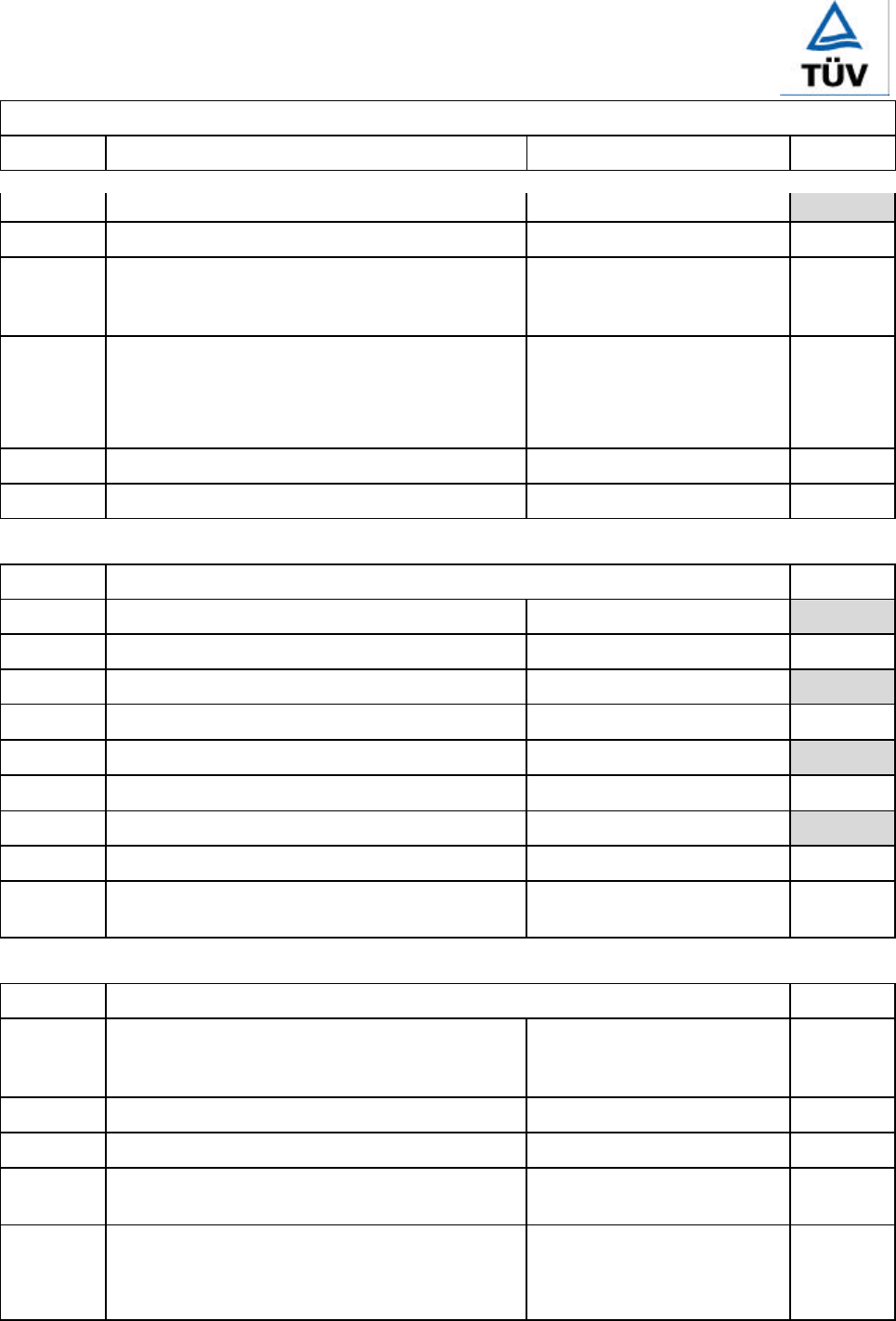
<12002388 001> Page 12
IEC 950
Clause Requirement − Test Result – Remark Verdict
TRF No.: I950___D TRF originator: FIMKO
longer than 0.2 seconds
Method used for separation ...........................:Method 1 P
2.3.4 Additional constructional requirements IEC 60083 and IEC 60320
connectors are not used in
SELV.
P
2.3.5 Connection of SELV circuits to other circuits See 2.3.2 and 2.3.3.
No direct connection
between SELV and any
primary circuits.
N
2.3.8 Construction of SELV circuits N
2.3.9 SELV circuits connected to other circuits N
2.4 Limited current circuits N
2.4.2 Frequency (Hz) ............................................:—
Measured current (mA) .................................:N
2.4.3 Measured voltage (V) ...................................:—
Measured capacitance (µF) ............................:N
2.4.4 Measured voltage (V) ...................................:—
Measured charge (µC) ...................................:N
2.4.5 Measured voltage (V) ...................................:—
Measured energy (mJ) ..................................:N
2.4.6 Limited current circuit supplied from or
connected to other circuits ............................:N
2.5 Provisions for earthing P
2.5.1 Class I equipment Basic insulated conductive
parts touchable in operator
area earthed reliably.
P
Warning label for service personnel N
2.5.2 Protective earthing in Class II equipment Class I equipment N
2.5.3 Switches/fuses in earthing conductors No switches or fuses in
earthing conductor. P
2.5.4 Assured earthing connection for Class I
equipment in systems comprising Class I and
Class II equipment
This unit has its own earthing
connection. Any other units
connected via the
interconnecting cable to other
P
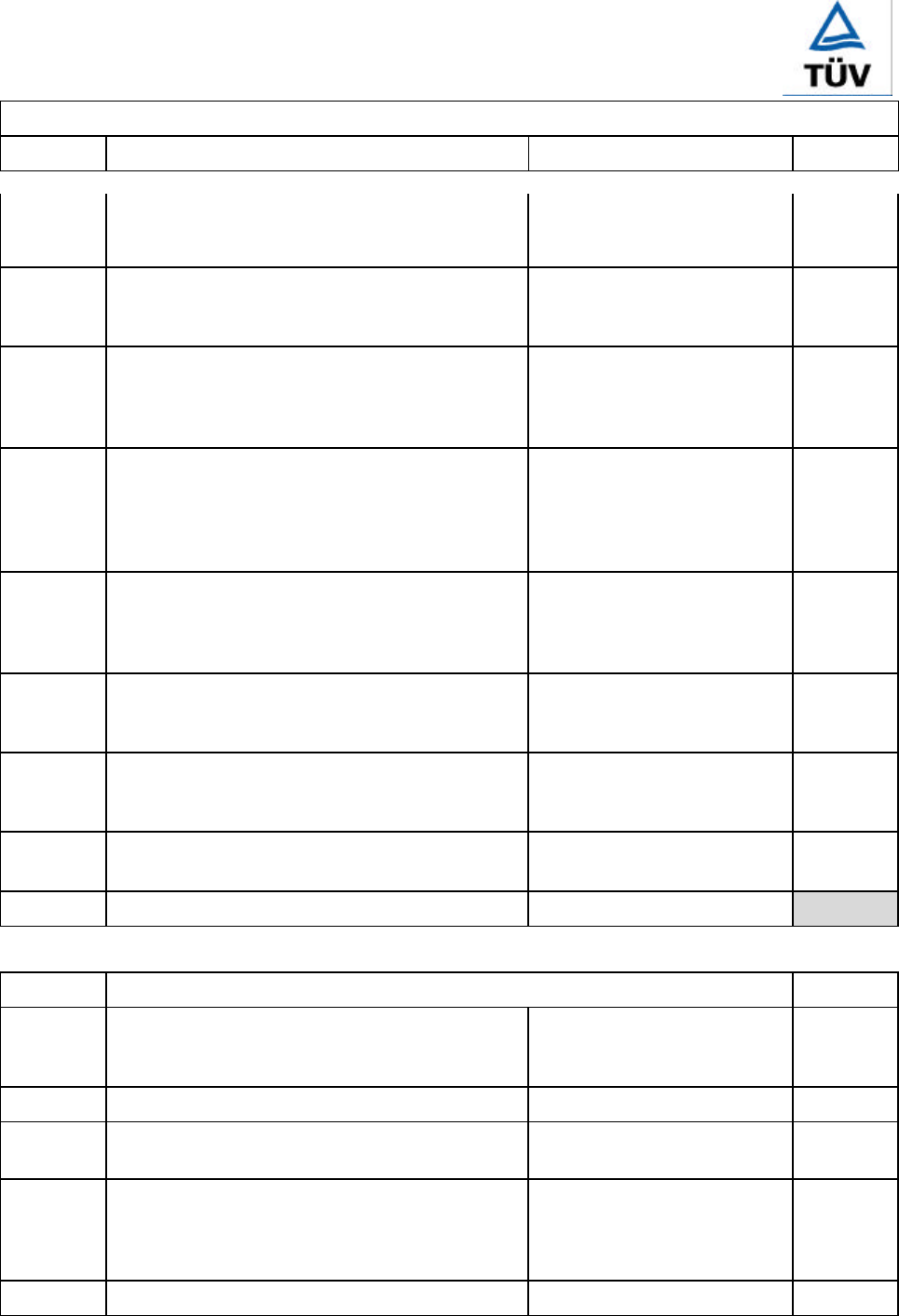
<12002388 001> Page 13
IEC 950
Clause Requirement − Test Result – Remark Verdict
TRF No.: I950___D TRF originator: FIMKO
unit shall provide SELV only.
The equipment does not
comprise class I and class II
2.5.5 Green/yellow insulation Green/yellow wire from inlet
to chassis in the approved
SPS.
P
2.5.6 Continuity of earth connections It is not possible to
disconnect earth without
disconnecting mains as an
appliance inlet is used.
P
2.5.7 Making and breaking of protective earthing
connections Plug or inlet, earthing
connected before and
disconnected after hazardous
voltage. No other operator
removable parts.
P
2.5.8 Disconnection protective earthing connections It is not necessary to
disconnect earthing except
for the removing of the
earthed parts itself
P
2.5.9 Protective earthing terminals for fixed supply
conductors or for non-detachable power supply
cords
N
2.5.10 Corrosion resistance All safety earthing
connections in compliance
with Annex J.
P
2.5.11 Resistance (O) of protective earthing conductors
≤ 0,1 O≤ 0.1Ω, see below. P
Test current (A) ...........................................:(see appended table)
2.6 Disconnection from primary power P
2.6.1 General requirements The appliance inlet is
considered to be the
disconnect device
P
2.6.2 Type of disconnect device .............................:Appliance inlet P
2.6.3 Disconnect device in permanently connected
equipment Pluggable equipment type A. N
2.6.4 Parts of disconnect device which remain
energized When plug or inlet is
disconnected no remaining
parts with hazardous voltage
in the equipment
P
2.6.5 Switches in flexible cords No isolation switch provided. N
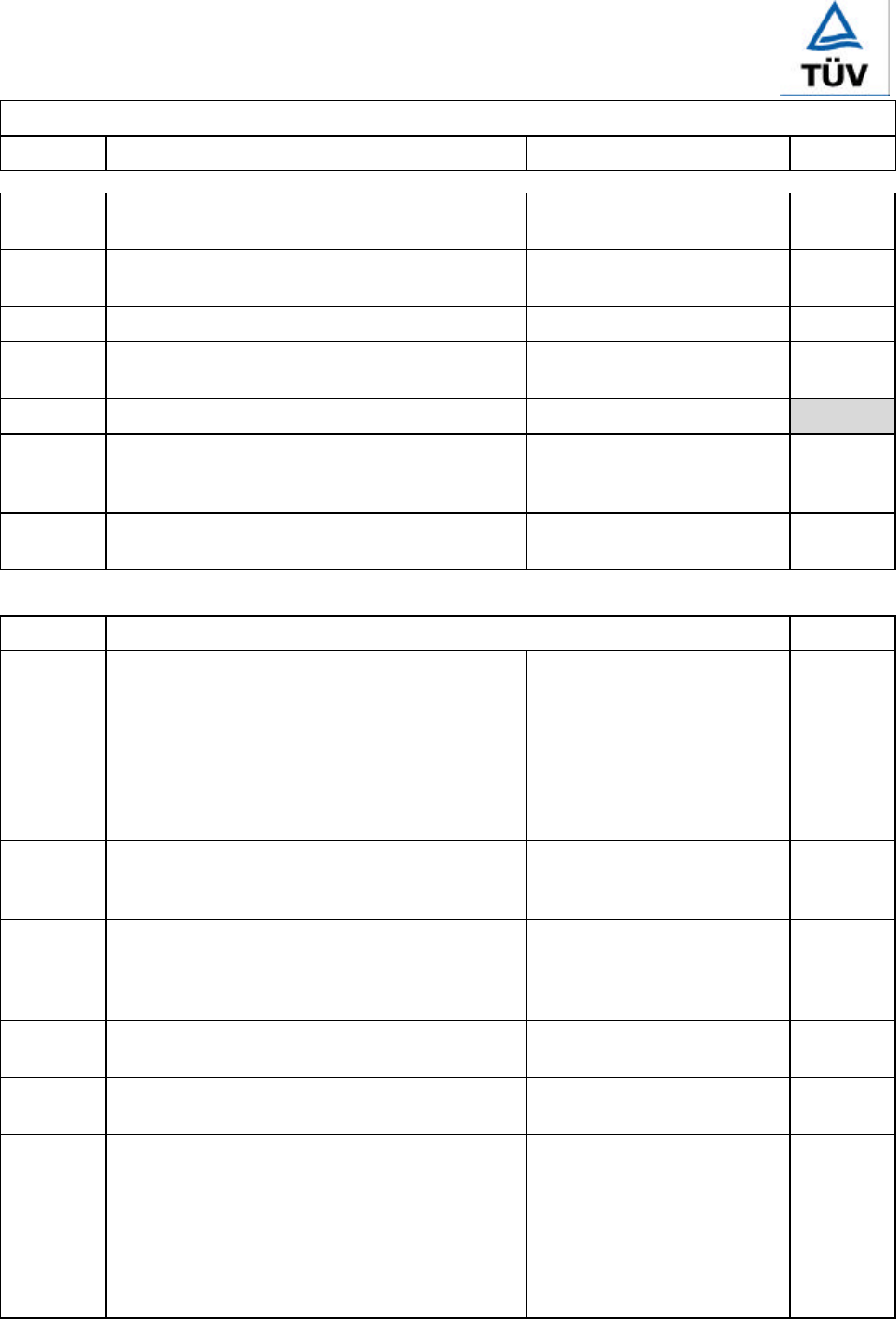
<12002388 001> Page 14
IEC 950
Clause Requirement − Test Result – Remark Verdict
TRF No.: I950___D TRF originator: FIMKO
2.6.6 Disconnection of both poles simultaneously in
single-phase equipment The plug or inlet disconnects
both poles simultaneously. P
2.6.7 Disconnection of all phase conductors of supply
in three-phase equipment Single phase N
2.6.8 Marking of switch acting as disconnect device N
2.6.9 Installation instructions if plug on power supply
cord acts as disconnect device N
Language ....................................................:
2.6.11 Interconnected equipment Certified plug or inlet,
earthing connected before
phases are connected
P
2.6.12 Multiple power sources Only one supply connection
provided. N
2.7 Overcurrent and earth fault protection in primary circuits P
2.7.1 Basic requirements Equipment relies on 16A
rated fuse or circuit breaker
of the wall outlet installation
protection of the building
installation in regard to L to N
short circuit. Overcurrent
protection is provided by the
built-in device fuse in SPS.
P
2.7.2 Protection against faults not covered in 5.4 The protection devices are
well dimensioned and
mounted.
P
2.7.3 Short-circuit backup protection Pluggable equipment type A,
the building installation is
considered as providing short
circuit protection
P
2.7.4 Number and location of protective devices ......:Overcurrent protection by one
built-in fuse in approved SPS. P
2.7.5 Protection by several devices Only one fuse in approved
SPS. N
2.7.6 Warning to service personnel With reversible type plug to
the mains, hazardous voltage
may be still presented in the
equipment after the internal
fuse opens. However, as it is
considered that the plug to
the mains will be
disconnected during service
P
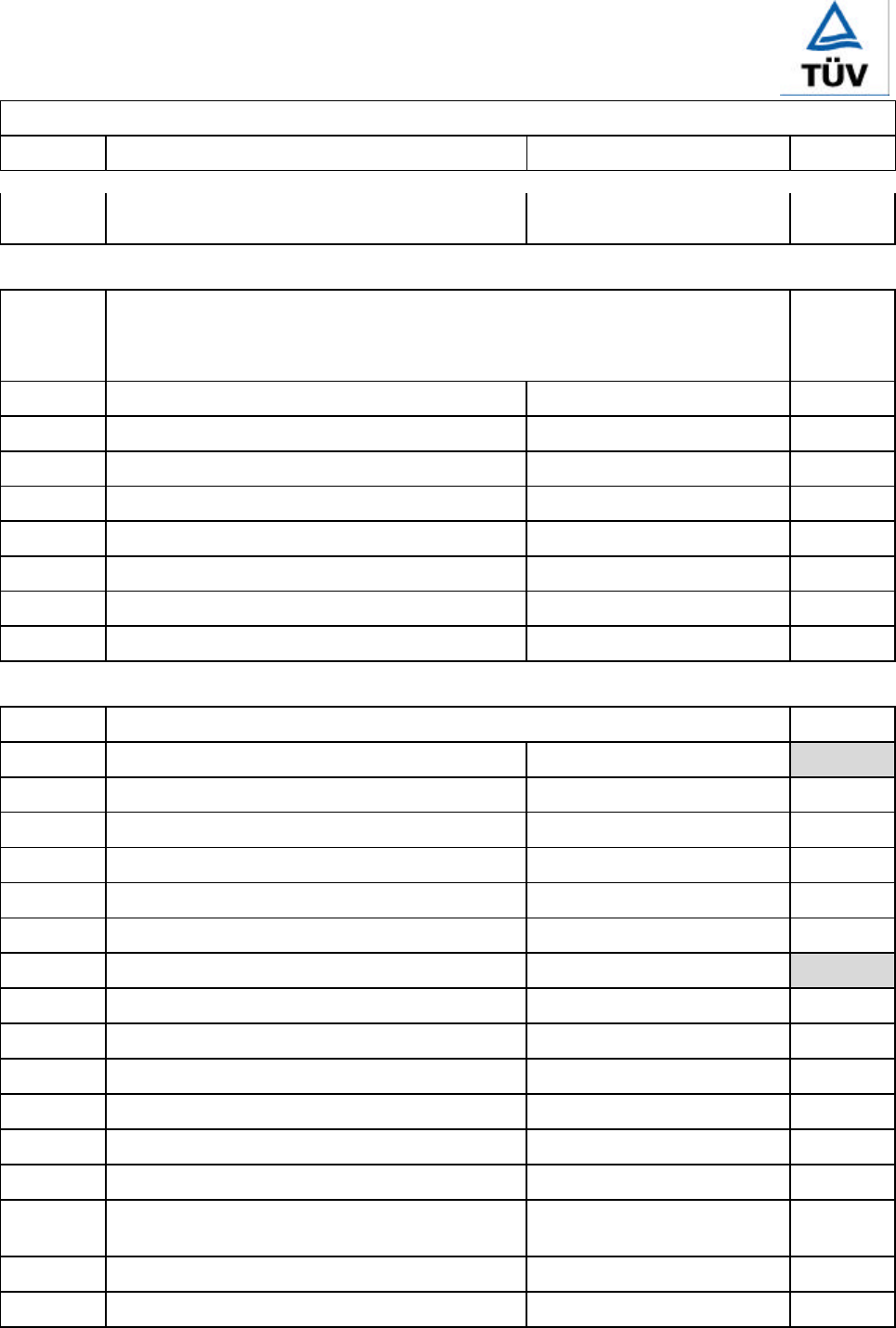
<12002388 001> Page 15
IEC 950
Clause Requirement − Test Result – Remark Verdict
TRF No.: I950___D TRF originator: FIMKO
work, no marking were
requested.
2.8 Safety interlock
No operator accessible areas which presents hazards in the meaning of this
standard.
N
2.8.2 Design N
2.8.3 Protection against inadvertent reactivation N
2.8.4 Reliability N
2.8.5 Overriding an interlock N
2.8.6.1 Contact gap (mm) ........................................:N
2.8.6.2 Switch performing 50 cycles N
2.8.6.3 Electric strength test: test voltage (V) .............:N
2.8.7 Protection against overstress N
2.9 Clearances, creepage distances and distances through insulation P
Nominal voltage (V) ......................................:AC 100-240V
General P
2.9.2 Clearances See below P
2.9.2.1 Clearances in primary circuits All in approved SPS. P
2.9.2.2 Clearances in secondary circuits
See clause 5.4.4.
N
2.9.3 Creepage distances In approved SPS. P
CTI tests .....................................................:
2.9.4.1 Minimum distances through insulation In approved SPS. P
2.9.4.2 Thin sheet material In approved SPS. P
Number of layers (pcs) ..................................:P
Electrical strength test: test voltage (V) ..........:P
2.9.4.3 Printed boards Not applied for N
Distance through insulation N
Electric strength test at voltage for thin sheet
insulating material N
Number of layers (pcs) ..................................:N
2.9.4.4 Wound components without interleaved No wound components N
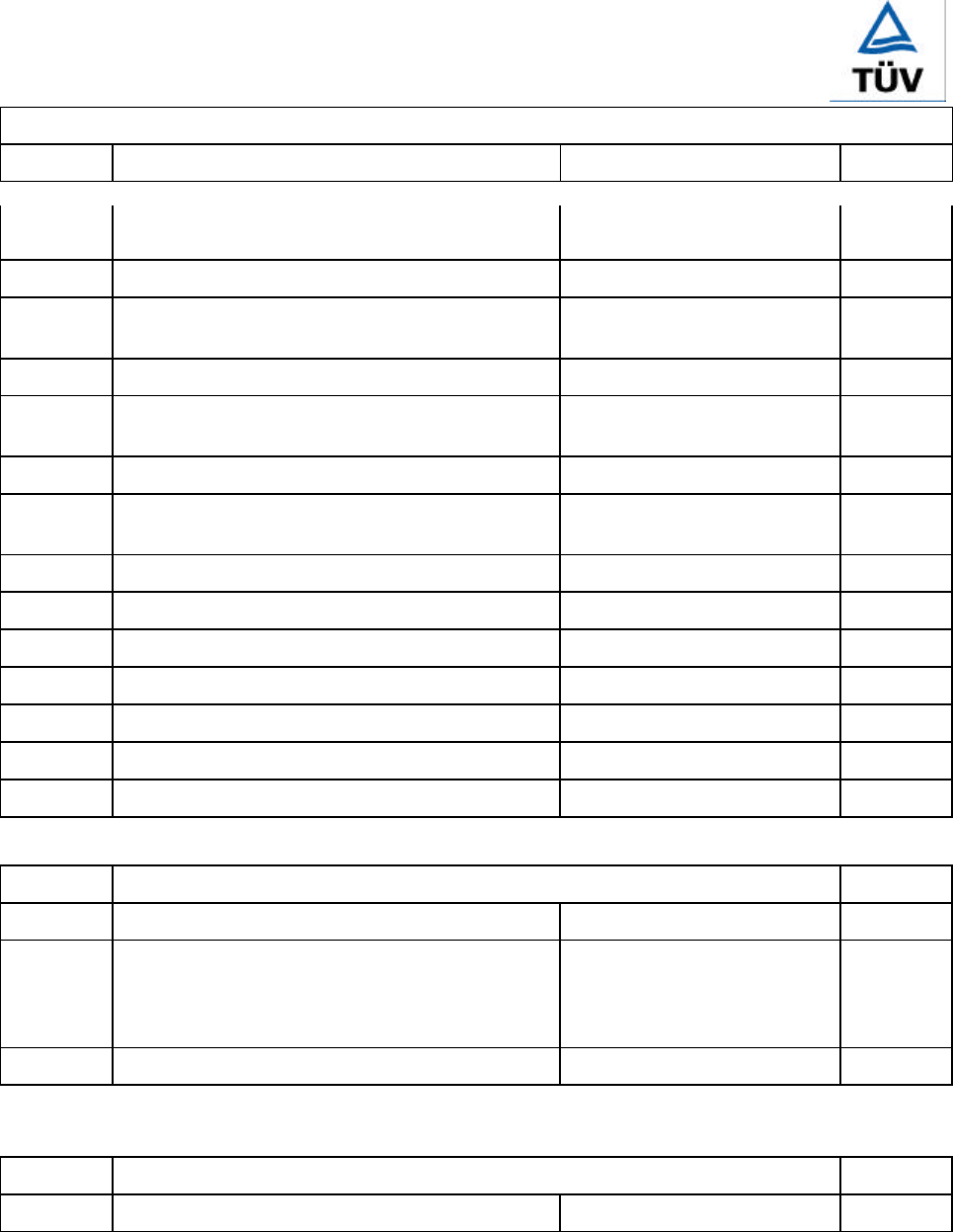
<12002388 001> Page 16
IEC 950
Clause Requirement − Test Result – Remark Verdict
TRF No.: I950___D TRF originator: FIMKO
insulation without interleaved
insulation.
Number of layers (pcs) ..................................:N
Two wires in contact inside component;
angle between 45° and 90°N
Routine testing for finished component N
2.9.5 Distances on coated printed boards No coated printed wiring
boards. N
Routine testing for electric strength N
2.9.6 Enclosed and sealed parts No hermetically sealed
components. N
Temperature T1 (°C) .....................................:N
Humidity % .................................................:N
2.9.7 Spacings filled by insulating compound In approved SPS. P
Temperature T1 (°C) .....................................:N
Humidity % .................................................:N
2.9.8 Component external terminations In approved SPS. P
2.9.9 Insulation with varying dimensions Insulation kept homogenous. N
2.10 Interconnection of equipment P
2.10.1 General requirements See below. N
2.10.2 Type of interconnection circuits .....................:Interconnection circuits of
SELV through the
connectors. No ELV
interconnection circuits.
P
2.10.3 ELV circuits as interconnection circuits No ELV interconnection. N
2.11 Limited power source N
Use of limited power source ..........................:Supplied from the mains. N
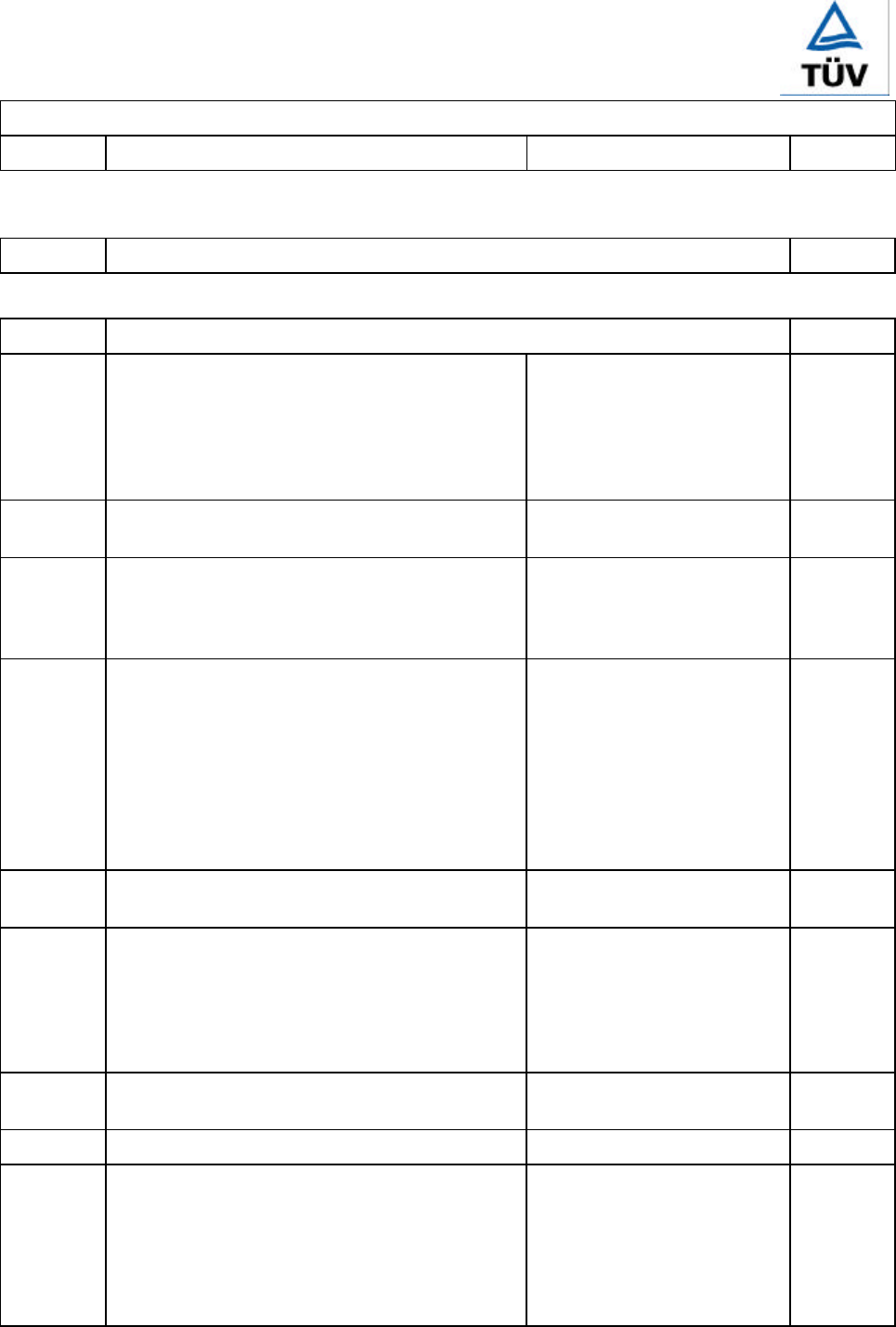
<12002388 001> Page 17
IEC 950
Clause Requirement − Test Result – Remark Verdict
TRF No.: I950___D TRF originator: FIMKO
3WIRING, CONNECTIONS AND SUPPLY P
3.1 General P
3.1.1 Cross-sectional area of internal
wiring/interconnecting cables All internal wires are UL
recognized wiring that is PVC
insulated, rated VW-1, min.
80°C, 300V. Internal wiring
gauge is suitable for current
intended to be carried.
P
Protection of internal wiring and interconnecting
cables No internal wire for primary
power distribution. N
3.1.2 Wireways Wires do not touch sharp
edges and heatsinks which
could damage the insulation
and cause hazard.
P
3.1.3 Fixing of internal wiring Internal wires with only basic
isolation are routed so that
they are not close to any live
bare components. The wires
are secured by solder pins
and quick connect terminals
so that a loosening of the
terminal connection is
unlikely.
P
3.1.4 Fixing of uninsulated conductors Securely held on PCB. No
hazard. P
3.1.5 Insulation of internal wiring The insulation of the
individual conductors are
suitable for the application
and the working voltage. For
the insulation material see
3.1.1.
P
3.1.6 Wires coloured green/yellow only for protective
earth connection See 2.5.5. P
3.1.7 Fixing of beads and similar ceramic insulators Not used. N
3.1.8 Required electrical contact pressure Electrical and earthing
connections screwed two or
more complete threads into
metal. No screws of
insulating material for
electrical and earthing
connections, or where
P
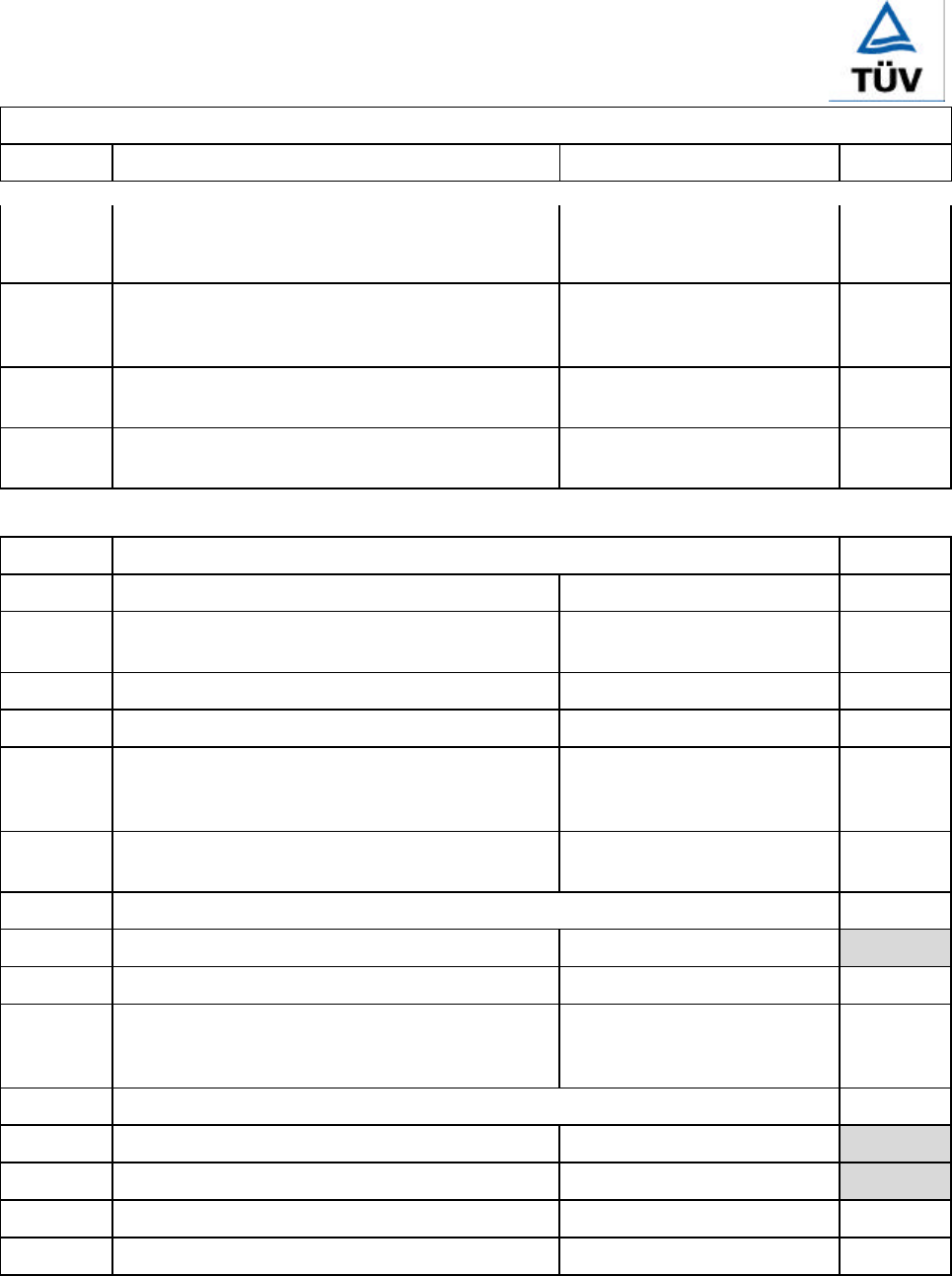
<12002388 001> Page 18
IEC 950
Clause Requirement − Test Result – Remark Verdict
TRF No.: I950___D TRF originator: FIMKO
supplementary or reinforced
insulation could be impaired
by a metal replacement.
3.1.9 Reliable electrical connections All current carrying and
safety earthing connections
are metal to metal
P
3.1.10 End of stranded conductor No risk of stranded
conductors coming loose. P
3.1.11 Use of spaced thread screws/thread-cutting
screws No self tapping screws are
used. P
3.2 Connection to primary power P
3.2.1 Type of connection ......................................:Appliance inlet. P
Design of product with more than one supply
connection ..................................................:Only one mains supply
connection. N
3.2.2 Provision for permanent connection ................:Not permanently connected. N
Size (mm) of cables and conduits ...................:N
3.2.3 Appliance inlet The appliance inlet complies
with IEC 60320 and is
located at the rear of the unit.
P
3.2.4 Type and cross-sectional area (mm²) of power
supply cord .................................................:Not provided. N
3.2.5 Cord anchorage N
Test: 25 times; 1 s; pull (N) ..........................:
Longitudinal displacement ≤ 2 mm ..................:N
3.2.6 Protection of power supply cord No parts under this unit likely
to damage the power supply
cord. No sharp edges.
P
3.2.7 Cord guard N
D (mm) .......................................................:
Test: mass (g) .............................................:
Radius of curvature of the cord ≤ 1,5 D N
3.2.8 Supply wiring space N
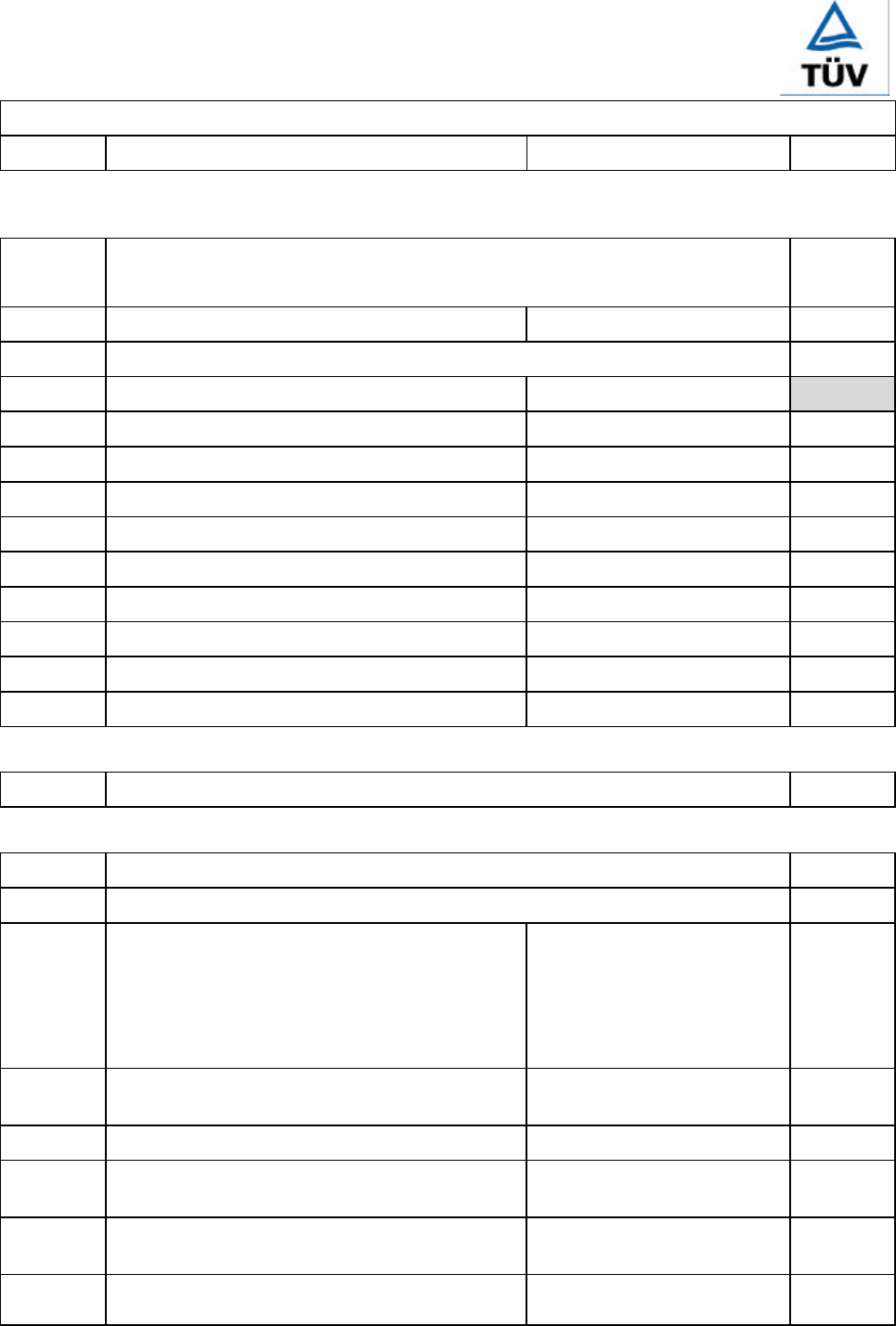
<12002388 001> Page 19
IEC 950
Clause Requirement − Test Result – Remark Verdict
TRF No.: I950___D TRF originator: FIMKO
3.3 Wiring terminals for external power supply conductors
Unit with detachable power supply cord, connected on appliance inlet.
N
3.3.1 Terminals N
3.3.2 Special non-detachable cord N
Type of connection ......................................:—
Pull test at 5 N N
3.3.3 Screws and nuts N
3.3.4 Fixing of conductors N
3.3.5 Connection of connectors N
3.3.6 Size of terminals N
Nominal thread diameter (mm) .......................:N
3.3.7 Protection against damage of conductors N
3.3.8 Terminal location N
3.3.9 Test with 8 mm stranded wire N
4PHYSICAL REQUIREMENTS P
4.1 Stability and mechanical hazards P
4.1.1 Stability tests P
Angle of 10°This appliance is of a stable
mechanical construction and
does not overbalance when
tilted to an angle of 10°
from its normal upright
position.
P
Test: force (N) .............................................:Equipment is not a
floorstanding unit. N
4.1.2 Protection against personal injury No hazardous moving part P
4.1.3 Warning and means provided for stopping the
moving part .................................................:No hazardous moving parts. N
4.1.4 Edges and corners Edges and corners of the
enclosure are rounded P
4.1.5 Enclosure of a high pressure lamp No lamp with cold pressure
of 0.2MPa or hot pressure N
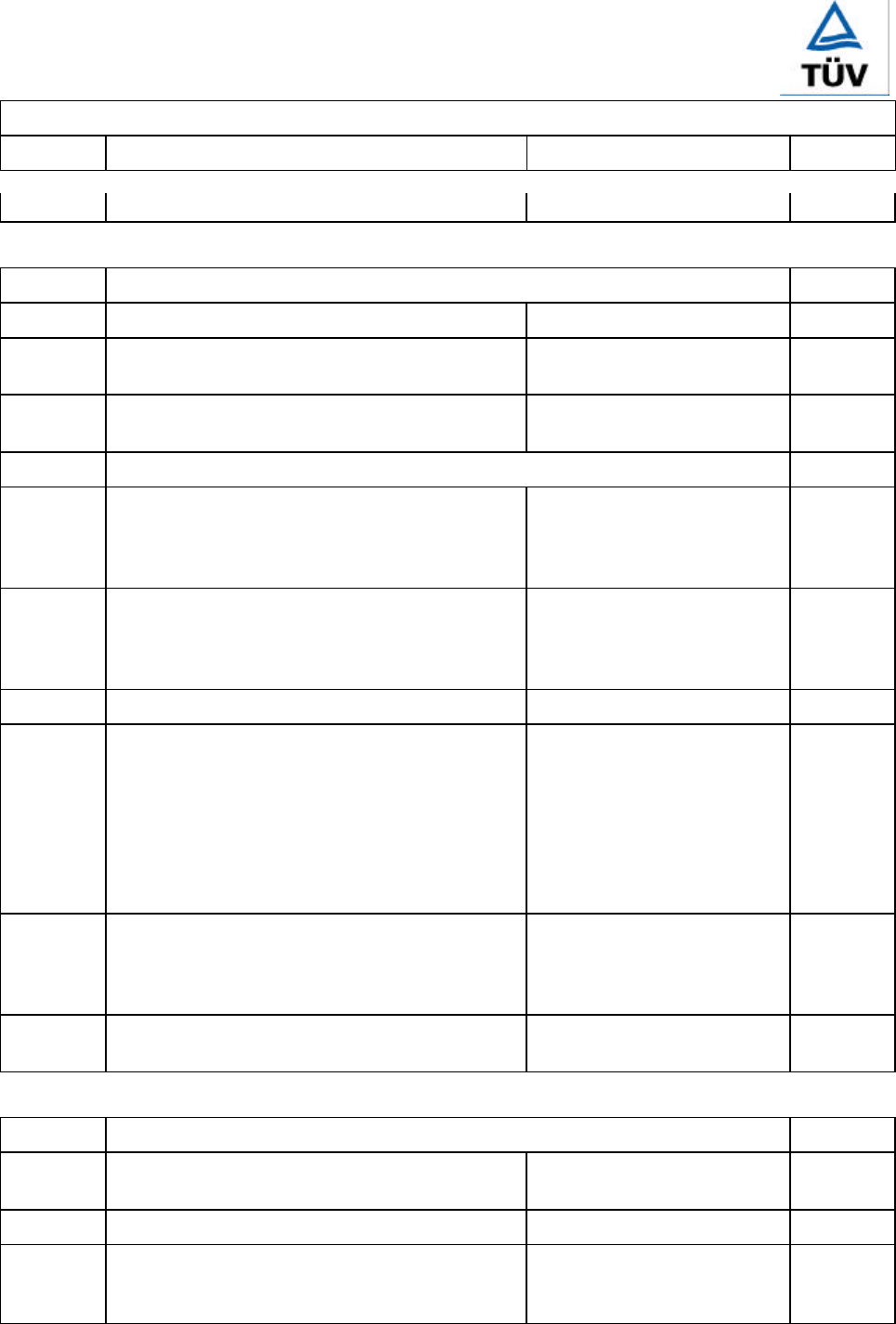
<12002388 001> Page 20
IEC 950
Clause Requirement − Test Result – Remark Verdict
TRF No.: I950___D TRF originator: FIMKO
0.4MPa.
4.2 Mechanical strength and stress relief P
4.2.1 General P
4.2.2 Internal enclosures 30 N ± 3 N; 5 s 30N force tested on internal
enclosure (SPS). P
4.2.3 External enclosures 250 N ± 10 N; 5 s 250N applied to outer
enclosure. P
4.2.4 Steel ball tests P
Fall test 500g steel sphere ball fall,
from 1.3m height onto
enclosure near power supply
circuit.
P
Swing test 500g steel sphere ball as
pendulum onto enclosure near
power supply circuit. No
safety relevant damages.
P
4.2.5 Drop test Not a hand-held equipment. N
4.2.6 Heat test for enclosures of moulded or formed
thermoplastic materials: 7 h; T (°C) ................:Hazardous voltages are
contained in the approved
SPS. As the SPS is complete
enclosed by an earthed metal
enclosure which meets the
requirements of 2.1.2, the
oven test is not considered to
be necessary.
N
4.2.7 Compliance criteria No safety relevant damages
to impact the requirements of
2.1.2, 2.1.5, 2.5.1, 2.5.2,
2.9, 3.2.5, 4.1.2 and 6.2.2.
P
4.2.8 Mechanical strength of cathode ray tubes Unit does not employ a
cathode ray tube N
4.3 Construction details P
4.3.1 Changing of setting for different power supply
voltages Auto voltage select design. N
4.3.2 Adjustment of accessible control devices No control device. N
4.3.4 Prevention of dangerous concentration of dust,
powder, liquid and gas Equipment in intended use
not considered to be exposed
to these.
N
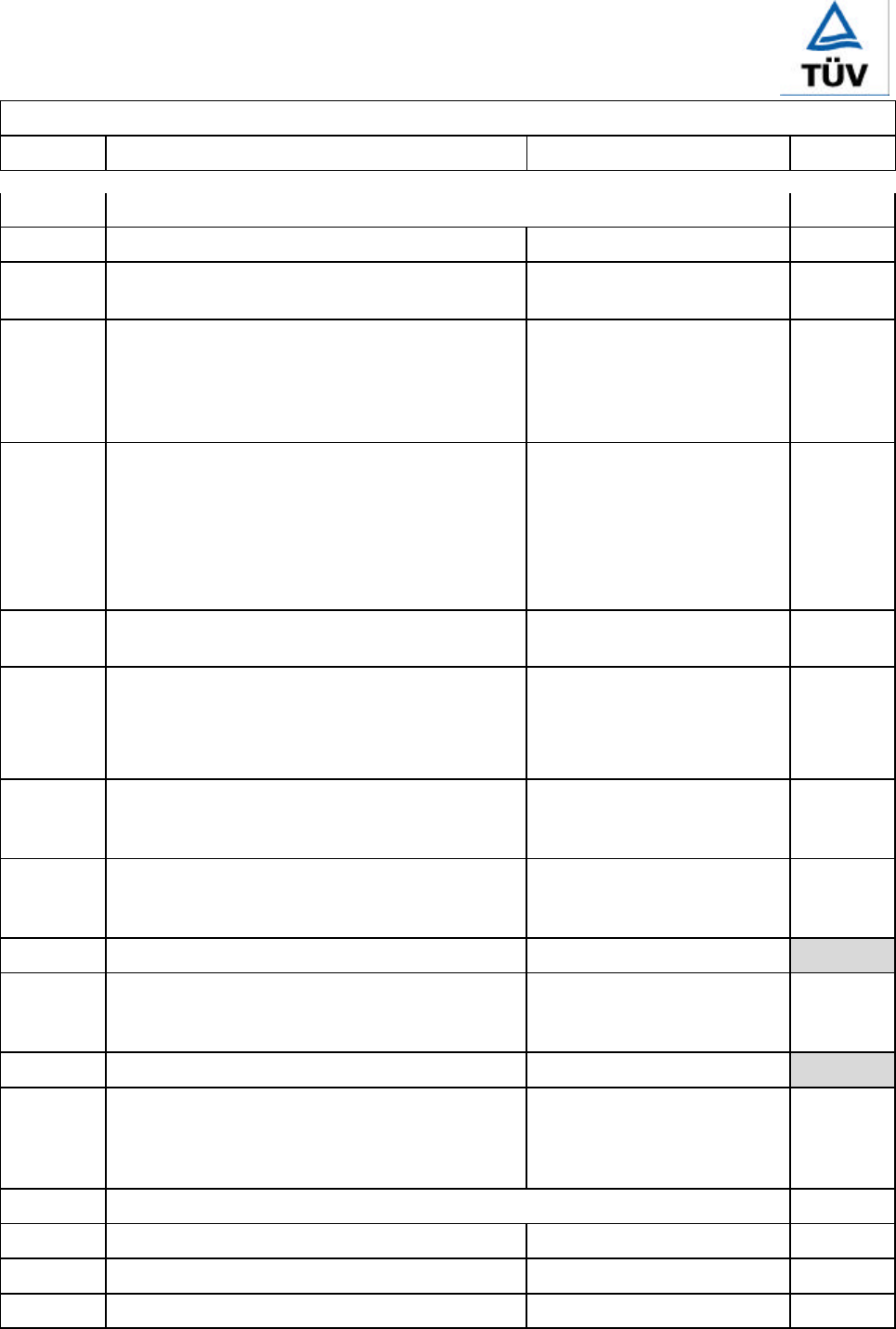
<12002388 001> Page 21
IEC 950
Clause Requirement − Test Result – Remark Verdict
TRF No.: I950___D TRF originator: FIMKO
4.3.5 Fixing of knobs, grips, handles, levers N
Test: force (N) .............................................:N
4.3.6 Driving belts/couplings shall not ensure electrical
insulation Not used for insulation. N
4.3.7 Retaining of sleeves Sleevings on wiring reliable
kept in position by cable ties
or by the use of heatshrunk
sleeving. No sleeving used as
supplementary insulation.
N
4.3.9 Protection of loosening parts Electrical and mechanical
connections can be expected
to withstand usual
mechanical stress. For the
protection, solder pins, cable
ties and heatshrunk tubing
are used.
P
4.3.11 Resistance to oil and grease Insulation not in contact with
oil or grease N
4.3.12 Protection against harmful concentration of
ionizing radiation, ultraviolet light, laser or
flammable gases (for laser see IEC 825-1)
No ionizing radiation or
flammable liquids presents.
The LED power is far below
LED class 1 limit.
P
4.3.13 Securing of screwed connections No connection likely to be
exposed to mechanical stress
are provided in unit.
P
4.3.15 Openings in the top of enclosure No bare parts at hazardous
voltage directly over the
openings.
P
Dimensions (mm) .........................................:(see appended table)
4.3.16 Openings in the sides of enclosure No bare parts at hazardous
voltage within 5° projectary
areas.
P
Dimensions (mm) .........................................:(see appended table)
4.3.17 Interchangeable plugs and sockets In operator and service area,
mismate of connectors were
prevented by incompatible
form or location.
P
4.3.18 Torque test for direct plug-in equipment N
Additional torque (Nm) ..................................:N
4.3.19 Protection against excessive pressure N
4.3.20 Protection of heating elements in Class I No heating elements. N
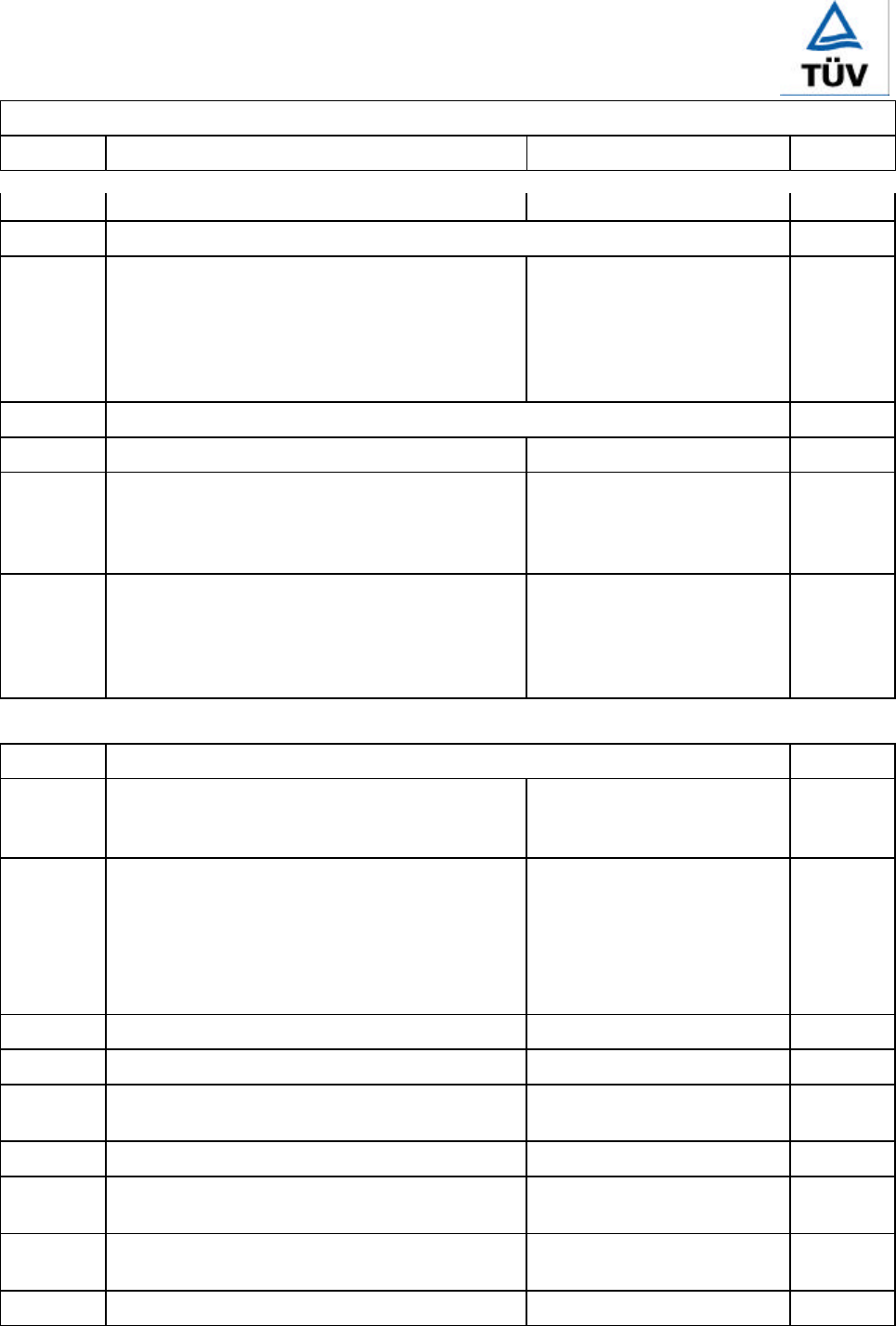
<12002388 001> Page 22
IEC 950
Clause Requirement − Test Result – Remark Verdict
TRF No.: I950___D TRF originator: FIMKO
equipment
4.3.21 Protection of lithium batteries P
Construction of protection circuit ...................:For RTC battery:
a) Prevent from force
charging by D1 and R63.
b) Reverse polarity
installation is impossible.
P
4.3.22 Ageing of barrier/screen secured with adhesive N
Day 1: temperature (°C); time (weeks) ............:N
Day 8/22/57:
a) temperature (°C) for 1 h
b) temperature (°C) for 4 h
c) temperature (°C) over 8 h ..........................:
N
Day 9/23/58:
a) relative humidity (%) for 72 h
b) temperature (°C) for 1 h
c) temperature (°C) for 4 h
d) temperature (°C) over 8 h ..........................:
N
4.4 Resistance to fire P
4.4.1 Methods of achieving resistance to fire Use of materials with the
required flammability
classes.
P
4.4.2 Minimizing the risk of ignition Electrical parts are not likely
to ignite nearby materials.
Parts not protected against
overheating under fault
conditions.
Temperatures see 5.1.
P
Printed board: manufacturer; type; flammability :See 1.5.1 appended table P
4.4.3 Flammability of materials and components See below. P
4.4.3.2 Material and component: manufacturer; type;
flammability ................................................:Internal components except
small parts are V-2 or better. P
4.4.3.3 Exemptions .................................................:Considered. P
4.4.3.4 Wiring harnesses: manufacturer; flammability ..:Insulating material consists
of PVC. P
4.4.3.5 Cord anchorage bushings: manufacturer;
flammability ................................................:No cord anchorage. N
4.4.3.6 Air filter assemblies: manufacturer; flammability :No air filter assemblies N
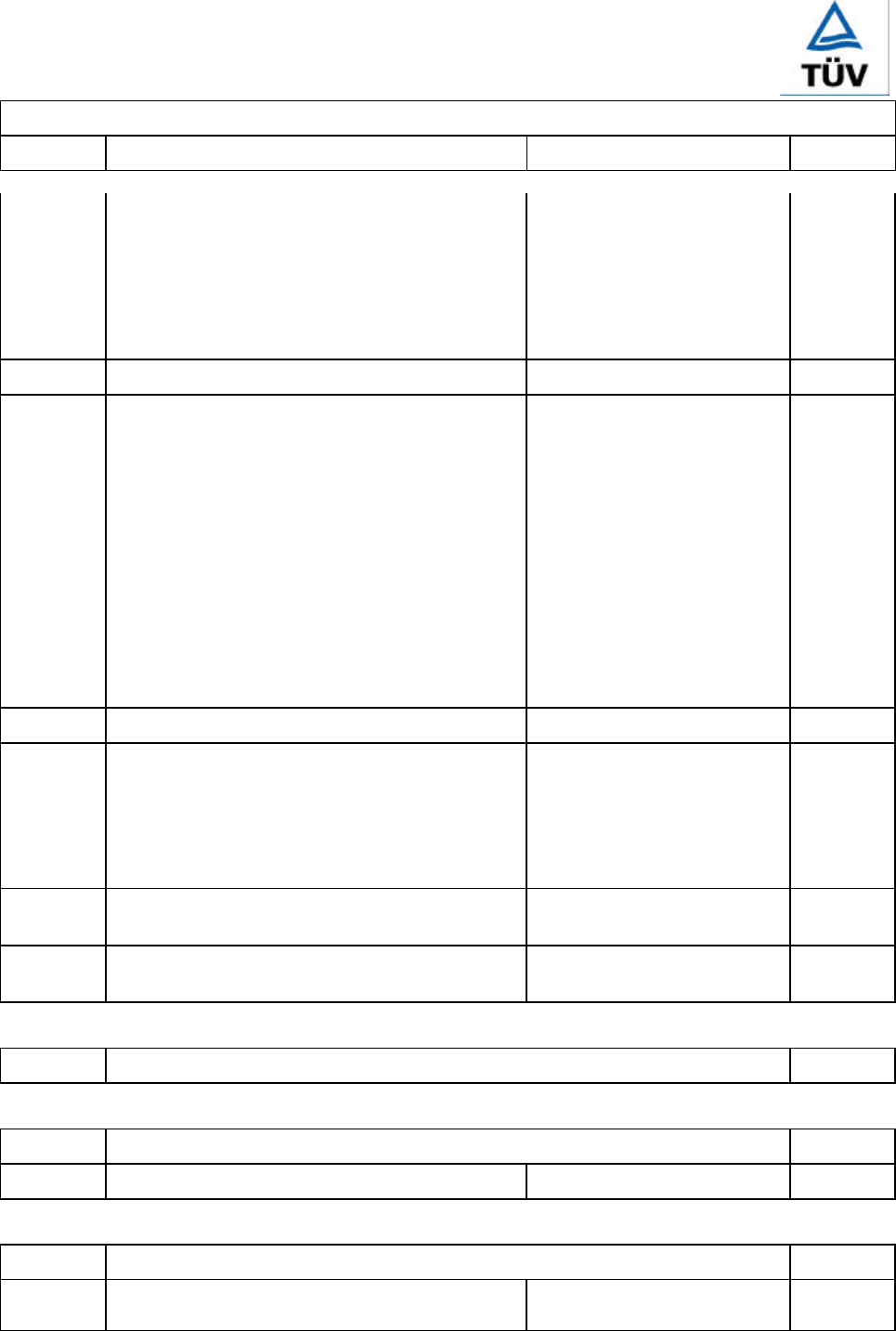
<12002388 001> Page 23
IEC 950
Clause Requirement − Test Result – Remark Verdict
TRF No.: I950___D TRF originator: FIMKO
4.4.4 Enclosures and decorative parts: manufacturer;
type; flammability
........................................
:
Protective metal enclosure
with decorative front plastic
panel and cover. The front
panel and cover assumed as
decorative part with the
flammability class HB was
acceptable.
P
4.4.5 Conditions for fire enclosures See 4.4.5.1 P
4.4.5.1 Components requiring fire enclosure:
manufacturer; flammability ............................:With having the following
components:
n components with
windings
n wiring
n semiconductor devices,
transistors, diodes,
integrated circuits
n resistors, capacitors,
inductors
the fire enclosure is required.
P
4.4.5.2 Components not requiring fire enclosure ..........:See 4.4.5.1 N
4.4.6 Fire enclosure construction Protection against emission
of flame, molten metal,
flaming or glowing particles
or drops by the fire enclosure
without bottom openings.
(see appended table)
P
4.4.7 Doors or covers in fire enclosures No door or cover within fire
enclosure. N
4.4.8 Flammable liquids No flammable liquids in this
unit. N
5THERMAL AND ELECTRICAL REQUIREMENTS P
5.1 Heating P
Heating tests (see appended table) P
5.2 Earth leakage current P
5.2.1 General The leakage current was
measured from primary to P
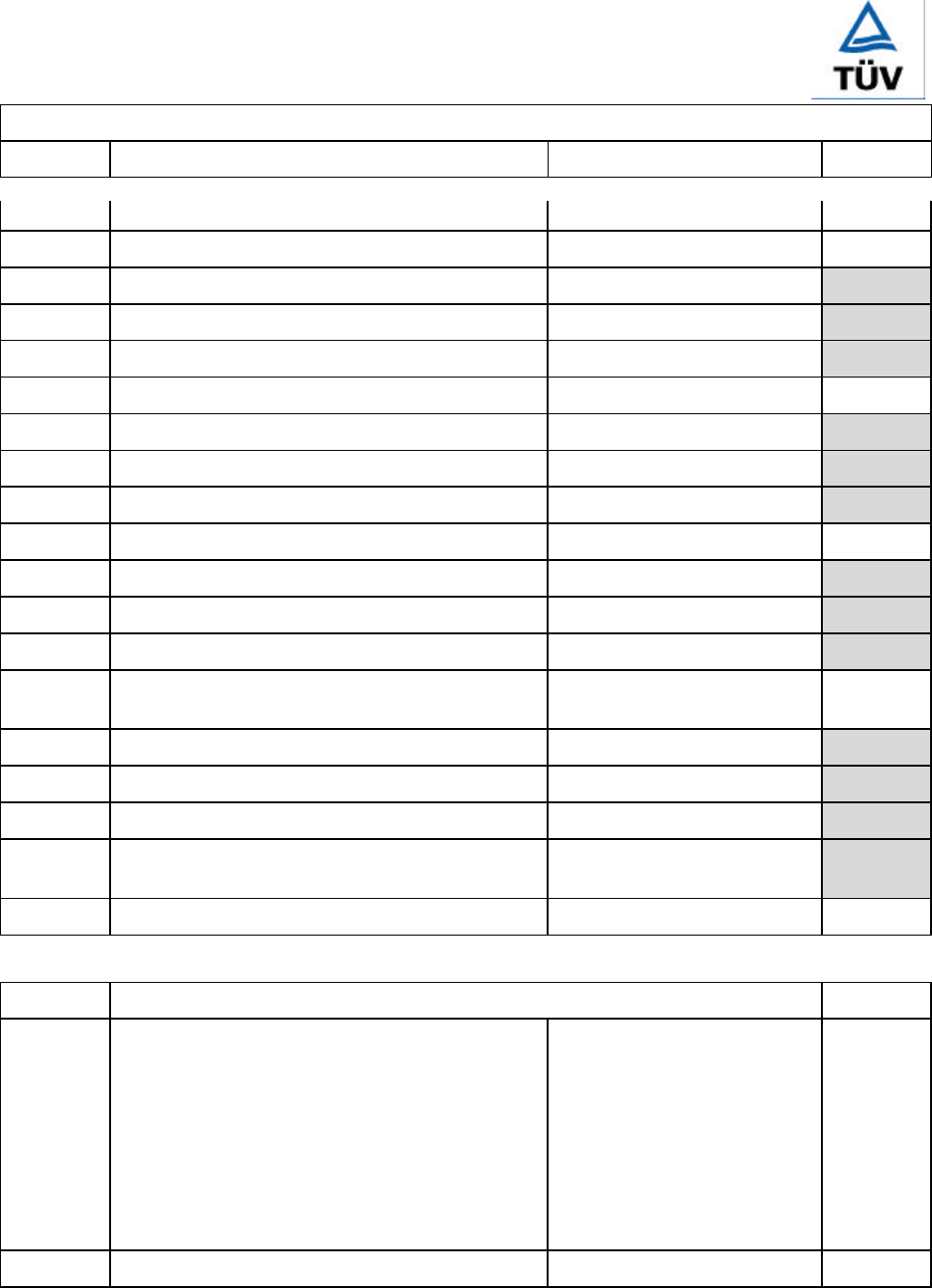
<12002388 001> Page 24
IEC 950
Clause Requirement − Test Result – Remark Verdict
TRF No.: I950___D TRF originator: FIMKO
chassis.
5.2.2 Leakage current (see attached tables) P
Test voltage (V) ...........................................:(see attached tables) P
Measured current (mA) .................................:(see attached table)
Max. allowed current (mA) ............................:3.5mA
5.2.3 Single-phase equipment See 5.2.2 P
Test voltage (V) ...........................................:
Measured current (mA) .................................:
Max. allowed current (mA) ............................:3.5mA
5.2.4 Three-phase equipment Single phase equipment N
Test voltage (V) ...........................................:
Measured current (mA) .................................:
Max. allowed current (mA) ............................:
5.2.5 Equipment with earth leakage current exceeding
3,5 mA Leakage current does not
exceed 3.5mA N
Test voltage (V) ...........................................:
Measured current (mA) .................................:
Max. allowed current (mA) ............................:
Cross-sectional area (mm²) of internal protective
earthing conductor .......................................:
Warning label N
5.3 Electric strength P
5.3.1 General All tests voltages were
applied for 1 minute in the
chamber after the humidity
test of 2.2.3 and in warm
conditions after the heating
test of 5.1.
No isolation breakdown was
observed (results see
appended tables).
P
5.3.2 Test procedure (see appended table) P
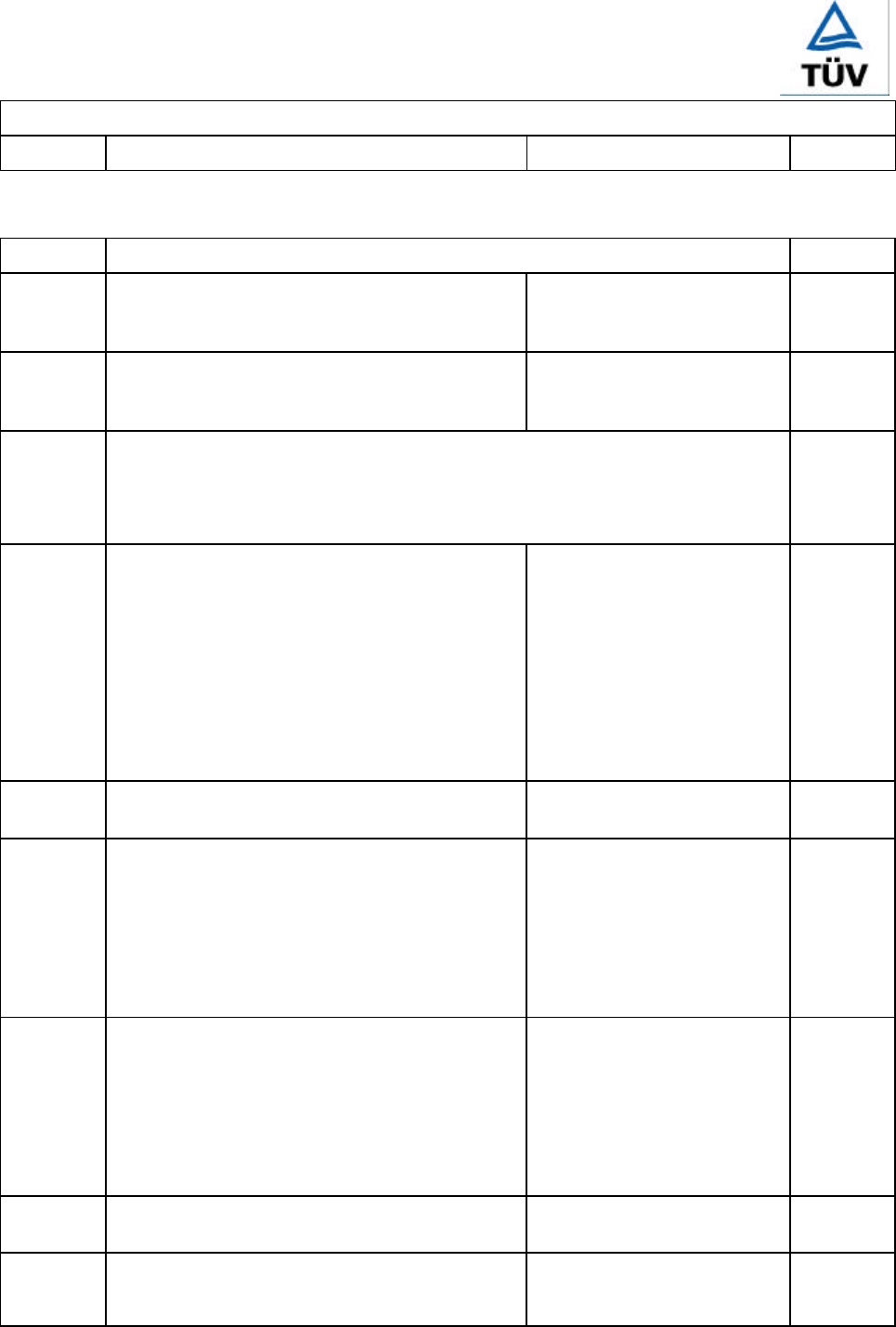
<12002388 001> Page 25
IEC 950
Clause Requirement − Test Result – Remark Verdict
TRF No.: I950___D TRF originator: FIMKO
5.4 Abnormal operating and fault conditions P
5.4.2 Motors Non-approved components
used. Results see annex B
and table 5.4.
P
5.4.3 Transformers The protection of the SPS
and transformer are approved
with the approval of the SPS.
P
5.4.4 Compliance of operational insulation
Power supply is approved component, the over-current protection of the power
supply ensures that there occur no hazard if there is short circuit in the SELV
circuit.
P
Method used ...............................................:Method c) considered. Due to
• all components are
mounted on PCB of
flammability class V-1
• wiring is insulated by
PVC
• no risk of electrical shock
No test had been performed.
N
5.4.5 Electromechanical components in secondary
circuits No electromechanical
components. N
5.4.6 Other components and circuits Faults in primary and
secondary components and
operational insulation were
already considered during the
approval of the SPS.
No other abnormal tests
necessary.
N
5.4.7 Test in any expected condition and foreseeable
misuse Ventilation blocked and DC
fan locked test: Results see
appended table.
No hazard by operating
buttons and controls not in
accordance with the
instructions.
P
5.4.8 Unattended use of equipment having
thermostats, temperature limiters etc. None of them are used. N
5.4.9 Compliance No fire propagated beyond
the equipment. No molten
metal was emitted. Electric
P
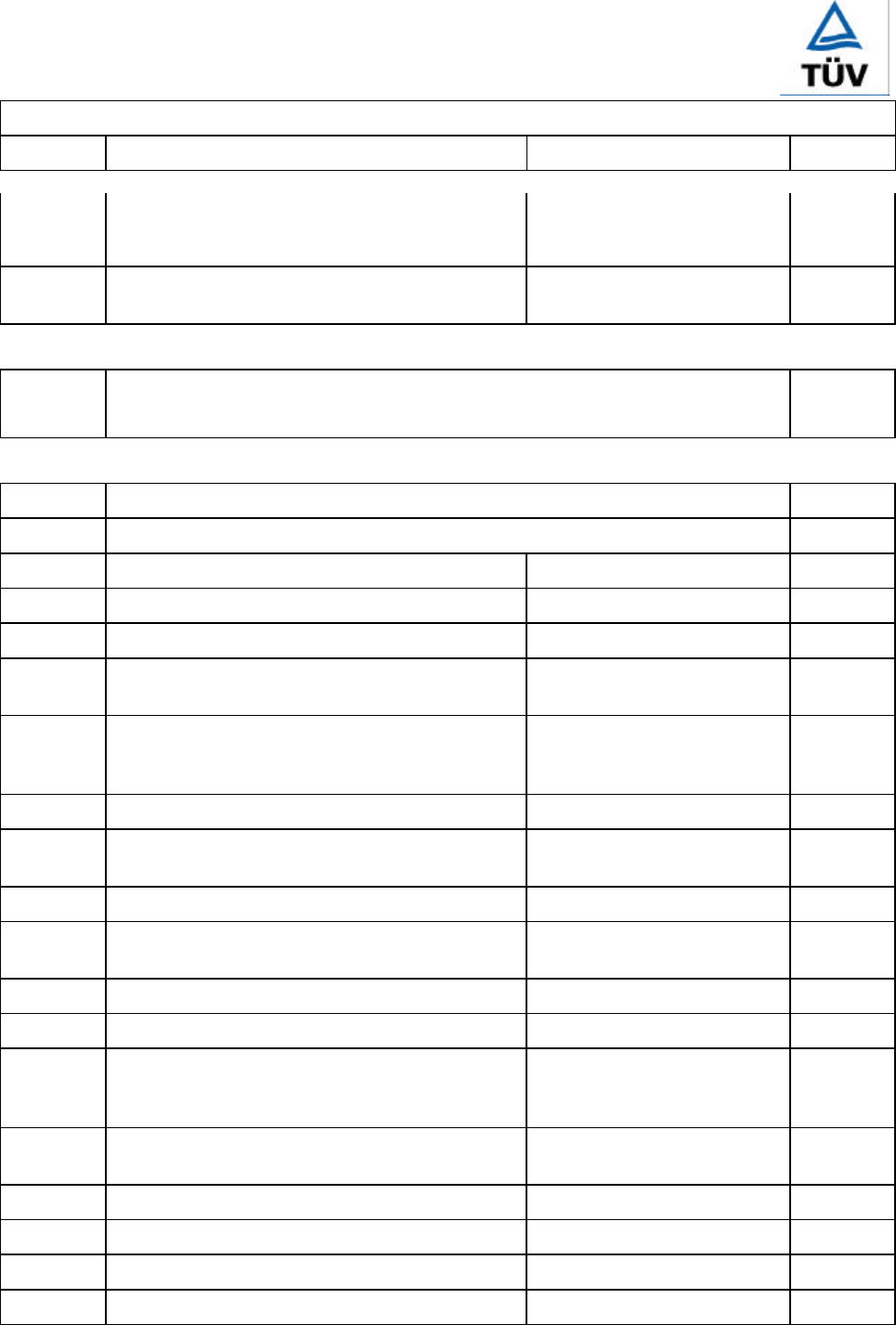
<12002388 001> Page 26
IEC 950
Clause Requirement − Test Result – Remark Verdict
TRF No.: I950___D TRF originator: FIMKO
strength test primary→SELV
and primary→PE were
passed.
5.4.10 Ball-pressure test of thermoplastic parts;
impression shall not exceed 2 mm None of them outside the
approved SPS. P
6CONNECTION TO TELECOMMUNICATION NETWORKS
Equipment is not intended be connected TNV.
N
6.1 General N
6.2 TNV circuits N
6.2.1.1 Limits of the TNV circuits N
6.2.1.1 a) TNV-1 circuits N
6.2.1.1 b) TNV-2 and TNV-3 circuits N
6.2.1.2 Separation from other circuits and from
accessible parts N
Voltage (V) in SELV circuits, TNV-1 circuits and
accessible conductive parts in event of single
insulation fault or component failure ...............:
N
6.2.1.3 Operating voltages generated externally N
Voltage (V) in SELV circuit, TNV-1 circuit or
accessible conductive part .............................:N
6.2.1.4 Separation from hazardous voltages ...............:N
Insulation between TNV circuit and circuit at
hazardous voltage N
Method used ...............................................:N
6.2.1.5 Connection of TNV circuits to other circuits N
Insulation (mm) between TNV circuit supplied
conductively from secondary circuit and
hazardous voltage circuit ...............................:
N
6.2.2.1 Protection against contact with bare conductive
parts of TNV-2 and TNV-3 circuits N
Test with test finger N
Test with test probe N
6.2.2.2 Battery compartments N
Marking next to door/on door N
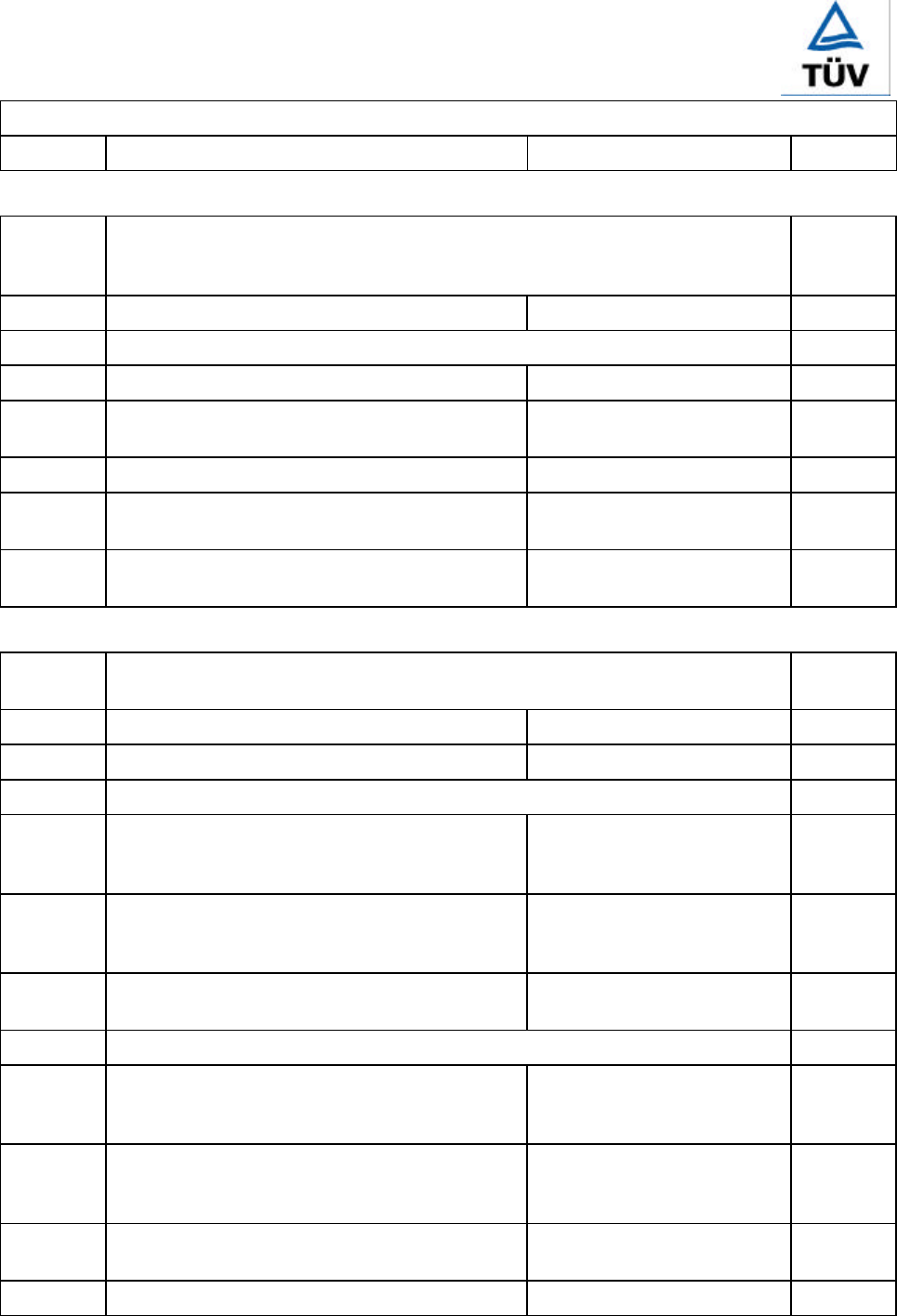
<12002388 001> Page 27
IEC 950
Clause Requirement − Test Result – Remark Verdict
TRF No.: I950___D TRF originator: FIMKO
6.3 Protection of telecommunication network service personnel, and users of other
equipment connected to the telecommunication network, from hazards in the
equipment
N
6.3.1 Protection from hazardous voltages N
6.3.2 Use of protective earthing N
Language of installation instructions ...............:N
6.3.3.1 Insulation between TNV circuit and parts or
circuitry that may be earthed (see appended table 5.3) N
6.3.3.2 Exclusions ...................................................:N
6.3.4.1 Limitation of leakage current (mA) to
telecommunication network ...........................:N
6.3.4.2 Summation of leakage currents from
telecommunication network ...........................:N
6.4 Protection of equipment users from voltages on the telecommunication
networks N
6.4.1 Separation requirements N
6.4.2 Test procedure N
6.4.2.1 Impulse test: separation between TNV-1 circuits/TNV-3 circuits and: N
6.4.2.1 a) unearthed conductive parts/non-conductive parts
of the equipment expected to be held or touched
during normal use; test at 2,5 kV
N
6.4.2.1 b) parts and circuitry that can be touched by the
test finger except contacts of connectors that
cannot be touched by test probe; test at 1,5 kV
N
6.4.2.1 c) circuitry which is provided for connection of
other equipment; test at 1,5 kV N
6.4.2.2 Electric strength test: separation between TNV-1 circuits/TNV-3 circuits and: N
6.4.2.2 a) unearthed conductive parts/non-conductive parts
of the equipment expected to be held or touched
during normal use; test at 1,5 kV
N
6.4.2.2 b) parts and circuitry that can be touched by the
test finger except contacts of connectors that
cannot be touched by test probe; test at 1,0 kV
N
6.4.2.2 c) circuitry which is provided for connection of
other equipment; test at 1,0 kV N
6.4.2.3 Compliance criteria N
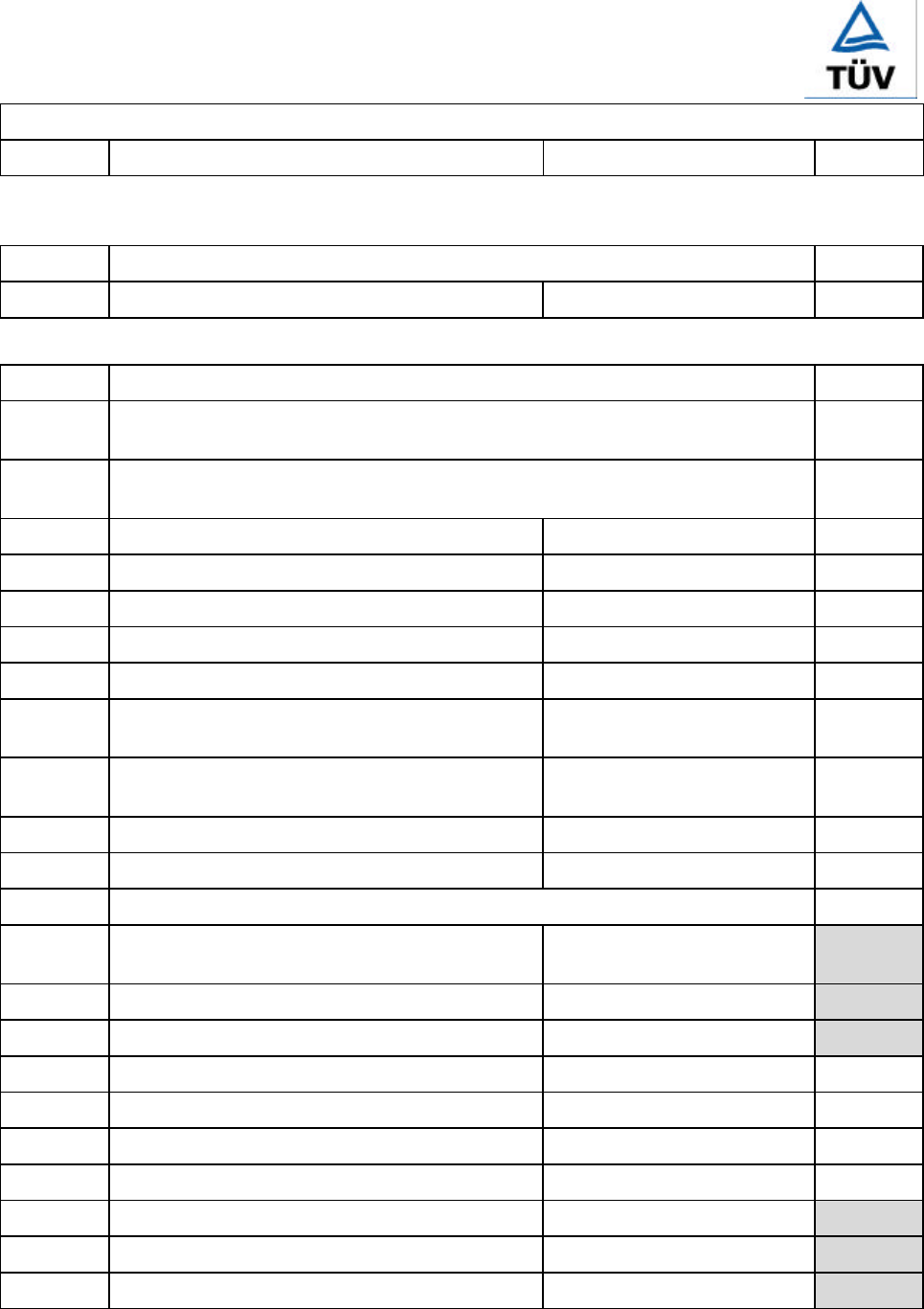
<12002388 001> Page 28
IEC 950
Clause Requirement − Test Result – Remark Verdict
TRF No.: I950___D TRF originator: FIMKO
6.5 Protection of telecommunication wiring system from overheating N
Maximum continuous output current (A) .........:N
AANNEX A, TESTS FOR RESISTANCE TO HEAT AND FIRE N
A.1 Flammability test for fire enclosures of moveable equipment having a total mass
exceeding 18 kg, and of stationary equipment N
A.2 Flammability test for fire enclosures of moveable equipment having a total mass
not exceeding 18 kg, and for materials located within fire enclosures N
A.3 High current arcing ignition test N
A.3.6 Number of arcs ............................................:N
A.4 Hot wire ignition test N
A.4.6 Ignition time (s) ...........................................:N
A.5 Hot flaming oil test N
A.6 Flammability test for classifying materials V-0,
V-1 or V-2 N
A.7 Flammability test for classifying foamed
materials HF-1, HF-2 or HBF N
A.8 Flammability test for classifying materials HB N
A.9 Flammability test for classifying materials 5V N
ATested material N
Preconditioning: 7 days (168 h); temperature
(°C) ............................................................:—
Mounting of samples during test ....................:—
Wall thickness .............................................:—
Sample 1 burning time ..................................:N
Sample 2 burning time ..................................:N
Sample 3 burning time ..................................:N
Material: compliance with the requirements N
Manufacturer of tested material .....................:—
Type of tested material .................................:—
Additional information ...................................:—
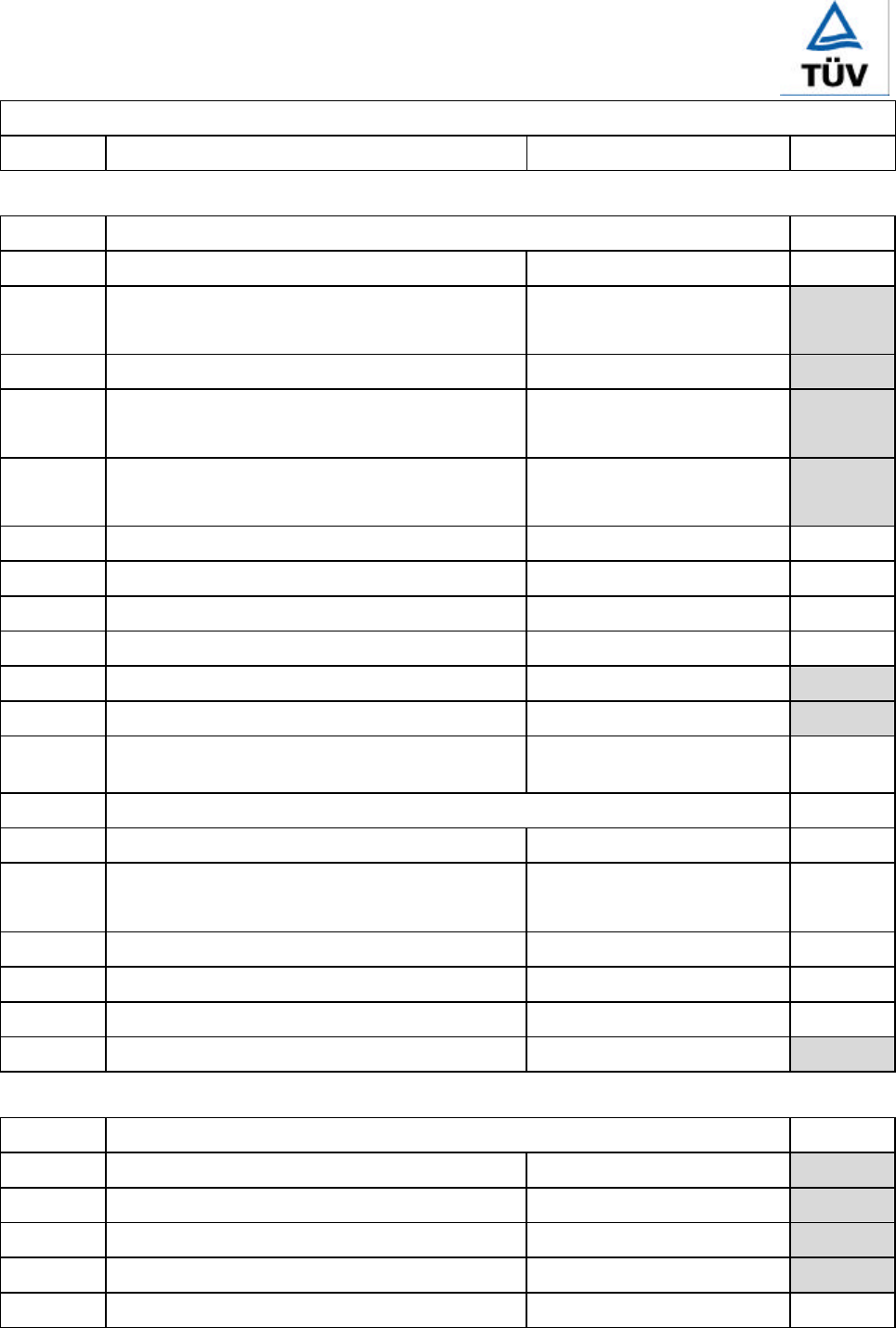
<12002388 001> Page 29
IEC 950
Clause Requirement − Test Result – Remark Verdict
TRF No.: I950___D TRF originator: FIMKO
BANNEX B, MOTOR TESTS UNDER ABNORMAL CONDITIONS P
B.1 General requirements P
Position ......................................................:1. CPU Fan
2. System Fan
—
Manufacturer ...............................................:Delta Electronics Inc. —
Type ..........................................................:1. AFC0612BC
2. EFC0412BD
—
Rated voltage (V) or current (A) .....................:1. 12V/0.3A
2. 12V/0.24A
—
B.2 Test conditions N
B.3 Maximum temperatures N
B.4 Running overload test N
B.5 Locked-rotor overload test N
Test duration (days) .....................................:—
Electric strength test: test voltage (V) .............:—
B.6 Running overload test for DC motor in secondary
circuits N
B.7 Locked-rotor overload test for DC motor in secondary circuits P
B.7.2 Test time (h) ...............................................:N
B.7.3 Test time (h) ...............................................:7 hours
Results see table 5.4.
P
B.8 Test for motors with capacitors N
B.9 Test for three-phase motors N
B.10 Test for series motors N
Test voltage (V) ...........................................:—
CANNEX C, TRANSFORMERS N
Position ......................................................:—
Manufacturer ...............................................:—
Type ..........................................................:—
Rated values ...............................................:—
Temperatures N
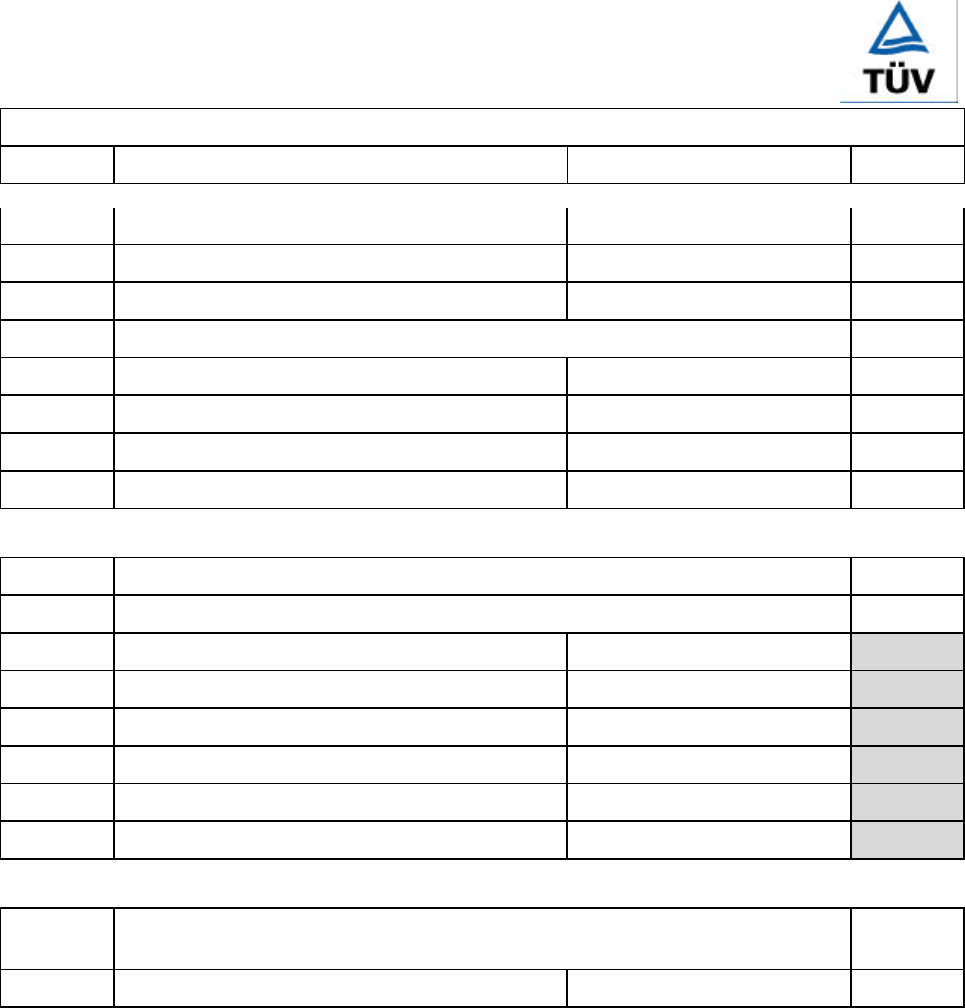
<12002388 001> Page 30
IEC 950
Clause Requirement − Test Result – Remark Verdict
TRF No.: I950___D TRF originator: FIMKO
Thermal cut-out N
C.1 Overload test N
Conventional transformer N
C.2 Insulation N
Precautions .................................................:N
Retaining of end turns of all windings N
Earthing test at 25 A N
C.3 Electric strength test N
HANNEX H, IONIZING RADIATION N
Ionizing radiation N
Measured radiation .......................................:—
Measured high-voltage (kV) ...........................:—
Measured focus voltage (kV) .........................:—
CRT markings ..............................................:—
Certified by .................................................:—
Standard used .............................................:—
UANNEX U, INSULATED WINDING WIRES FOR USE AS MULTIPLE PLAYER
INSULATION N
See separate test report N
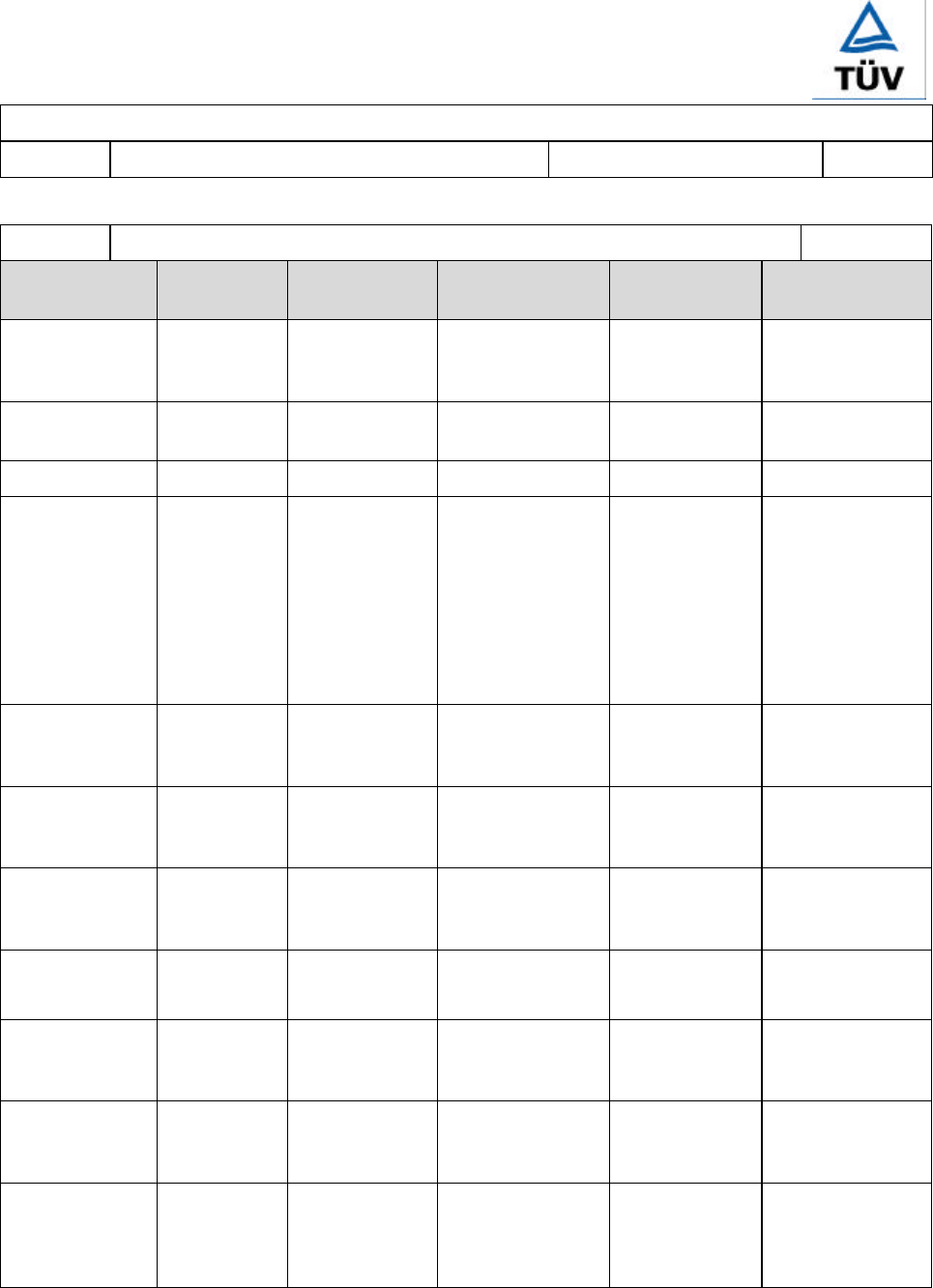
<12002388 001> Page 31
IEC 950
Clause Requirement − Test Result – Remark Verdict
TRF No.: I950___D TRF originator: FIMKO
1.5.1 TABLE: list of critical components P
object/part No. manufacturer
/ trademark type/model technical data standard mark(s) of
conformity1)
Enclosure -- -- Metal,
thickness =
0.7mm
-- --
Front Panel/
Base -- -- HB or better UL94 UL
PCB -- -- V-1 min, 105°CUL 94 UL
Power supply AsusTek
Computer
Inc.
ATTP-165AAP I/P : 100-240V,
47-63Hz, 3A,
Class I
O/P : +5V/8A,
+3.3V/8A,
+12V/9A,
-12V/0.3A
+5Vsb/1.5A
IEC 60950 CB by TUV
Product Service
(Ref. Certif. NO.
DE 3-51401)
HDD ( Optional ) IBM Japan
Ltd. DDYX-Tnnnnn
(X=S, P, or A
n=0-9)
5V/0.75A
12V/1.1A IEC 60950 TUV, UL
Fujitsu Ltd. MAJ3xxxMy
(x=0-9
y=a-z or blank)
5V/1.0A
12V/1.2A IEC 60950 TUV, UL
Seagate
Technology
Inc.
ST336704LC 12V/1.1A IEC 60950 TUV, UL
Seagate
Technology
Inc.
ST318451LC 5V/ varies
12V /varies IEC 60950 TUV, UL
Seagate
Technology
Inc.
9N2* 5V/0.95A
12V/0.55A IEC 60950 VDE, UL
Seagate
Technology
Inc.
9P4* 5V/0.80A
12V/0.83A IEC 60950 VDE, UL
CD- ROM
(Optional) Samsung
Electronics
Co.,
Ltd.
SN-124 5V, 1.5A
Laser Class 1 IEC 60950 IEC
60825-1 TUV, UL
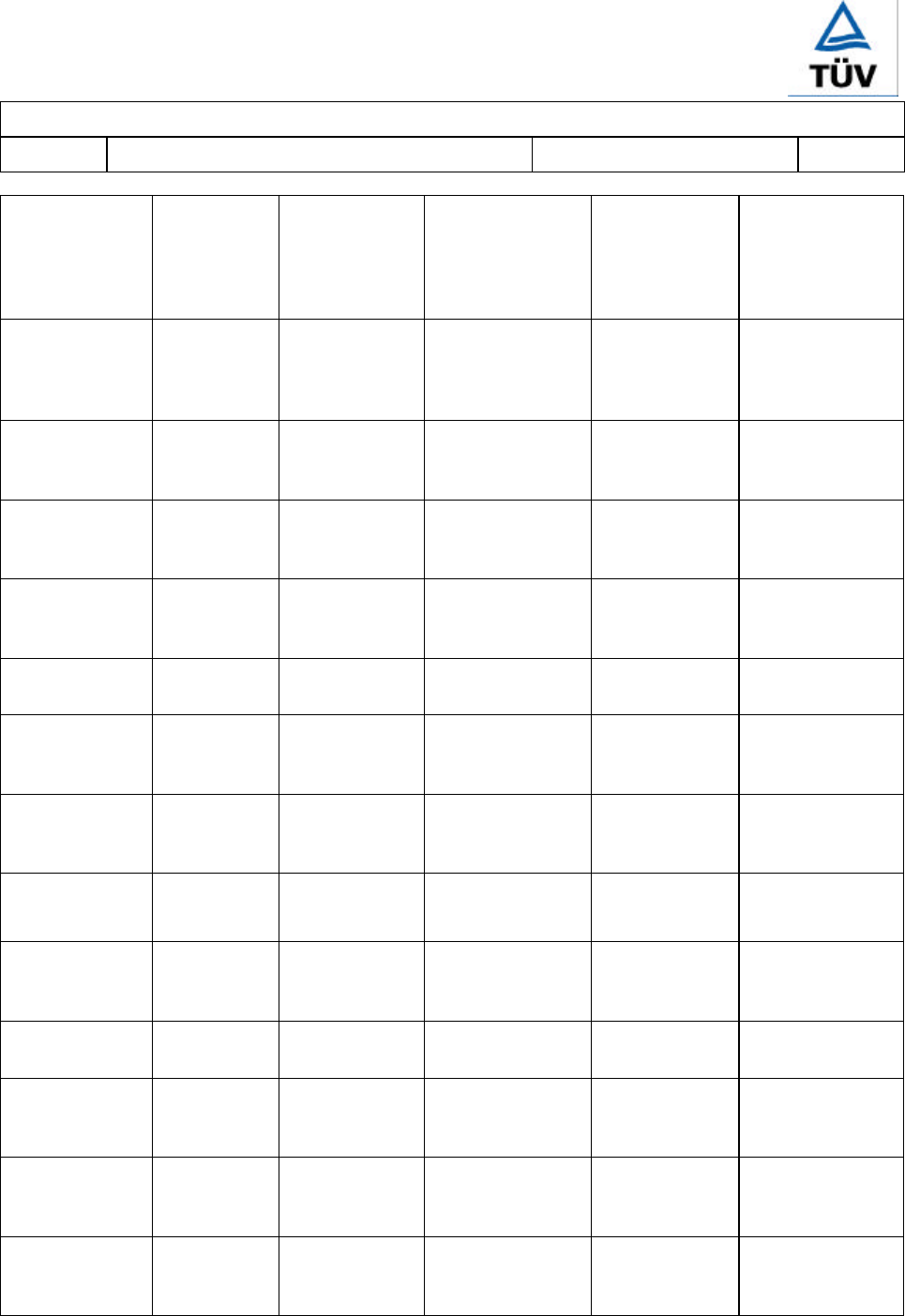
<12002388 001> Page 32
IEC 950
Clause Requirement − Test Result – Remark Verdict
TRF No.: I950___D TRF originator: FIMKO
Teac
Corporation CD-2XXXX
(X is
alphanumeric
characters or
blank)
5V, 1.5A
Laser Class 1 IEC 60950
IEC 60825-1 TUV, UL
Lite-On LTN-
XX5XXXXX
(X=A-Z, 0-9 or
blank)
5V, 1A
Laser Class 1 IEC 60950
IEC 60825-1 TUV, UL
Asustek
Computer
Inc.
CD-SXX/A
(X=A-Z or 0-9) 5V/ 1.2A
12V/1.5A
Laser Class 1
IEC 60950
IEC 60825-1 TUV, UL
Asustek
Computer
Inc.
CD-SXXXX
(X=A-Z or 0-9) 5V/ 1.2A
12V/1.5A
Laser Class 1
IEC 60950
IEC 60825-1 TUV, UL
Asustek
Computer
Inc.
CD-SXXX/A
(X=A-Z or 0-9) 5V/ 1.2A
12V/1.5A
Laser Class 1
IEC 60950
IEC 60825-1 TUV, UL
FDD ( Optional ) Sony corp. MPF720-xxx
MFD720-xxx 5V, 730mA IEC 60 950 TUV, UL
CD- RW Driver
(Optional) Asustek
Computer
Inc.
CRW-XXXXX
(X=A-Z or 0-9) 5V, 1.5A
Laser Class 1 IEC 60950
IEC 60825-1 TUV, UL
DVD- ROM
(Optional) Asustek
Computer
Inc.
DVD-EXXXX
(X=A-Z or 0-9) 5V/ 0.9A
12V/1.5A
Laser Class 1
IEC 60950
IEC 60825-1 TUV, UL
System DC FAN Delta EFC0412BD 12V, 0.24A
10.10 CFM -- UL
CPU DC FAN Delta
Electronics
Inc.
AFC0612BC 12V, 0.3A, 27.72
CFM -- UL
RTC Battery Sony CR2032 3V, 220mAh,
Lithium type -- UL
Matsushita
battery
Industrial
CR2032 3V, 210mAh,
Lithium type -- UL
Matsushita
electric
Industry
CR2032 3V, 220mAh,
Lithium type -- UL
Toshiba
Battery
Co., Ltd
CR2032 3V, 220mAh,
Lithium type -- UL
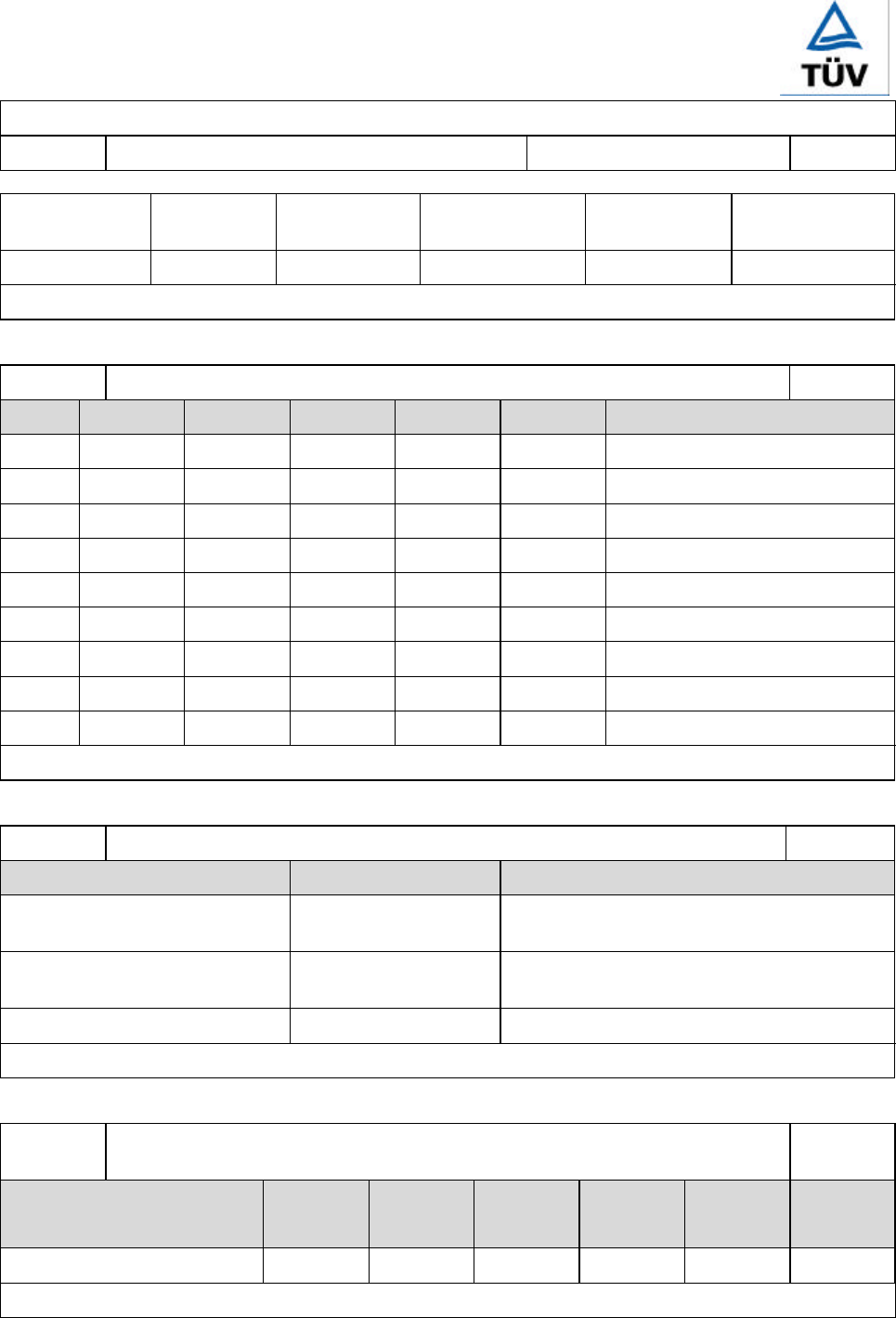
<12002388 001> Page 33
IEC 950
Clause Requirement − Test Result – Remark Verdict
TRF No.: I950___D TRF originator: FIMKO
Hitachi
Maxell CR2032 3V, 210mAh,
Lithium type -- UL
1) an asterisk indicates a mark which assures the agreed level of surveillance
1.6 TABLE: electrical data P
fuse # Irated (A) U (V) P (W) I (A) Ifuse (A) condition/status
Fuse -- 90V/50Hz 114 1.29 1.29 Unit at max. normal load
Fuse -- 90V/60Hz 114 1.28 1.28 dto
Fuse 3100V/50Hz 114 1.16 1.16 dto
Fuse 3100V/60Hz 114 1.15 1.15 dto
Fuse 3240V/50Hz 112 0.53 0.53 dto
Fuse 3240V/60Hz 112 0.55 0.55 dto
Fuse -- 254V/50Hz 112 0.52 0.52 dto
Fuse -- 254V/60Hz 113 0.53 0.53 dto
2.5.11 TABLE: ground continue test P
Location Resistant measured (Ω)Comments
Inlet ground pin to metal
enclosure 0.029 25A Test Current, 1 min
Inlet ground pin to metal
enclosure 0.030 30A Test Current, 2 min
2.9.2 and
2.9.3 TABLE: clearance and creepage distance measurements N
clearance cl and creepage
distance dcr at/of: Up
(V)
U r.m.s.
(V) required cl
(mm) cl (mm) required
dcr (mm) dcr
(mm)
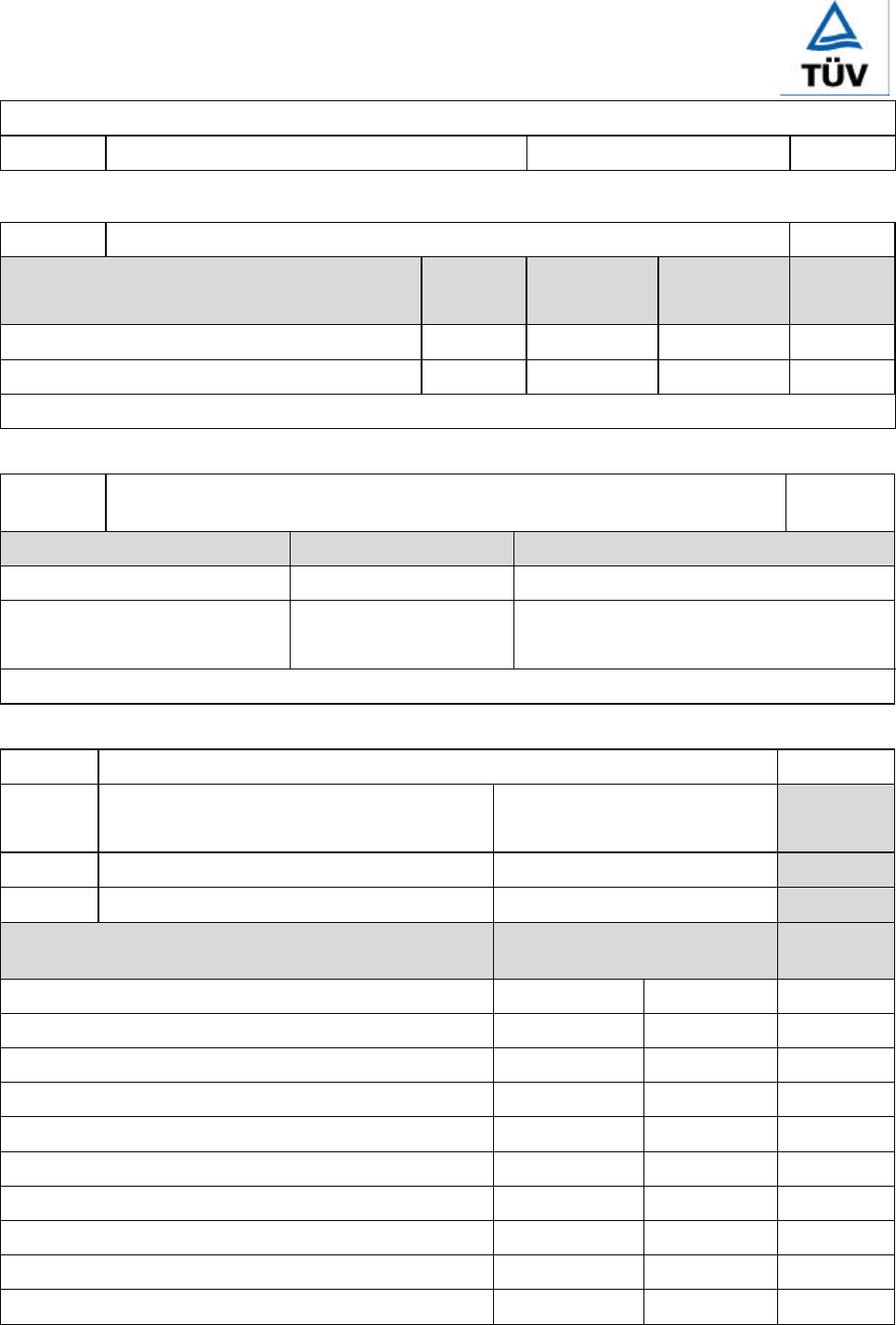
<12002388 001> Page 34
IEC 950
Clause Requirement − Test Result – Remark Verdict
TRF No.: I950___D TRF originator: FIMKO
2.9.4.1 TABLE: distance through insulation measurements N
distance through insulation di at/of: U r.m.s.
(V)
test voltage
(V) required di
(mm) di
(mm)
4.3.15/16
& 4.4.6 Table: enclosure openings P
Location Size (mm) Comments
Top Ø 1.75mm Round, cover an area 285mm x 20mm.
Side Ø 4.95mm Round, cover an area 87.3mm x 50mm.
5.1 TABLE: temperature rise measurements P
test voltage (V) .......................................... a) 100-10%
b) 240+6%
t1 (°C) ......................................................
t2 (°C) ......................................................
temperature rise dT of part/at: dT (K) required dT
(K)
Test Voltage a) b) --
T1 coil 29.5 29.3 55
T1 core 27.4 27.3 55
T2 coil 18.5 18.3 55
T2 core 14.3 14.0 55
PFC1 coil 30.5 24.2 70
PFC1 core 25.6 18.6 70
L1 coil 26.8 26.5 70
LF2 coil 31.5 28.2 70
LF coil 30.2 28.1 70
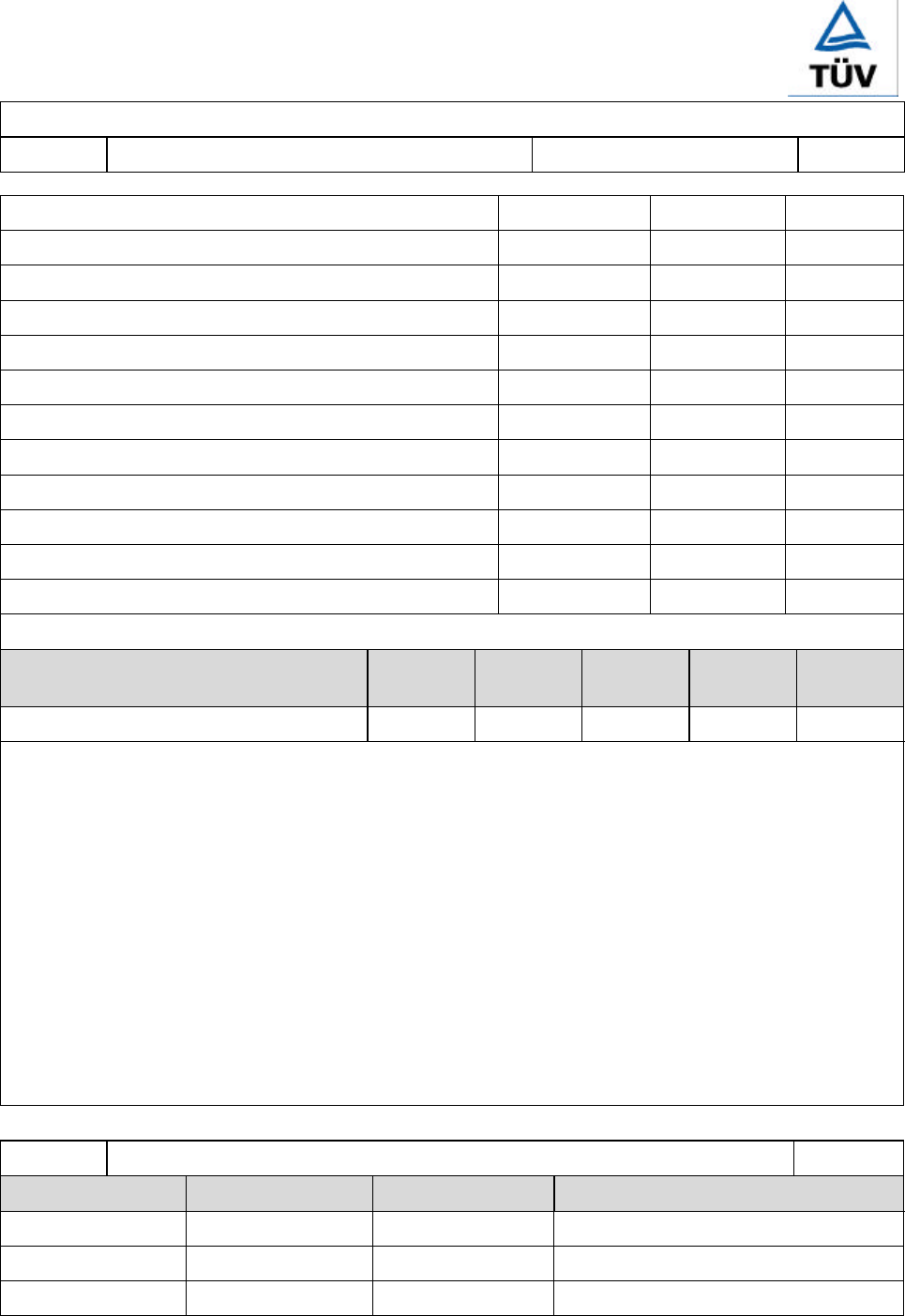
<12002388 001> Page 35
IEC 950
Clause Requirement − Test Result – Remark Verdict
TRF No.: I950___D TRF originator: FIMKO
C11 body 21.3 19.9 50
Heatsink of CPU 16.8 16.3 --
RTC battery body 26.5 26.2 --
HDD body 8.0 8.8 --
FDD body 11.4 11.4 --
CD-ROM body 9.2 9.5 --
Enclosure inside near heatsink (top) 9.5 9.3 --
Enclosure inside near SPS (top) 13.2 12.7 --
Enclosure outside near heatsink (top) 8.0 7.9 35
Enclosure outside near SPS (top) 9.5 9.2 35
Ambient 23.6ºC 23.7ºC --
temperature rise dT of winding: R1 (Ω)R2 (Ω)dT (K) required dT
(K) Insulation
class
Comments:
The temperatures were measured by thermal couple method under worst case normal load as described
in 1.6.1 at voltages described in 1.6.5.
With a specified ambient temperature of 35°C, the max. temperature rise is calculated as follows:
Winding components or components:
- class A → dTmax = 75K - 10K - (35-25)K = 55K
Electrolyte capacitor or components with:
- max. absolute temp. of 85°C → dTmax = (85-35) K = 50K
- max. absolute temp. of 105°C → dTmax = (105-35) K = 70K
Touchable enclosure (Metal) surface with:
- max. temp. rise 45K→ dTmax = 45K-(35-25) K = 35K
5.2 TABLE: leakage current measurement P
Condition current L→PE (mA) current N→PE (mA) comments
System on 0.46 0.44
System off 0.46 0.46
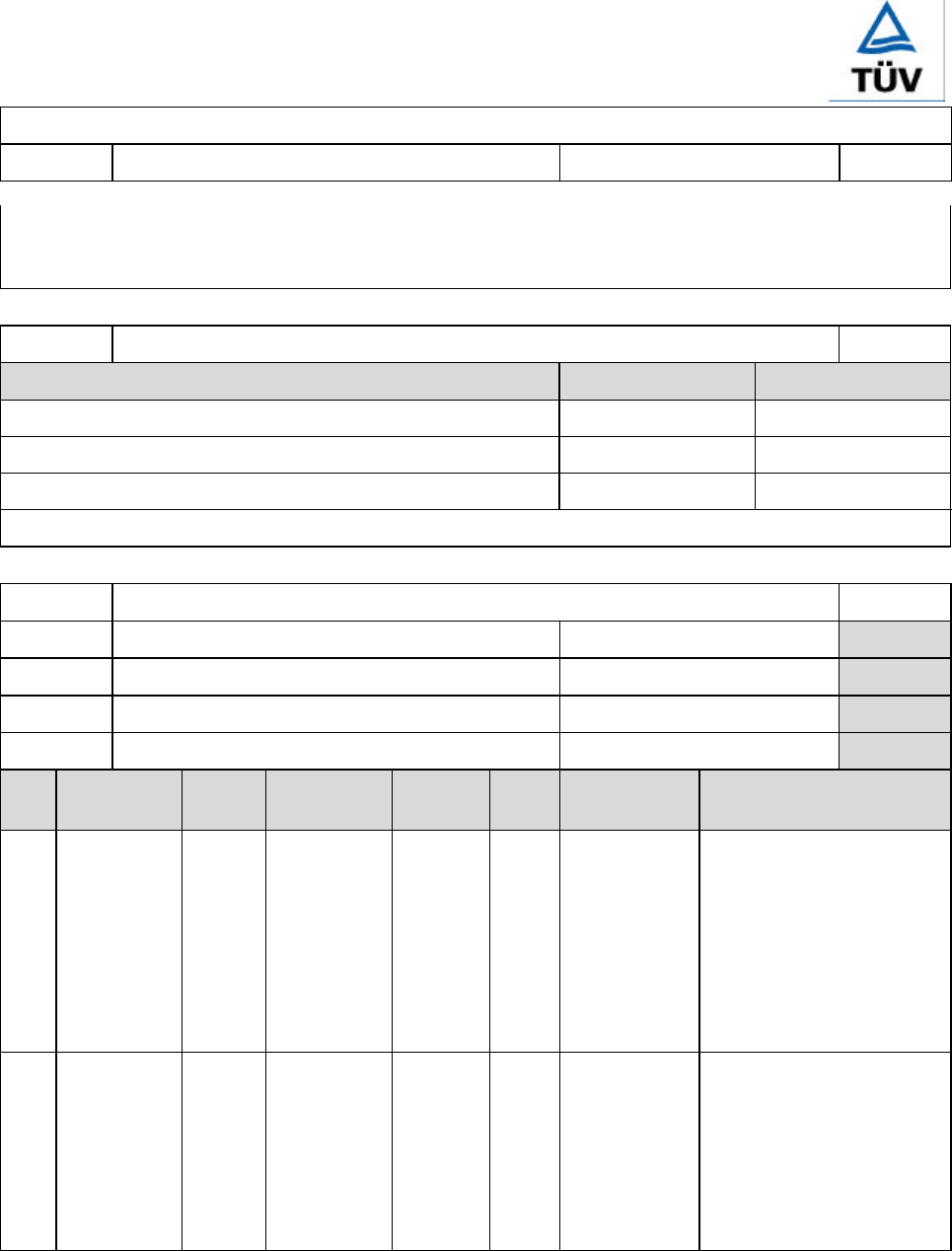
<12002388 001> Page 36
IEC 950
Clause Requirement − Test Result – Remark Verdict
TRF No.: I950___D TRF originator: FIMKO
Input voltage :254V
Input frequency :63Hz
Overall capacity :In approved SPS
5.3 TABLE: electric strength measurements P
test voltage applied between: test voltage (V) breakdown
Primary to Secondary DC 4242 No
Primary to Ground DC 2677 No
5.4 TABLE: fault condition tests P
ambient temperature (°C) ..............................:25°C
model/type of power supply ..........................:ATP-165AAP
manufacturer of power supply .......................:Asustek
rated markings of power supply .....................:See table 1.5.1
No. component
No. fault test voltage
(V) test time fuse
No. fuse current
(A) result
1Ventilation
openings blocked 240 3.3 hr -- -- Max. temp. are recorded
for SPS: T1 coil =
94.4ºC, T1 core =
91.0ºC, T2 coil = 82.4ºC,
T2 core = 74.4ºC, L1 coil
= 89.3ºC, LF2 coil =
93.3ºC, LF coil = 88.2ºC,
ambient = 21.7ºC, no
hazards
2DC Fan
(for CPU)
locked 240 1.7 hr -- -- Max. temp. are recorded
for SPS: T1 coil = 59ºC,
T1 core = 57ºC, T2 coil
= 57ºC, T2 core = 54ºC,
L1 coil = 65ºC, LF2 coil
= 51ºC, LF coil = 54ºC,
ambient = 23.8ºC, no
hazards
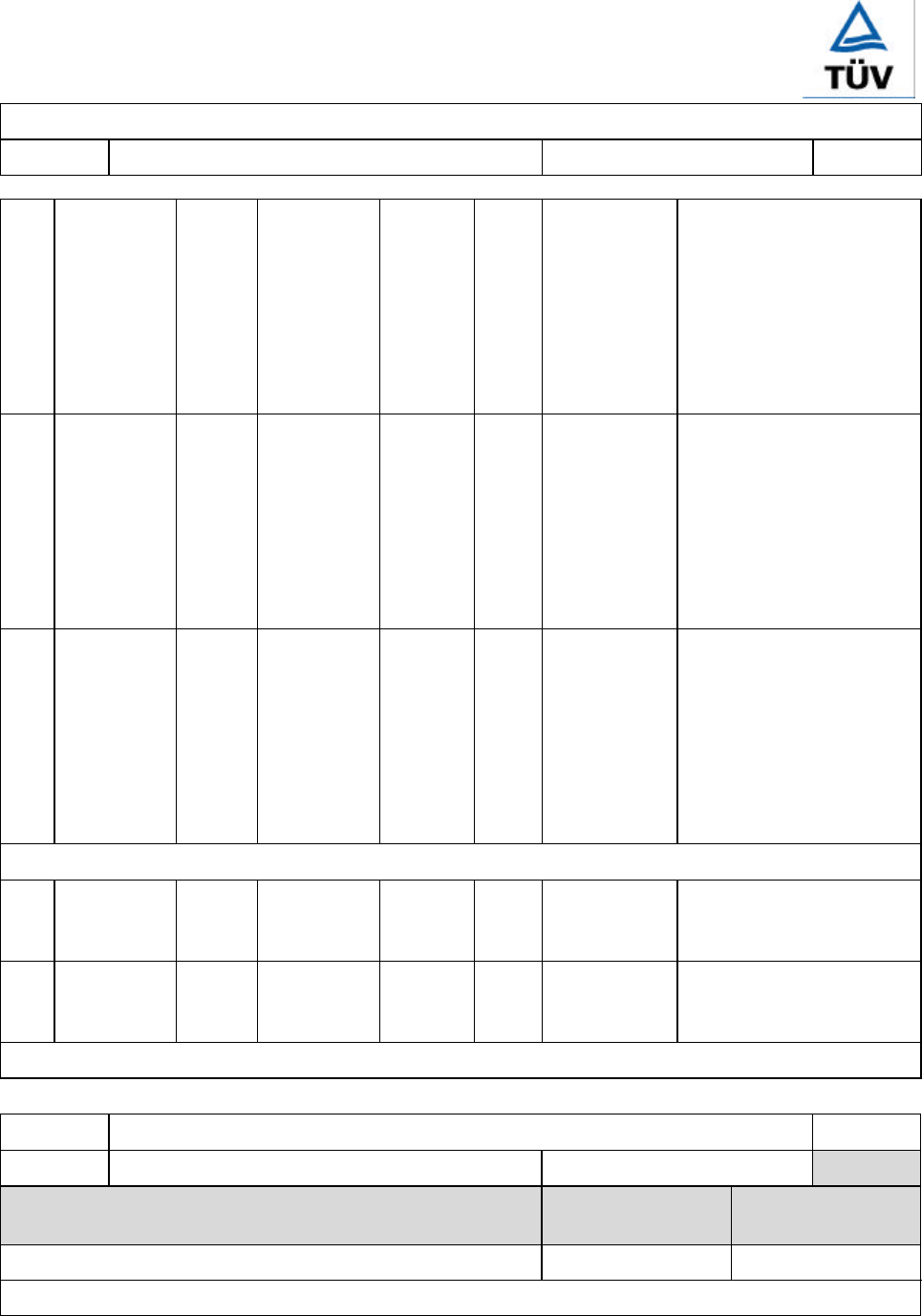
<12002388 001> Page 37
IEC 950
Clause Requirement − Test Result – Remark Verdict
TRF No.: I950___D TRF originator: FIMKO
3DC Fan
(for system)
locked 240 2.3 hr -- -- Max. temp. are recorded
for SPS: T1 coil =
56.0ºC, T1 core =
53.5ºC, T2 coil = 45.3ºC,
T2 core = 41.3ºC, L1 coil
= 53.4ºC, LF2 coil =
54.7ºC, LF coil = 54.8ºC,
ambient = 23.8ºC, no
hazards
4DC Fan
(for SPS,
inside)
locked 240 2.2 hr -- -- Max. temp. are recorded
for SPS: T1 coil =
64.2ºC, T1 core =
61.5ºC, T2 coil = 50.6ºC,
T2 core = 44.8ºC, L1 coil
= 60.1ºC, LF2 coil =
66.5ºC, LF coil = 63.3ºC,
ambient = 23.6ºC, no
hazards
5DC Fan
(for SPS,
outside)
locked 240 2 hr -- -- Max. temp. are recorded
for SPS: T1 coil =
58.7ºC, T1 core =
55.9ºC, T2 coil = 43.2ºC,
T2 core = 37.9ºC, L1 coil
= 57.4ºC, LF2 coil =
53.3ºC, LF coil = 58.9ºC,
ambient = 23.7ºC, no
hazards
Lock rotor test
6DC Fan,
model
EFC0412BD
locked 12VDC 7 hr -- -- The max. temp. of
coil=60.5°C at ambient =
22.7°C, no hazards
7DC Fan,
model
AFC0612BC
locked 12VDC 7 hr -- -- The max. temp. of
coil=52.2°C at ambient =
22.6°C, no hazards
5.4.10 TABLE: ball pressure test of thermoplastics N
required impression diameter (mm) .................:≤ 2 mm
part test temperature
(°C) impression diameter
(mm)
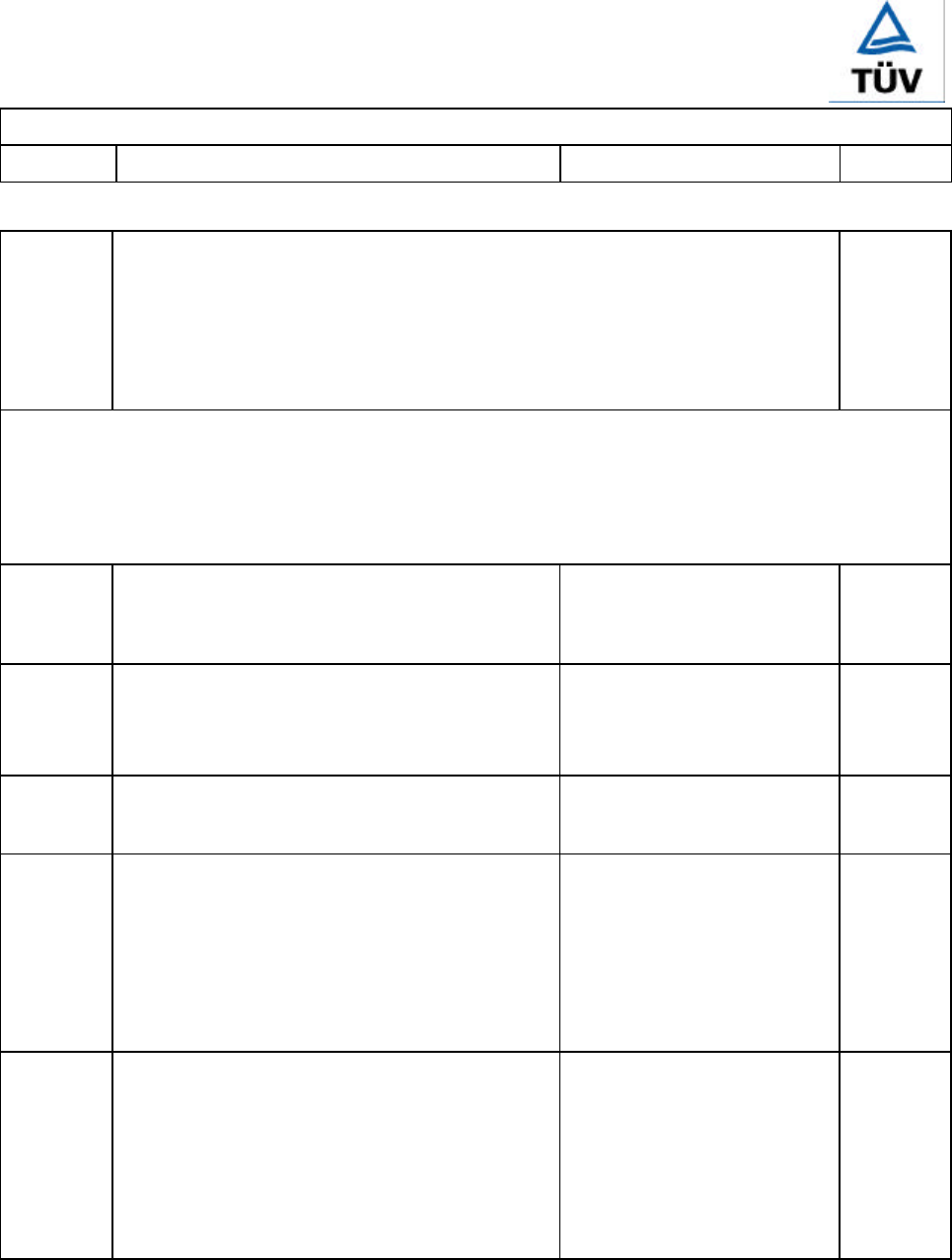
<12002388 001> Page 38
National Deviation
Clause Requirement − Test Result – Remark Verdict
CENELEC common modification, Special National condition, Nation deviation and other information
according to CB Bulletin No. 101A, December 2001
APPENDIX EN 60950:1992+A1:1993:+A2:1993 + A3:1995 + A4:1997 +
A11:1997 TEST REPORT
(IEC Publication 60950 2nd edition, 1991+Amd.1,1992+Amd.2, 1993 +
Amd.3, 1995 + Amd.4, 1996)
CENELEC common modification, Special National condition, Nation deviation
and other information according to CB Bulletin No. 101A, December 2001
P
EXPLANATION FOR ABBREVIATIONS
C=CENELEC common modification, S=Special National condition, D=National deviation, F=Other
information, AT=Austria, GB=Great Britain, CH=Switzerland, DE=Germany, DK=Denmark,
FI=Finland, FR=France, NO=Norway, SE=Sweden.
P=Pass, F=Fail, N=Not applicable. place in the column to the right.
1.2.4.1 S (DK). Certain types of Class I appliances (see sub-
clause 3.2.1) may be provided with a plug not
establishing earthing continuity when inserted into
Danish socket-outlets.
No power cord provided. N
1.5.1 D (SE). Add the following:
NOTE: Switches containing mercury such as
thermostats, relay and level controllers are not
allowed.
No such switch. N
1.6.4 S (NO). Note 2: In Norway, due to the IT power
system used, capacitors are required to be rated for
the applicable phase-to-phase voltage (230V)
Considered, see report IEC
60950. P
1.7.2 S (NO). Note 4: In Norway, if separation between the
mains and a communication system/network, other
than public telecommunication networks, relies upon
connection to safety earth, the equipment shall have
a marking stating that is must be connected to an
earthed mains socket-outlet.
NOTE: For requirements to be connected to a public
telecommunication network, see 6.2.1.4.
Required texts will be printed
on label and affix to unit
when national approved.
N
1.7.2 S (SE). If the separation between the mains and a
SELV terminal relies upon connection to the safety
earth, the apparatus shall have a marking stating
that it must be connected to an earthed mains
socket-outlet when a SELV circuit is connected to
network passing both unearthed and earthed
electrical environment. The marking text shall be in
Swedish and as follows: “Apparaten skall anslutas
till jordat uttag när den ansluts till ett nätverk”.
Required texts will be printed
on label and affix to unit
when national approved.
N
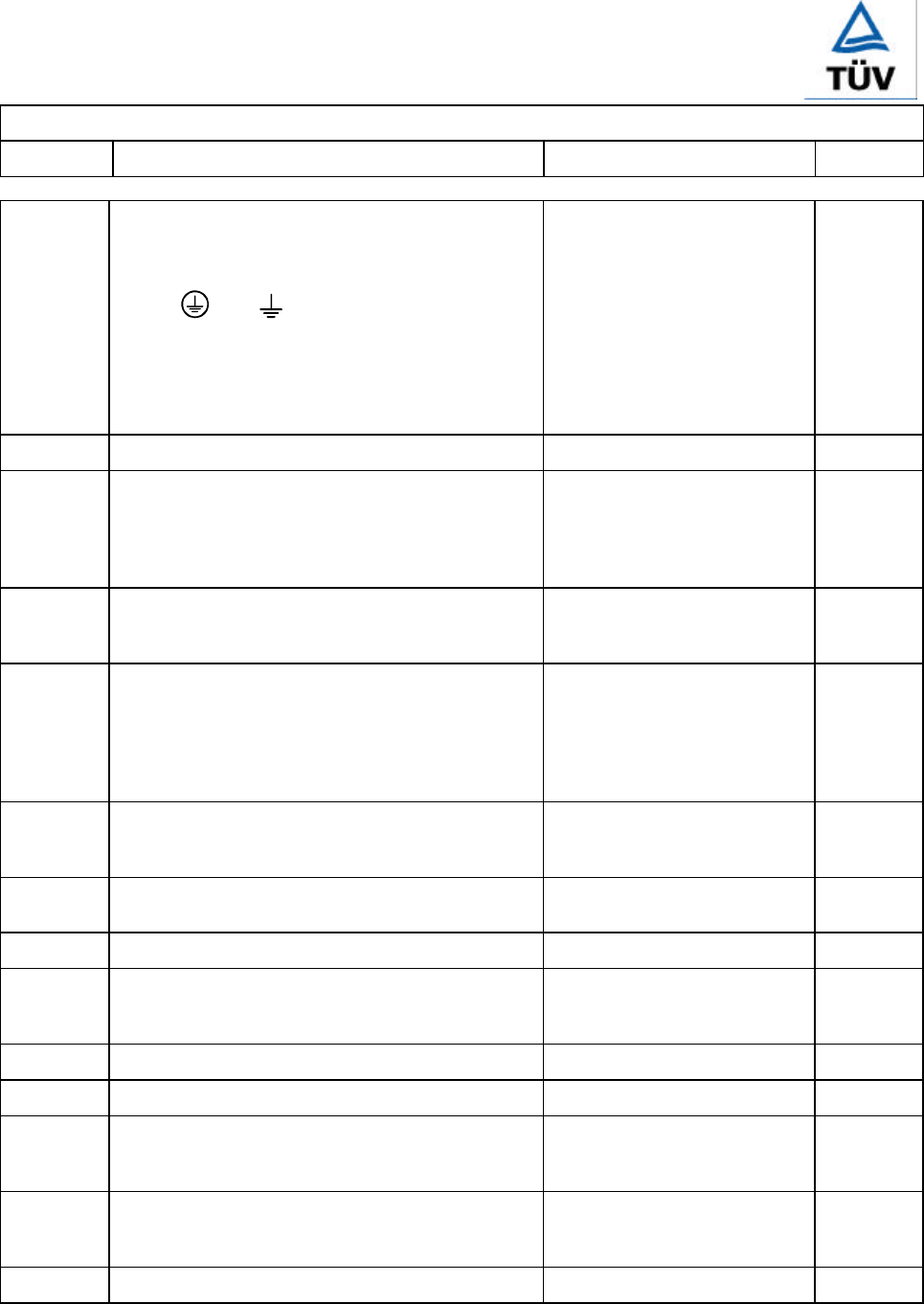
<12002388 001> Page 39
National Deviation
Clause Requirement − Test Result – Remark Verdict
CENELEC common modification, Special National condition, Nation deviation and other information
according to CB Bulletin No. 101A, December 2001
1.7.2 D (DK). Supply cords of Class I appliances, which are
delivered without a plug, must be provided with a
visible tag with the following text: “Vigtigt. Lederen
med grøn/gul isolation mä Kun tilsluttes en klemme
mærket eller ”. If essential for the safety of
the appliance, the tag must in addition be provided
with a diagram, which shows the connection of the
other conductors, or be provided with the following
text: “For tilslutning af de øvrige ledere, se
medfølgende installationsvejledning”.
No power cord provided. N
1.7.2 C Delete note 4. Deleted N
1.7.5 S (DK). Socket-outlets for providing power to other
equipment shall be in accordance with the Heavy
Current Regulations, Section 107-2-D1, Standard
Sheet DK 1-3a, DK 1-5a or DK 1-7a when used on
Class I equipment.
No socket outlet. N
1.7.5 D (DK). Class II appliances shall not be fitted with
socket-outlets for providing power to other
appliances.
Class I equipment. N
1.7.14 D (DE). Directions for use with rules to prevent certain
hazards for (among others) maintenance of the
technical labor equipment, also for imported
technical labor equipment shall be written in German
language. NOTE: Of this requirement, rules for use
even only by service personnel are not exempted.
Not a technical labor
equipment. N
1.7.17 D (CH). (Ordinance on environmentally hazardous
substances SR 814.013) Annex 4.10 of SR
814.013 applies for batteries.
To be evaluated when
national approval. P
2.3.3 C Delete Method 4 and the line in note 1 relating to
this method Deleted. N
2.3.6 C Delete the note. Deleted. N
2.3.5 S (NO). In Norway, marking and insulation
requirements according to subclause 1.7.2, Note 4,
and 6.2.1.4, Note 2, apply.
No marking required. N
2.3.6 S (FR). Method 3 is not acceptable. Method 3 is not used. P
2.3.7 C Replace the text of this sub-clause by: Void. Replaced. N
2.3.9 S (NO). Marking and insulation requirements according
to this annex, subclauses 1.7.02 and 6.2.01.4 b)
apply.
No marking required. N
2.5.2 S (DK, NO) Add after the first paragraph: “The above
exception is not acceptable in pluggable equipment
type A “
Added, no exception applied. N
2.5.2 C Delete the note. Deleted. N
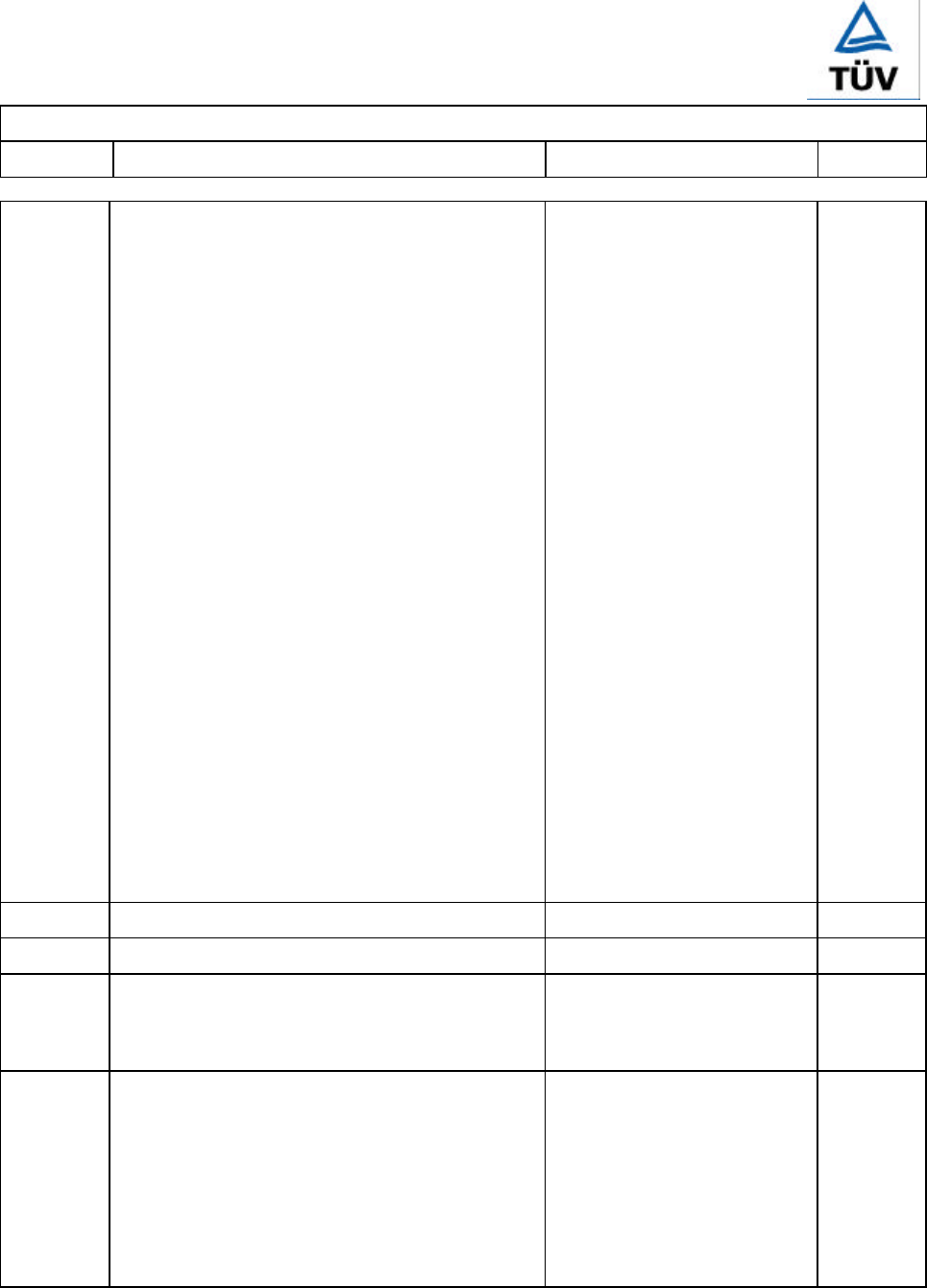
<12002388 001> Page 40
National Deviation
Clause Requirement − Test Result – Remark Verdict
CENELEC common modification, Special National condition, Nation deviation and other information
according to CB Bulletin No. 101A, December 2001
2.7.1 C Replace the text of this sub-clause by: Basic
requirements
To protect against excess current, short-circuits and
earth faults in primary circuits, protective devices
shall be included ether as integral parts of the
equipment or as a part of the building installation,
subject to all of the following a), b), c) and d):
Replaced. P
(a) Except as detailed in (b) and (c), protective
devices necessary to comply with the requirements
of Sub-clause 5.4 shall be included as integral parts
of the equipment.
(b) For components in series with the mains input to
the equipment such as the supply cord, appliance
coupler, RFI filter and switch, short circuit and earth
fault protection may be provided with protective
devices in the installation.
(c) It is permitted for equipment with rated current
exceeding 16A, which is pluggable equipment type
B or permanently connected equipment, to rely on
dedicated overcurrent and short circuit protection in
the building installation, provided that the means of
protection, e.g. fuses or circuit breaker, is fully
specified in the installation instruction
(d) If reliance is placed on protection in the building
installation, the installation instructions shall comply
with Sub-clause 1.7.11 except that for pluggable
equipment Type A the building installation shall be
regarded as providing protection in accordance with
the rating of the wall socket outlet and 1.7.11 does
not apply.
2.7.2 C Replace the text of this sub-clause by: Void. Replaced. N
2.8.4 C Delete the note. Deleted. N
2.9.1 S (NO). Note 3: In Norway, due to the IT power
systems used, the mains supply voltage is
considered to be equal to the phase-to-phase
voltage.
Mains voltage as reference
voltage. P
2.9.4.2 C Amend the last line on page 117a as follows –
Solvent-based enamel coating on winding wire is
not considered to be insulation in thin sheet
material.
Add a new sentence below the text on page 117a
as follows –
Requirements for wound components are given in
2.9.4.4.
Amended. N
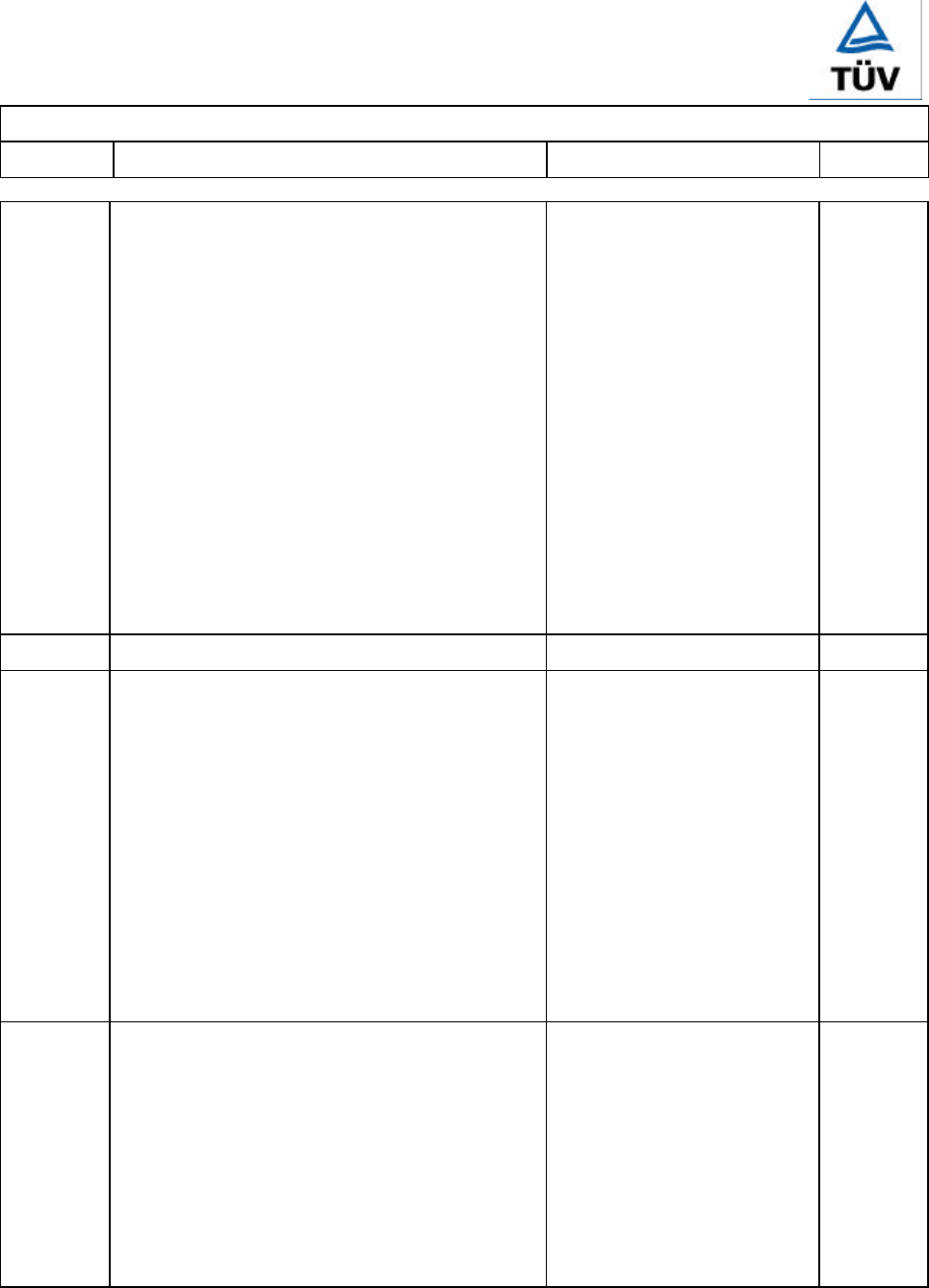
<12002388 001> Page 41
National Deviation
Clause Requirement − Test Result – Remark Verdict
CENELEC common modification, Special National condition, Nation deviation and other information
according to CB Bulletin No. 101A, December 2001
2.9.4.4 C Modify the title as follows –
2.9.4.4 Wound components
Replace the first paragraph and the two dashed
paragraphs as follows –
Unless one of the following situations applies,
interleaved BASIC, SUPPLEMENTARY or
REINFORCED INSULATION complying with 2.9.4.1
or 2.9.4.2 shall be provided between the windings.
-the insulation on the winding wire complies
with 2.9.4.1; or
-the winding wire complies with annex U; or
-the insulation between the windings is provided
for separation between ZNV circuits and other
parts in compliance with 6.4.1.
Note – Examples of insulation of winding wire
complying with annex U are polyamide and FEP.
N
2.11 C Delete notes 1, 2 and 3. Deleted. N
3.2.1 S (DK). Supply cords of single phase appliances
having a rated current not exceeding 10A shall be
provided with a plug according to the Heavy Current
Regulations Section 107-2-D1.
Class I equipment provided with socket-outlets with
earth contacts or which are intended to be used in
locations where protection against indirect contact
is required according to the wiring rules shall be
provided with a plug in accordance with standard
sheet DK 2-1a or DK 2-5a.
If poly-phase equipment and single-phase equipment
having a rated current exceeding 10A is provided
with a supply cord with a plug, this plug shall be in
accordance with the Heavy Current Regulations
Section 107-1-D1 or EN 60309-2.
No power cord provided. N
3.2.1 S (CH). Supply cords of equipment having a rated
current not exceeding 10A shall be provided with a
plug complying with SEV 1011 or IEC 60884-1 and
one of the following dimension sheets
SEV 6532-2,1991 Plug type 15 3P+N+PE
250/400V, 10A
SEV 6533-2,1991 Plug type 11 L+N
250V, 10A
SEV 6534-2,1991 Plug type 12 L+N+PE
250V, 10A
EN 60 309 applies for plugs for currents exceeding
10A
No power cord provided. N
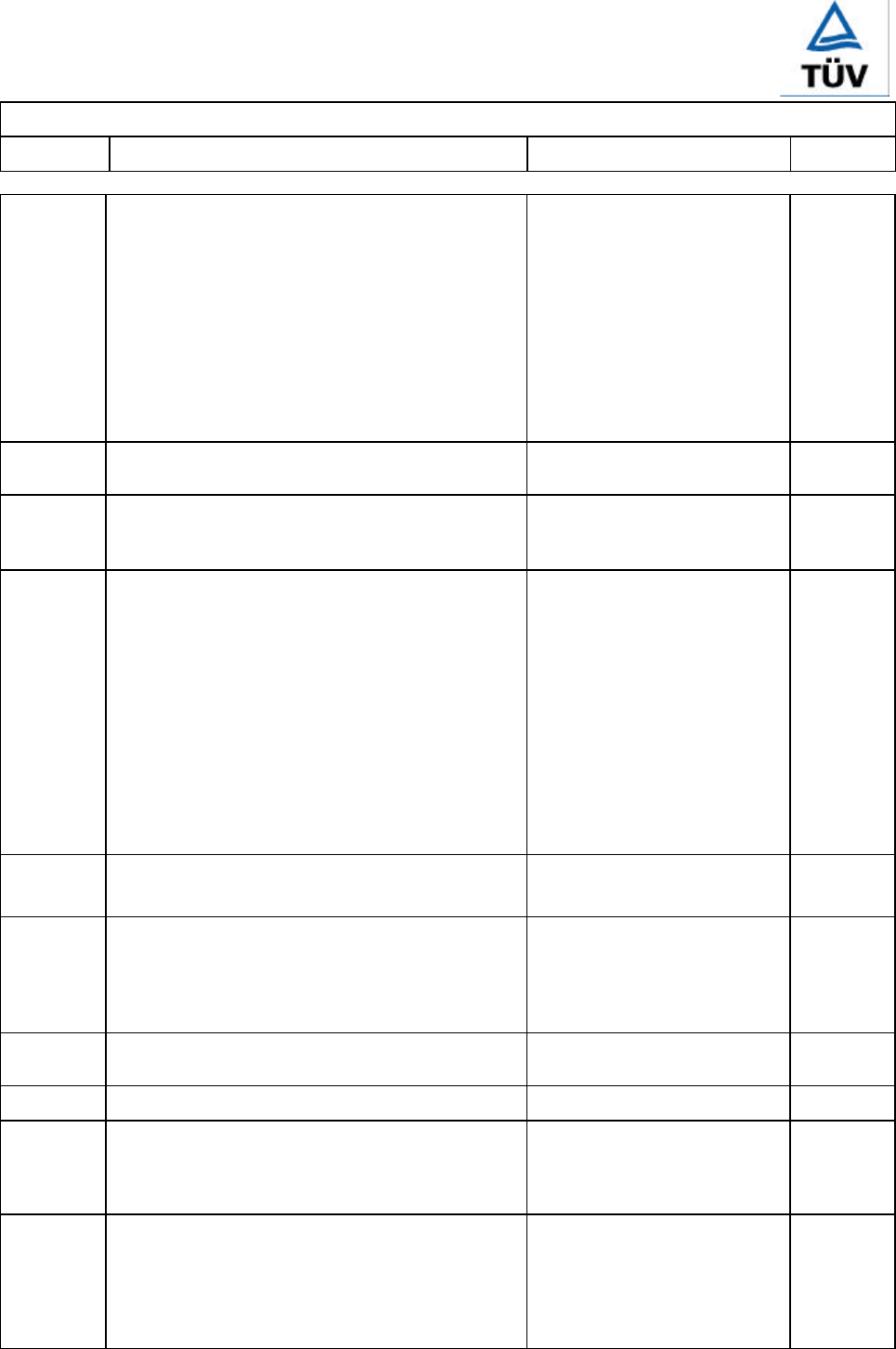
<12002388 001> Page 42
National Deviation
Clause Requirement − Test Result – Remark Verdict
CENELEC common modification, Special National condition, Nation deviation and other information
according to CB Bulletin No. 101A, December 2001
3.2.1 S (GB). Apparatus which is fitted with a flexible cable
or cord and is designed to be connected to a mains
socket conforming to BS1363 by means of that
flexible cable or cord and plug, shall be fitted with a
“standard plug” in accordance with Statutory
Instrument 1768:1994 - The Plugs and Sockets etc.
(Safety) Regulations 1994, unless exempted by
those regulations.
Note: “standard plug” is defined in SI 1768:1994
and essentially means an approved plug conforming
to BS 1363 or an approved conversion plug.
No power cord provided. N
3.2.2 C Delete the note and in table 10, delete the values in
parentheses. Deleted. N
3.2.4 S (GB). A power supply cord with conductor of
1.25mm² is allowed for equipment with rated
current over 10A and up to and including 13A.
No power cord provided. N
3.2.4 C Replace
"60245 IEC 53" by "H05 RR-F",
"60227 IEC 52" by "H03 VV-F or H03 VVH2-F" and
"60227 IEC 53" by "H05 VV-F or H05 VVH2-F".
In table 11, replace the first four lines by the
following:
Up to and including 6 0.75 1)
Over 6 up to and including 10 1.0 (0.75)2)
Over 10 up to and including 16 1.5 (1.0)3)
Replaced. N
In the conditions applicable to table 11, delete the
words "in some countries" in condition 1).
In the Note delete the second sentence.
3.3.5 C In table 13, replace the fourth and the fifth lines by:
Over 10 up to and including 16 1.5 to 2.5 1.5 to by 4
Replaced. N
3.3.5 S (GB). The range of conductor sizes of flexible cords
to be accepted by terminals for equipment with a
rated current of over 10A and up to and including
13A is: 1.25mm² to 1.5mm² nominal cross-sectional
area.
No power cord provided. N
4.3.18 S (GB). This test should be performed using an
appropriate socket-outlet with an earthing contact. No direct plug-in equipment. N
4.4.4 C Delete note 2. Deleted. N
5.4.9 S (NO). Note: In Norway, the electric strength test
includes testing of basic insulation in Class I
pluggable equipment type B and permanently
connected equipment.
Considered. P
6.1 S (CH).Protective means in the equipment shall not
prevent transient surge protection in the
telecommunication network from operating properly
(d.c. spark-over voltage of the surge suppressor
installed in the telecommunication network: approx.
245V).
No TNV. N
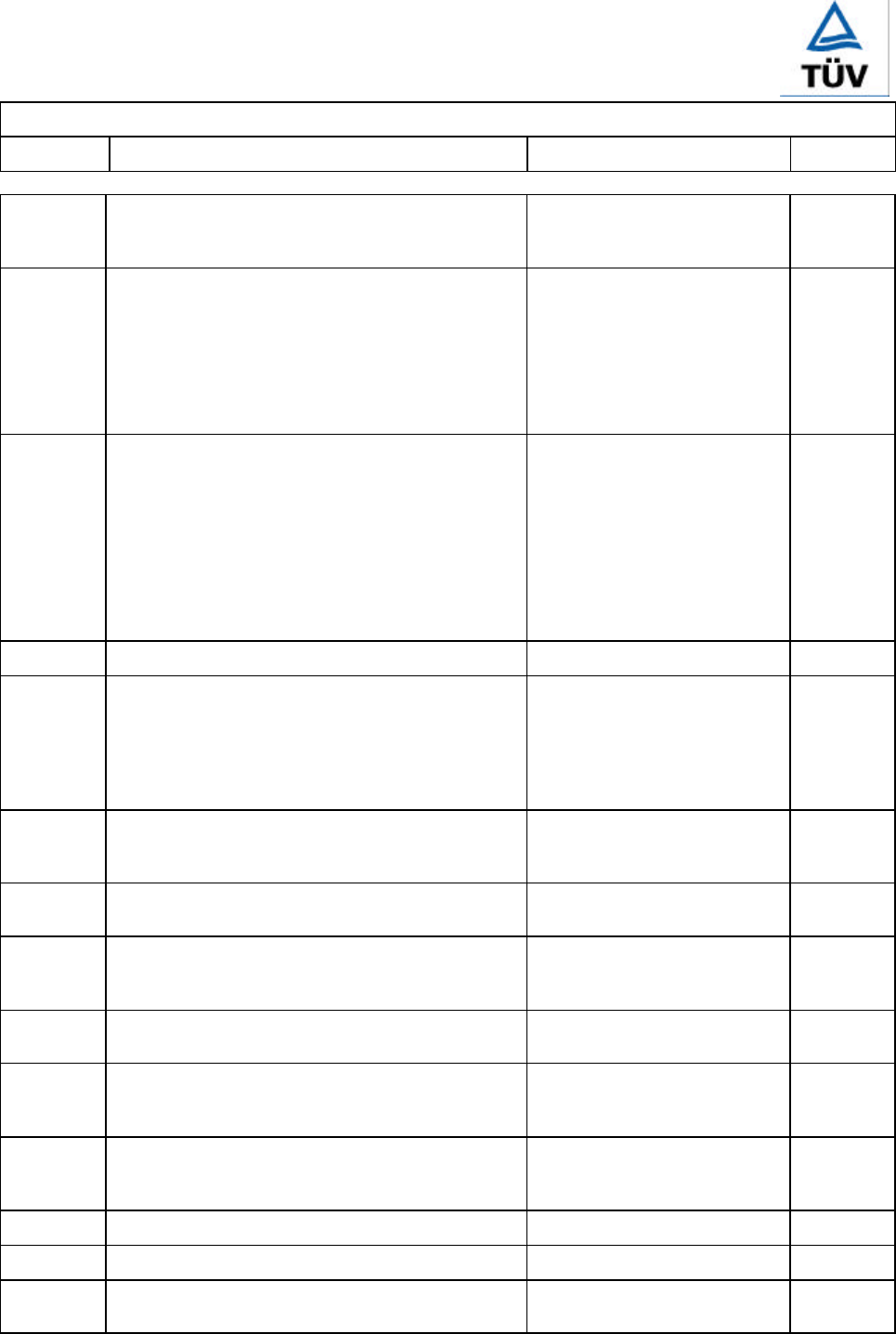
<12002388 001> Page 43
National Deviation
Clause Requirement − Test Result – Remark Verdict
CENELEC common modification, Special National condition, Nation deviation and other information
according to CB Bulletin No. 101A, December 2001
6.2.1.2 C
6.2.1.3C
Add at the end of the sub-clause: This sub-clause
only applies to TNV circuits normally operating in
excess of the limits of SELV circuits.
No TNV. N
6.2.1.2 S (SE). Supplementary insulation for a primary circuit
is required between any TNV circuit and any circuit
that has a connection to a protective earthing
terminal.
In Sweden, this requirement does not apply to
permanently connected equipment or pluggable
equipment Type B.
No TNV. N
6.2.1.2 S (NO). In Norway, supplementary insulation for a
primary circuits is required between any TNV circuit
and any circuit that has a connection to a protective
earthing terminal.
This requirement does not apply to permanently
connected equipment or to pluggable equipment
type B, installed in areas where equipotential
bonding has been applied, e.g. a telecommunication
Central Office.
No TNV. N
6.2.1.4 C Delete the notes. Deleted. N
6.2.1.4 S (NO). Note 2: In Norway, method b) is not
permitted. Insulation between parts conductively
connected to the supply mains and parts connected
to a public telecommunication network shall comply
with the requirements for double or reinforced
insulation.
No TNV. N
6.2.1.4b)
S(FI). Method b) is permitted only for permanently
connected equipment or for pluggable equipment
Type B.
No TNV. N
6.2.1.5 S (NO). Note 2: In Norway, requirements according to
6.2.1.4, Note 2, apply No TNV. N
6.3.3. S (NO). In Norway, 6.3.3 is applicable for pluggable
equipment type A and B and for permanently
connected equipment.
No TNV. N
6.3.3.1 S (SE). In Sweden, requirements according to this
annex ZB, subclause 6.2.1.2 apply. No TNV. N
6.3.3.1 S (NO). In Norway, requirements according to
subclause 6.2.1.2, national difference, 6.2.1.4,
Note 2, and 6.3.3.2, Note 1, applied.
No TNV. N
6.3.3.2 S (NO). Note 1: In Norway, exclusions are applicable
for permanently connected equipment and pluggable
equipment Type B only.
No TNV. N
6.4.1 C Delete note 2. Deleted. N
6.4.2.1 C Delete note 2. Deleted. N
6.4.2.1 D (AT). Equipment shall comply with Uc = 2.0kV in
cases b) and c). No TNV. N
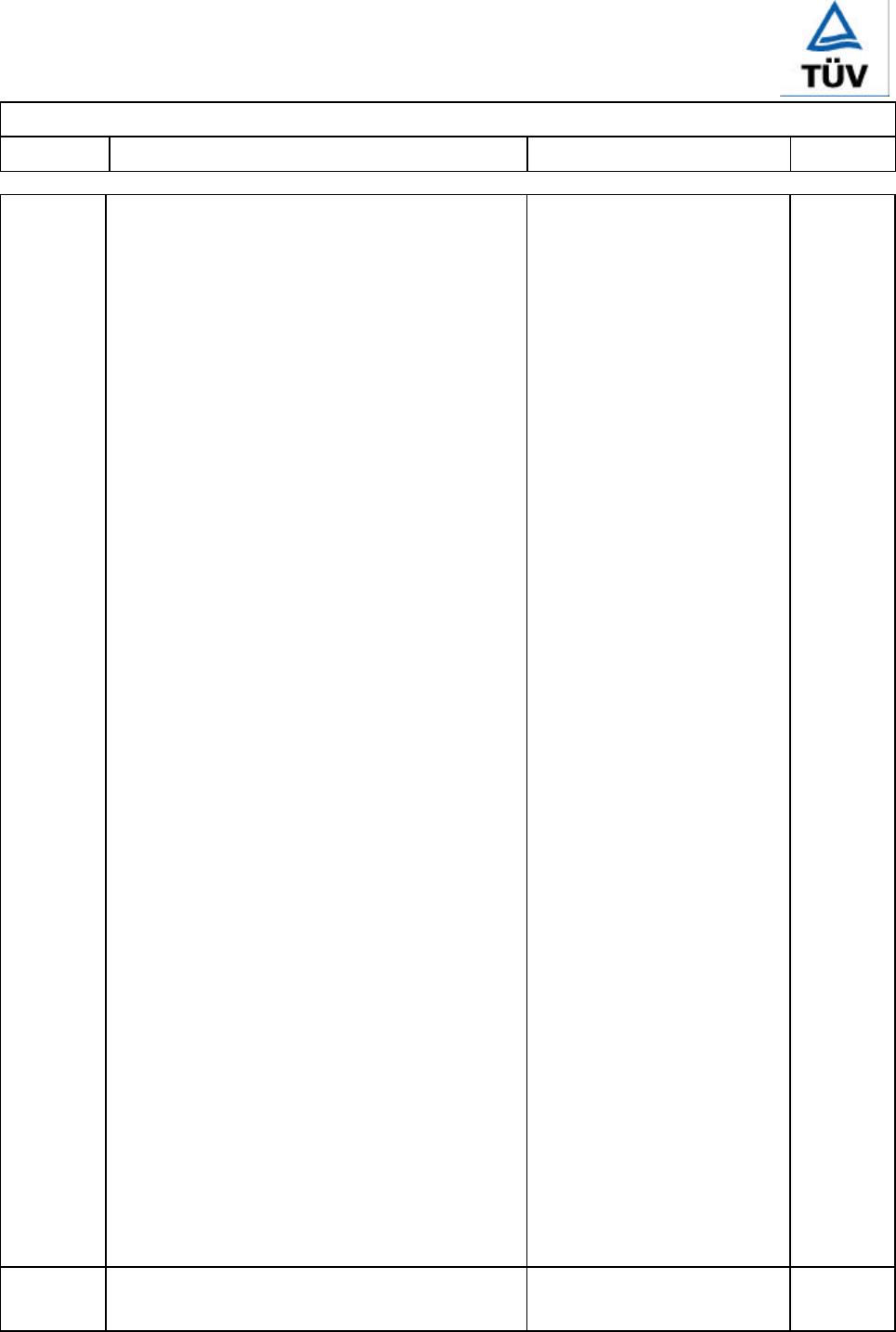
<12002388 001> Page 44
National Deviation
Clause Requirement − Test Result – Remark Verdict
CENELEC common modification, Special National condition, Nation deviation and other information
according to CB Bulletin No. 101A, December 2001
Annex H.
D(DE)
a) A license is required by those who operate an X-
ray emission source.
No CRT. N
b) A license in accordance with clause 1 is not
required by those who operate an X-ray emission
source on which the electron acceleration voltage
does not exceed 20 kV, if
1) the local dose rate at a distance of 0.1m from the
surface does not exceed 1µSv/h and
2) it is adequately indicated on the X-ray emission
source that
i) X-rays are generated and
ii) the electron acceleration voltage must not exceed
the maximum value stipulated by the manufacturer
or importer.
c) A license in accordance with clause 1 is also not
required by persons who operate an X-ray emission
source on which the electron acceleration voltage
exceeds 20 kV, if
1) the X-ray emission source has been granted a
type approval and
2) it is adequately indicated on the X-ray emission
source that
i) X-ray are generated,
ii) the device stipulated by the manufacturer or
importer guarantees that the maximum permissible
local does rate in accordance with the type approval
is not exceeded and
iii) the electron acceleration voltage must not
exceed the maximum value stipulated by the
manufacturer or importer.
d) Furthermore, a license in accordance with clause
1 is also not required by persons who operate X-ray
emission sources on which the electron
acceleration voltage does not exceed 30 kV, if
1) the X-rays are generated only by intrinsically
safety CRTs complying with Enclosure III, No.6,
2) the values stipulated in accordance with
Enclosure III, bi, 6.2 are limited by technical
measures and specified in the device and
3) it is adequately indicated on the X-ray emission
source that the X-rays generated are adequately
screened by the intrinsically safe CRT.
Annex P C Replace the text of this annex by:
See annex ZA.
Replaced. N
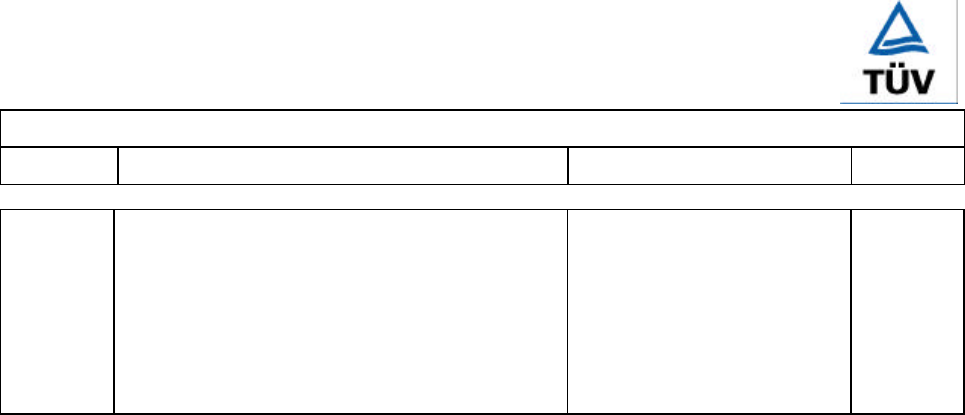
<12002388 001> Page 45
National Deviation
Clause Requirement − Test Result – Remark Verdict
CENELEC common modification, Special National condition, Nation deviation and other information
according to CB Bulletin No. 101A, December 2001
Annex Q C Add for IEC 60529:
Note: Endorsed by EN 60529:1991 (not modified)
Add for IEC 60707
Note: Endorsed by HD441:1983 (not modified)
Add for IEC 61058-1:
Note: Endorsed by EN 61058:1992 (not modified).
Added. N
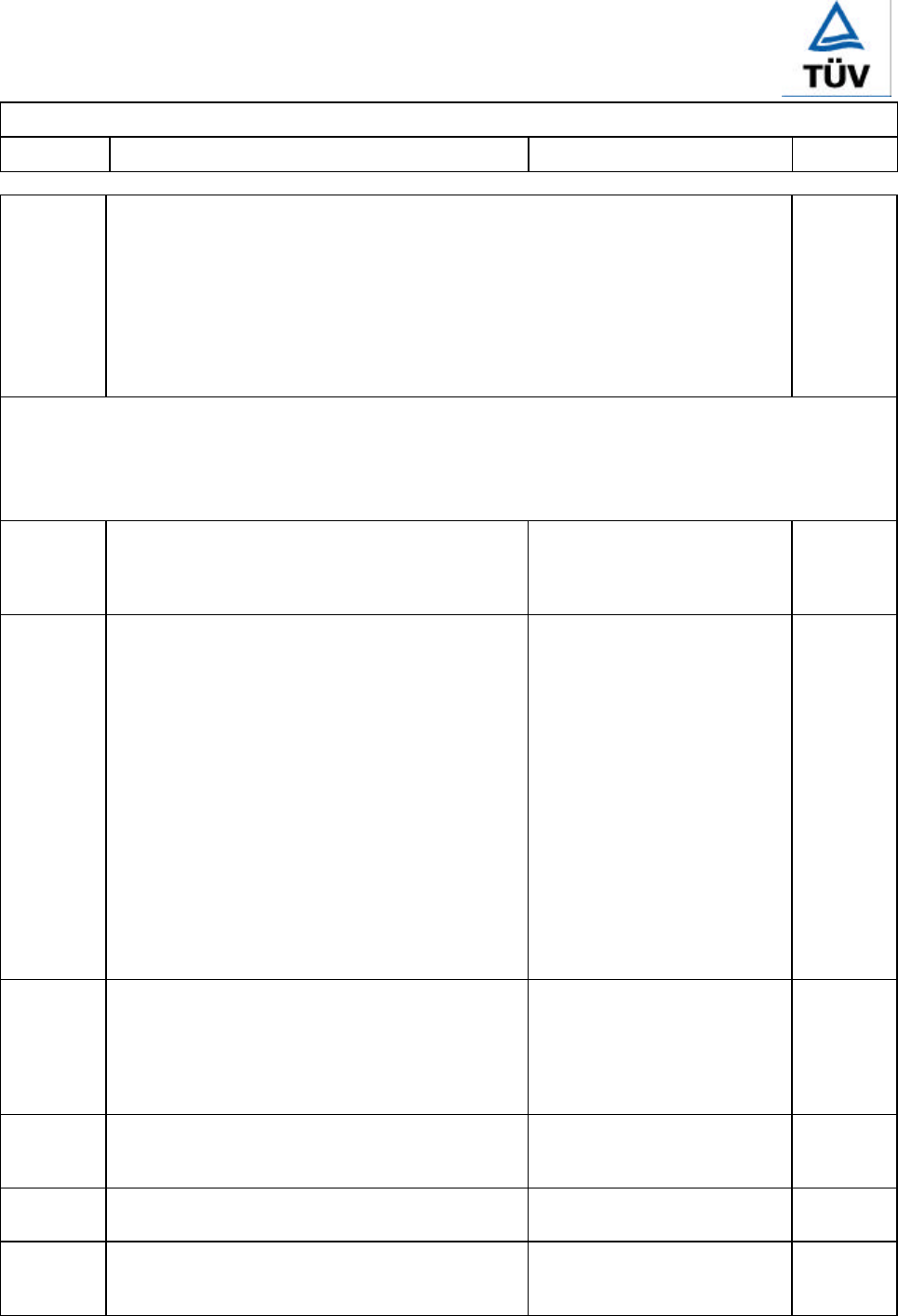
<12002388 001> Page 46
National Deviation
Clause Requirement − Test Result – Remark Verdict
NORDIC Deviation EMKO-TSE(74-SEC)207/94
APPENDIX EMKO-TSE(74-SEC)207/94 TO
EN 60950:1992+A1:1993+A2:1993+A3:1995+A4:1997+A11:1997
TEST REPORT
(IEC Publication 60950 2nd edition, 1991 + Amd.1, 1992 + Amd.2, 1993
+ Amd.3, 1995 + Amd.4, 1996)
Nordic Explanations, and other information not covered by Appendix EN
60950:1992, + A1:1993 + A2:1993 + A3:1995 + A4:1997+A11:1997.
P
EXPLANATION FOR ABBREVIATIONS
NF=Nordic Explanations and other information. DK=Denmark, FI=Finland, NO=Norway,
SE=Sweden.
P=Pass, F=Fail, N=Not applicable. Placed in the column to the right.
1.2.02.01
NF (DK,FI,NO,SE). The heating test of separate power
supplies of personal computers is carried out
according to their rated output values marked on the
power supplies.
No separate power supply of
personal computer. N
1.5.01 NF (DK,FI,NO,SE). The following capacitors are
accepted across the mains:
1) X1 capacitor which complies with Publication IEC
60 384-14.
2) X2 capacitor which complies with Publication IEC
60 384-14 and which has been subjected to a pulse
test according to § 12.11.2, except the value of the
voltage is reduced to 2.5 kV.
3) X2 capacitor which complies with Publication IEC
60 384-14 in case the endurance test of § 12.11.2
has been modified so that the resistor of 220Ω
through which the voltage of 1000 V rms is applied
to the capacitor under test, is short circuited.
4) Capacitor which complies with Publication HD
195 S6, § 14.2.
In approved SPS. P
1.5.02 NF (DK,FI,NO,SE). Transient protection components
shall be installed in such a way that insulation for
protection against electric shock will not be bridge.
This means that transient protection components
must not be connected to safety earthed parts in
pluggable equipment or to other accessible parts.
No transient protection
components connected to
safety earthed parts.
P
-3.2.3 (DK,FI,NO,SE). Interconnection couplers in
accordance with EN 60 320-2-2 are accepted.
Outlets of non-standard types are not accepted.
No outlet. N
1.7.01 NF -1st dash (DK). When supplied in Denmark the
appliances shall be set to 230 V . Included in the voltage range. P
-5th dash (DK). The equipment may instead be
provided with a marking indicating name, trade-mark
or identify of the responsible vendor.
Refer to CB report page 4. P
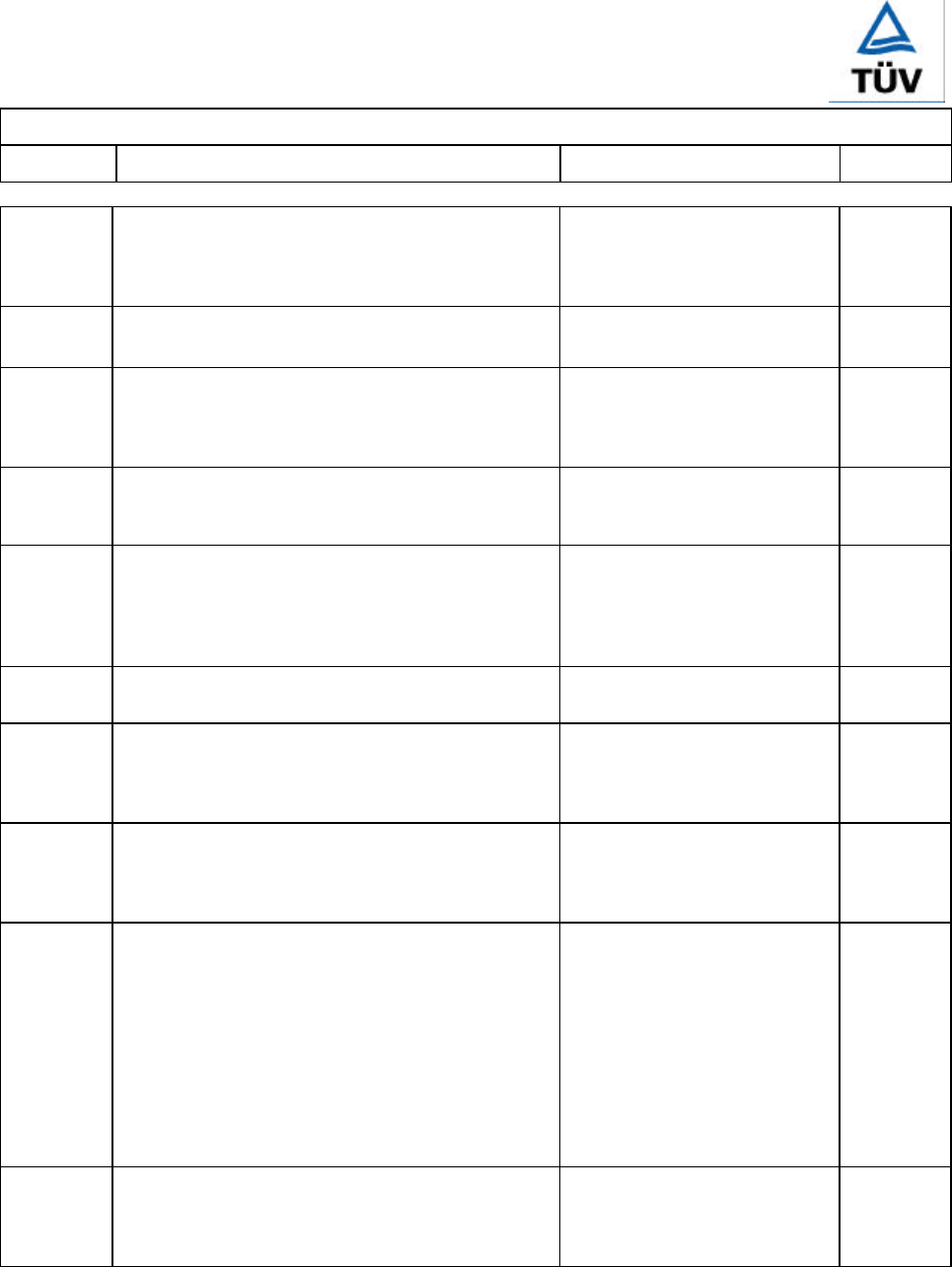
<12002388 001> Page 47
National Deviation
Clause Requirement − Test Result – Remark Verdict
NORDIC Deviation EMKO-TSE(74-SEC)207/94
2.1.04 NF (DK,FI,NO,SE). For monitors, warning label is not
required for repairing area, neither the partial
shielding against contact although the voltage is>
42.4 V peak or > 60 V d.c.
No monitor. N
2.5.11 NF (DK,FI,NO,SE). Due to installation fuses of 16A, the
earth resistance shall always be controlled at 25 A. Earthing test conducted at
25A, see IEC 60950 report. P
2.6.06 NF (DK,FI,NO,SE). The plug is regarded to be a
disconnect device and therefore a single pole mains
switch is acceptable (TC 74-WG 8's
recommendation).
Appliance inlet is considered
as disconnect device. N
2.6.11 NF (DK,FI,NO). The warning label on an appliance with
two or several supply connections shall be in the
official language of the country in question.
Only one supply from the
mains. N
(DK,FI,NO). UPS-appliances can be fitted with a
signal lamp instead of a warning label, under the
condition that the function and location of the signal
lamp is correct. Audible signal is not acceptable as
warning.
Equipment is not a UPS. N
2.7.03 NF (DK,FI,NO,SE). A single-pole protective device is
acceptable. Only one fuse on live phase. P
2.9.01 NF (DK,FI,NO,SE). Pollution Degree 3 is considered
applicable for the following equipment which is
within the scope of this standard: Document
Shredder Machines.
Equipment is not a shredding
machine N
4.2.07 NF (DK,FI,NO,SE). If there are visible cracks on the
apparatus after the mechanical strength test, the
apparatus is not rejected, if it still complies with the
other requirements of subclause 4.2.7.
Metal enclosure. N
4.4.04 NF (DK,FI). Fire enclosure is required if the available
power exceeds the values of a limited power source.
The limited power source shall incorporate an
isolating transformer and shall comply with the
following:
* The open-circuit voltage shall not exceed
42.4 V peak or d.c. and shall not generate
voltages above the value and
* The current which may be drawn for more than
two minutes at any load, including short-circuit,
shall not exceed 0.2 A.
Supplied from the mains. N
(NO). A fire enclosure is not required in spots of the
equipment where the available power does not
exceeded 50 VA and the available voltage 42.4 V
(peak) or 60 V d.c.
dto. N
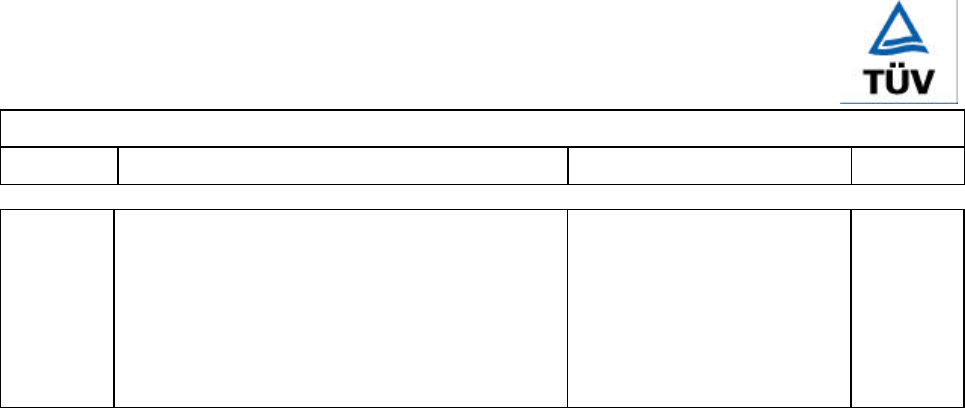
<12002388 001> Page 48
National Deviation
Clause Requirement − Test Result – Remark Verdict
NORDIC Deviation EMKO-TSE(74-SEC)207/94
5.4.06 NF (DK,FI,NO,SE). Faults need not to be carried
out in circuits which are supplied by an isolating
transformer and which comply with the following:
* The open-circuit voltage shall not exceed 42.4 V
peak or d.c. and shall not generate voltages above
the value and
* The current which may be drawn for more than
two minutes at any load, including short-circuit,
shall not exceed 0.2 A.
Supplied from the mains. N
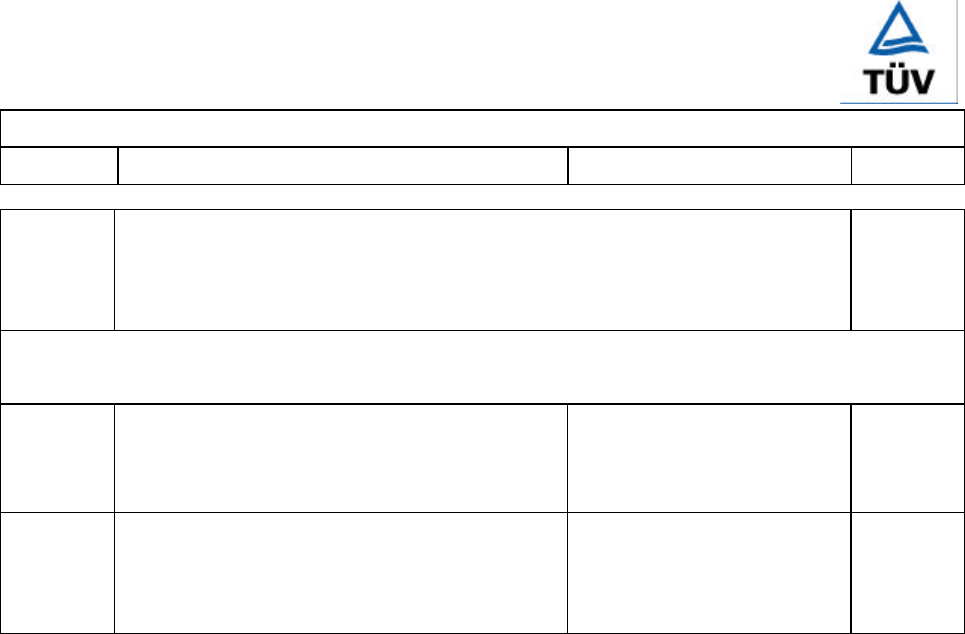
<12002388 001> Page 49
National Deviation
Clause Requirement − Test Result – Remark Verdict
China National Differences according to CB Bulletin, No. 101A, December 2001
APPENDIX China National Differences according to CB Bulletin, No. 101A, December
2001
REPORT (IEC Publication 60950 2nd edition, 1991 + Amd.1, 1992 +
Amd.2, 1993 + Amd.3, 1995 + Amd.4, 1996)
P
EXPLANATION FOR ABBREVIATIONS
P=Pass, F=Fail, N=Not applicable. Placed in the column to the right.
1.4.5,
1.6.5 The minimum supply tolerance is –10%, +6%;
GB4943 sub-clause 1.4.5 and 1.6.5: The
minimum supply tolerance is –10%, +10%
according to Chinese situation.
N
General IEC standard for plug is IEC 60083.
The Chinese National standard for Plugs is
GB1002-1996, which is not equivalent with
IEC60083.
No power supply cord
provided. N
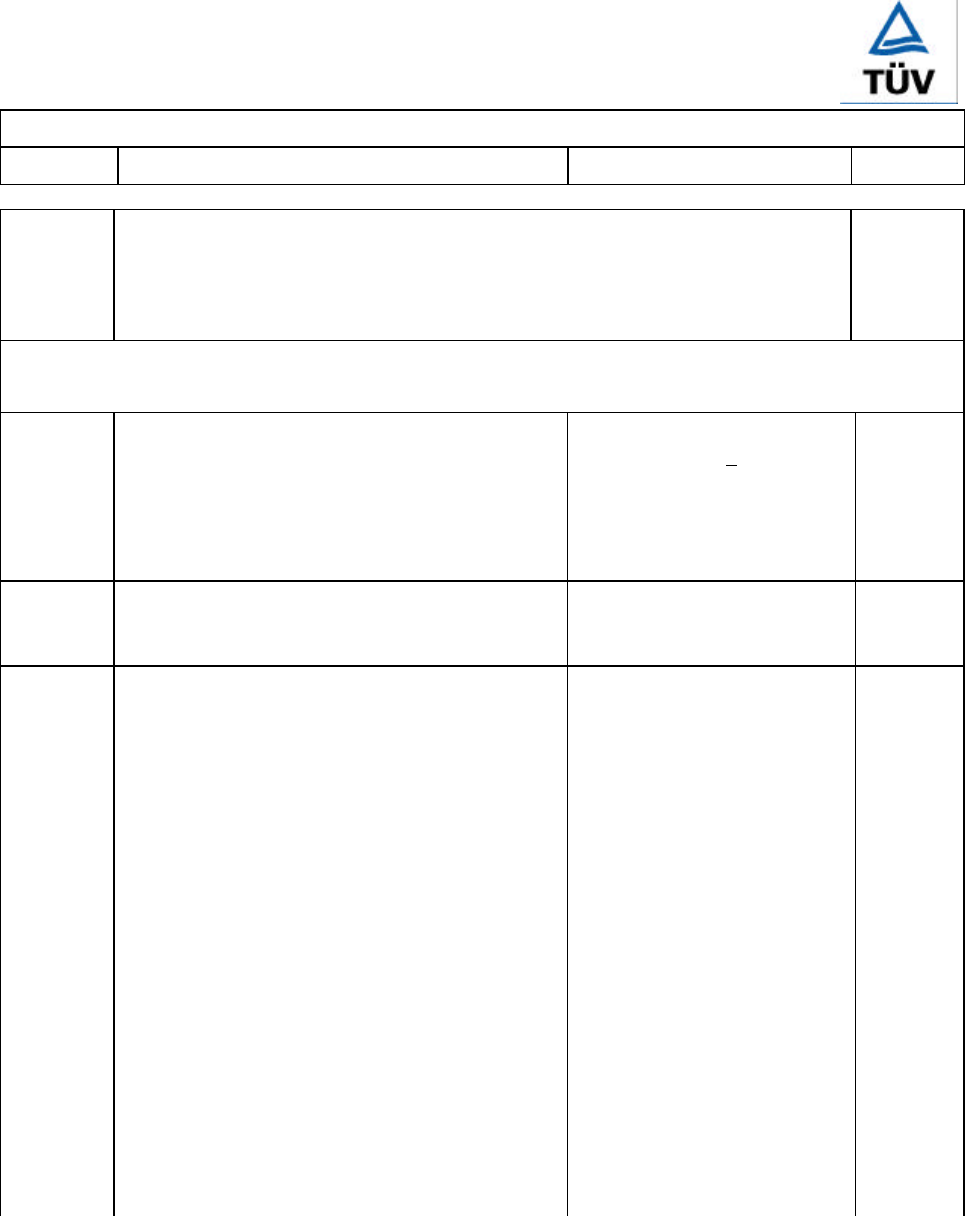
<12002388 001> Page 50
National Deviation
Clause Requirement − Test Result – Remark Verdict
Japanese national Differences according to CB Bulletin No. 101A, December 2001
APPENDIX Japanese National Differences according to CB Bulletin No. 101A, December
2001
REPORT (IEC Publication 60950 : 1991 + A1 + A2 + A3 + A4)
P
EXPLANATION FOR ABBREVIATIONS
P=Pass, F=Fail, N=Not applicable. Placed in the column to the right.
2.9.2.1 Delete entire column headed by [Nominal mains
supply voltage ≤150V (Transient rating 1500V)] in
Table 3.
Delete >150V from column headed by “Nominal
mains supply voltage >150V, ≤300V (Transient
rating 2500V)” in Table 3.
Clearance distance from
column 2 taken (≤300V) P
2.9.2.2 Delete entire column headed by “Nominal mains
supply voltage ≤150V (Maximum transient in
secondary circuit 800V see condition 6)” in Table 5
Clearance distance from
column 2 taken (≤300V) P
2.9.4.4 Replacement: The following shall replace the entire
existing paragraphs:
Title: Wounded components
BASIC, SUPPLEMENTARY, DOUBLE or REINFORCED
INSULATION is permitted in a wounded component
using one of the following a), b), or c) constructions
or the wounded component must use interleaved
insulation which complies with 2.9.4.1 or 2.9.4.2:
a) the winding wire is insulated with insulation
complying with 2.9.4.1 other than solution
based type enamel coatings.
b) the winding wire is insulated with extruded
multi-layers or wrapped layers of tape (each
layer can be tested for electric strength) which
complies with 2.9.4.1 and complies with annex
U.
c) the winding wire is insulated with extruded
multi-layers or wrapped layers of tape (test can
be only performed on finished winding wire) and
complies with annex U.
Different Japanese standard
text considered. N
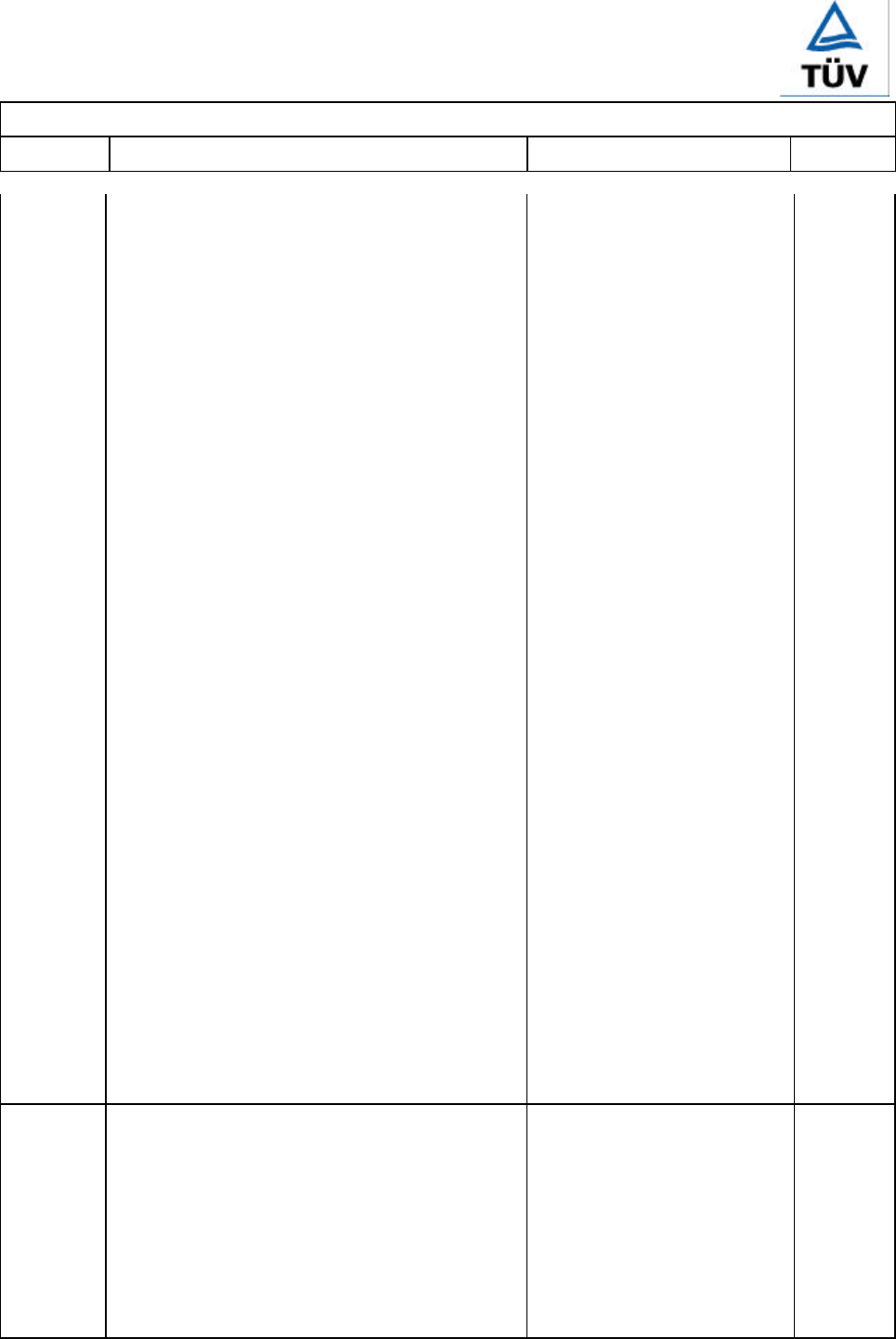
<12002388 001> Page 51
National Deviation
Clause Requirement − Test Result – Remark Verdict
Japanese national Differences according to CB Bulletin No. 101A, December 2001
Note 1 – see also 6.4.1.
As to c), the number of constructional layers applied
to the conductor to determine the grade of
insulation of the winding wire shall not be less than
as follows:
-if BASIC INSULATION is required, a minimum of
two layers or one extruded layer
-if SUPPLEMENTARY INSULATION is required, a
minimum of two layers or two extruded layers
-if REINFORCED INSULATION is required, a
minimum of three layers or three extruded
layers
As to b) and c), in case the CREEPAGE DISTANCES
between wrapped layers of tape are less than Table
6 under Pollution degree 1, the distance between
layers must be reliably cement together with
insulation compound complying with 2.9.7 and with
the test voltage in annex U.2 (Type tests) increased
to 1.6 times.
Note 2 – In case one layer of material is wrapped
50% or more, it is considered as two layers
Where two insulated wires or one bare wire and one
insulated wire are contacted inside the component
and cross each other at an angle between 45° and
90°, physical separation shall be provided, for
example in the form of insulating sleeving or sheet
material, or by applying two times of the specified
insulating layer(s), to relieve mechanical stress at
the crossover point.
The finished component shall pass ROUTINE
TESTING for electric strength using the value of test
voltage in 5.3.
Compliance is checked by visual inspection and
measurement, and as specified in annex U.
However, the tests are not repeated if the material
data sheets confirm compliance with annex U.
5.1 Addition:
Add the following to 5) as specified in “Conditions
applicable to table 16, parts 1 and 2”
With regards to 1), insulating materials complying
with Japanese requirement (Refer to Japanese
difference for current IEC 60335-1 (3rd Edition) in
CB Bulletin 94B), can be taken of data for that
material to determine the appropriate maximum
temperature rise.
For other than those complied
with IEC standards, refer to
added condition 8) below.
P
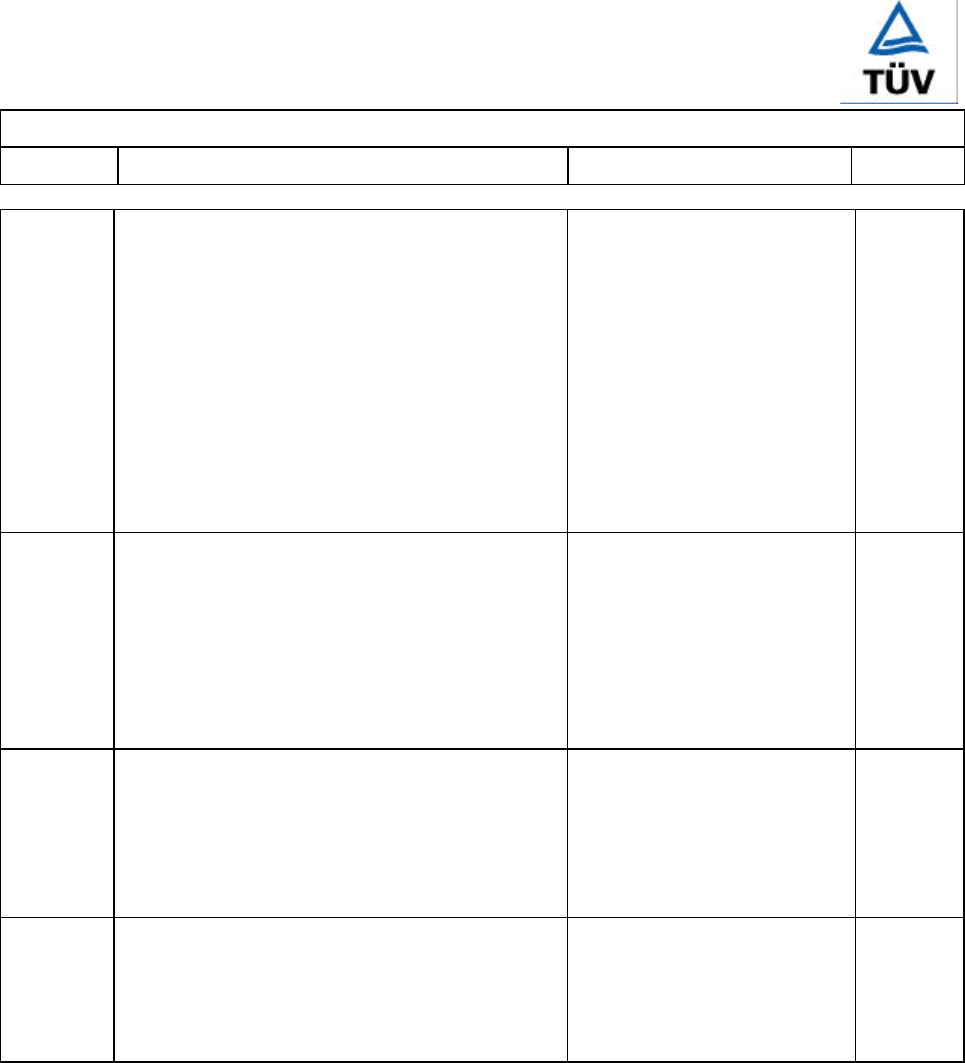
<12002388 001> Page 52
National Deviation
Clause Requirement − Test Result – Remark Verdict
Japanese national Differences according to CB Bulletin No. 101A, December 2001
Annex U Replacement:
ANNEX U (normative)
Insulated winding wires for use without interleaved
insulation (see 2.9.4.4)
This annex specifies winding wire whose insulation
may be used to provide BASIC, SUPPLEMENTARY
or REINFORCED INSULATION in wound components
without interleaved insulation.
This annex applies to round winding wire whose
diameter is between 0.2mm and 1.00mm. With
regard to other size, refer to IEC 60851.
Replaced N
U.1 Wire construction
If the wire is insulated with two or more spirally
wrapped layers of tape, the overlap of layers shall
be adequate to ensure continued overlap during
manufacture of the wound component. In order to
maintain the overlap of layers, wire insulation layer
of wrapped layers of tape must be adequately
secured.
N
U.2 Type tests
Unless it specifies, the wire shall pass the following
six TYPE TESTS U.2.1 to U.2.4, carried out at a
temperature between 15°C and 35°C and a relative
humidity between 45% and 75%. Refer to the IEC
60851 first edition.
N
U.2.1 Electric strength
Test 13 of IEC 60851-5 (1988), 4.3.1 (test for
twisted wire pairs), with a test voltage 2 times of
appropriate voltage in Table 18 of this standard or
6kVr.m.s. whichever is the greater.
N
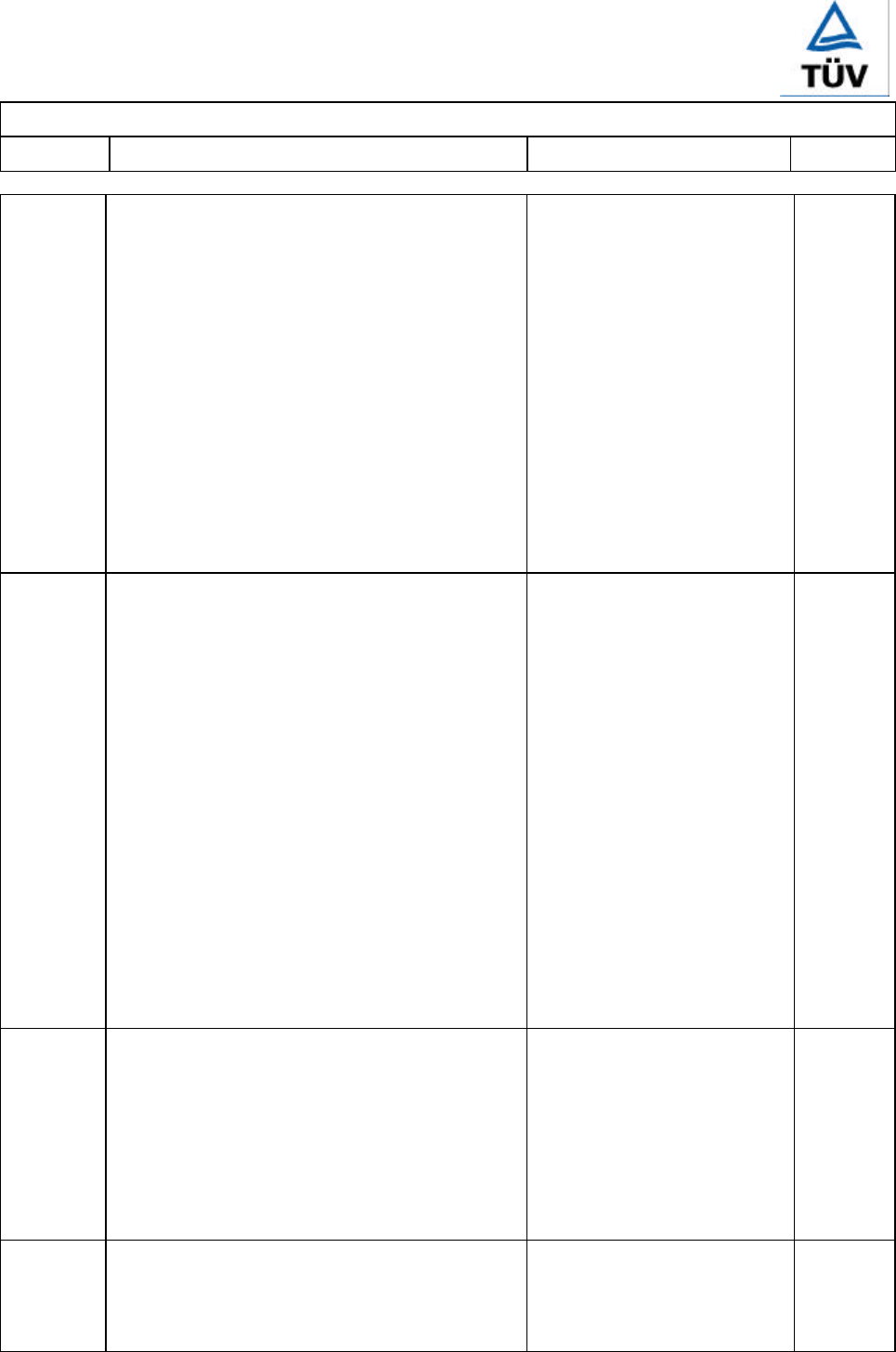
<12002388 001> Page 53
National Deviation
Clause Requirement − Test Result – Remark Verdict
Japanese national Differences according to CB Bulletin No. 101A, December 2001
U.2.2 Adherence and flexibility
Test 8 of IEC 60851-3, with a test voltage not less
than the appropriate voltage in Table 18 of this
standard or 3kVr.m.s. whichever is the greater.
Table U.2.2.2 – Mandrel
Nominal diameter of Mandrel diameter
conductor (mm) (mm±0.2mm)
0.20 – 0.34 4.0
0.35 – 0.49 6.0
0.50 – 0.74 8.0
0.75 – 1.00 10.0
The tension of winding wire while wire is wrapped
around the mandrel, should be calculated so that it
is equivalent to 118MPa±10% (118N/mm²±10%)
from winding wire radial.
N
U.2.3 Heat shock
Test 9 of IEC 60851-6, 3.1 and IEC 60851-3,
5.1.1.1, with a test voltage not less than the
appropriate voltage in Table 18 of this standard or
3kVr.m.s. whichever is the greater.
The temperature of oven is specified in the following
Table U.2.3.
Table U.2.2 shows and explains required mandrel
diameter and tension.
Test must be performed at room ambient after
taking out from oven.
N
Table U.2.3 – Oven Temperature
Class AEBFH
(105) (120) (130) (155) (180)
Oven 200 215 225 240 260
Temp.
(°C±2°C)
U.2.4 Retention of electric strength after
bending
Test 13 of IEC 60851-5 (1988), 4.6.1 c, with a test
voltage not less than the appropriate voltage in
Table 18 of this standard or 3kVr.m.s. whichever is
the greater.
Table U.2.2 shows and explains required mandrel
diameter and tension.
N
U.3 Routine test
Winding wire is subjected to electric strength test
during the production in accordance with U.3.1 and
U.3.2 by wire manufacturer.
N
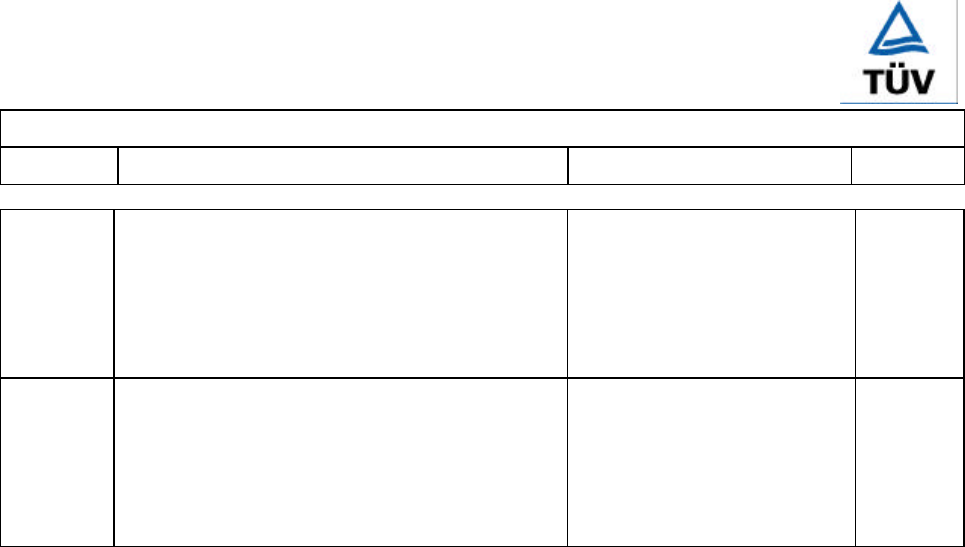
<12002388 001> Page 54
National Deviation
Clause Requirement − Test Result – Remark Verdict
Japanese national Differences according to CB Bulletin No. 101A, December 2001
U.3.1 Full-length test
Winding wire is subjected to electric strength test
during the production for full wire length, with a
test voltage not less than the appropriate voltage in
Table 18 of this standard or 3kVr.m.s. or 4.2kV
peak minimum.
N
U.3.2 Audit test
Test must be carried out according to IEC 60851-5
(1988) for twisted wire pairs. Electric strength test,
with a test voltage 2 times of appropriate voltage in
Table 18 of this standard or 6kVr.m.s. or 8.4kV
peak minimum.
N
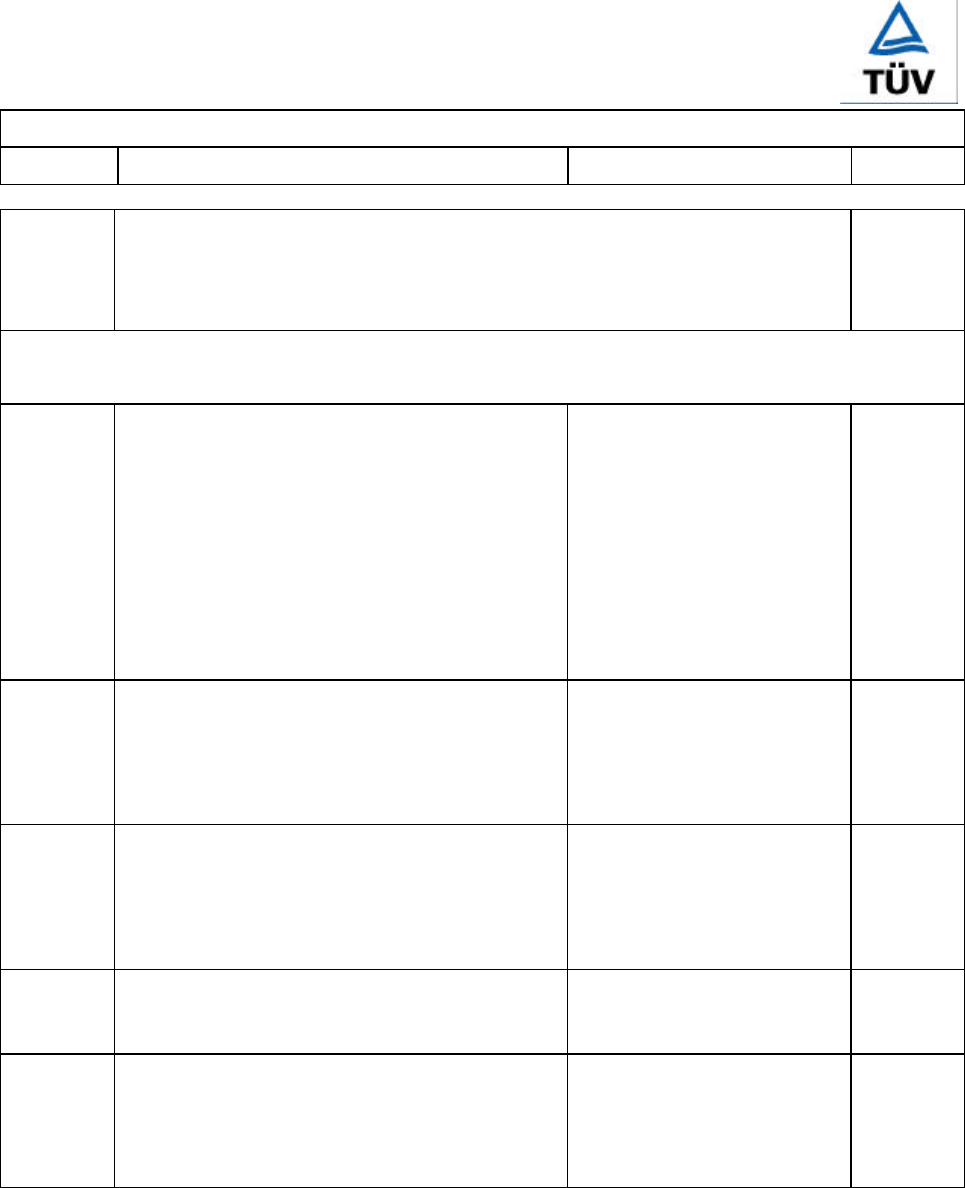
<12002388 001> Page 55
National Deviation
Clause Requirement − Test Result – Remark Verdict
Korean National Differences according to CB Bulletin, No. 101A, December 2001
APPENDIX Korean National Differences according to CB Bulletin, No. 101A, December
2001
REPORT (IEC Publication 60950 2nd edition, 1991 + Amd.1, 1992 +
Amd.2, 1993 + Amd.3, 1995 + Amd.4, 1996)
P
EXPLANATION FOR ABBREVIATIONS
P=Pass, F=Fail, N=Not applicable. Placed in the column to the right.
General LIMITATIONS - Voltage ratings
As national supply voltage is subject to be
increased to 220V, an appliance rated 220V is
to be allowed to obtain type approval in Korea.
Either an appliance rated 110V or 220/110V is
not allowed. When an appliance is supplied in
Korea, it shall be set to and marked with 220V.
But free voltage appliance by SMPS (Switching
Mode Power Supply) is allowed and it shall be
marked with “100-220V”.
Rated 100-240Vac and auto
voltage select design. P
General LIMITATIONS – Frequency
Only appliances having supply frequency of
60Hz or a frequency range including 60Hz are
accepted. When an appliance is supplied in
Korea, it shall be set to and marked with 60Hz.
Frequencies of 47-63Hz. P
General LIMITATIONS - Instruction
Instruction manuals and appliance markings
related to safety, including nameplate shall be
in Korean or graphical symbols in IEC
Publication 60417.
Instruction manual will be in
Korean. N
1.5.101 Addition: Plugs for the connection of the
apparatus to the supply mains shall comply
with the Korean requirements (KSC 8305).
No power cord provided. N
7Addition:
Radio frequency interference
The apparatus shall comply with the relevant
CISPR requirements.
The CISPR requirements
have to be evaluated when
submitted for national
approval.
N
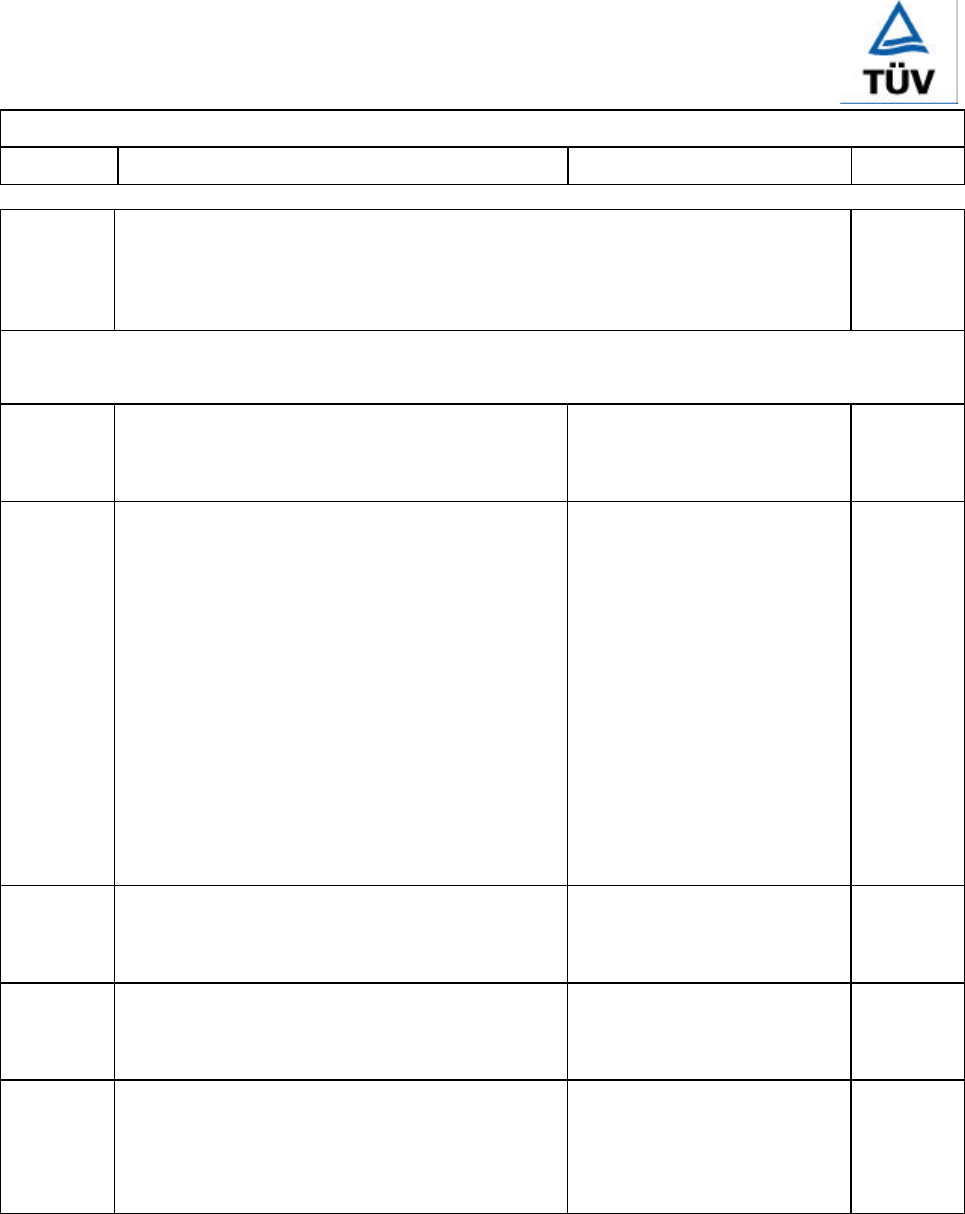
<12002388 001> Page 56
National Deviation
Clause Requirement − Test Result – Remark Verdict
Israel National Differences according to CB Bulletin, No. 101A, December 2001
APPENDIX Israel National Differences according to CB Bulletin, No. 101A, December
2001
REPORT (IEC Publication 60950 2nd edition, 1991 + Amd.1, 1992 +
Amd.2, 1993 + Amd.3, 1995 + Amd.4, 1996)
P
EXPLANATION FOR ABBREVIATIONS
P=Pass, F=Fail, N=Not applicable. Placed in the column to the right.
1.2.12.1 TN Power Distribution:
The mains system in Israel is TN-S or TN-C or
TN-C-S.
Considered. P
1.7 Marking and Instructions:
The package of the equipment shall be marked
in Hebrew, and shall include:
(a) The name of the manufacturer
(b) The country of production
(c) The year of production
(d) The name and the address of the importer
(e) The marking shall be on a rectangular label
(of at least 50mm X 24mm)
(f) The letters height should be at least 2mm
(g) The color of the label shall be in contrast to
the color of the package.
Shall be evaluated in national
mark approval. N
1.7.14 Language:
All instructions and warnings concerning safety
should be in the Hebrew language
Shall be evaluated in national
mark approval. N
2.101 EMC:
The equipment shall comply with SI 961 part 6
(CISPR 22 + 24)
Shall be provided and
evaluated in national mark
approval.
N
3.2.2 Permanently connected equipment:
Additional note below table 10:
In Israel the diameter of the conduit shall
comply with the Electricity Law.
N
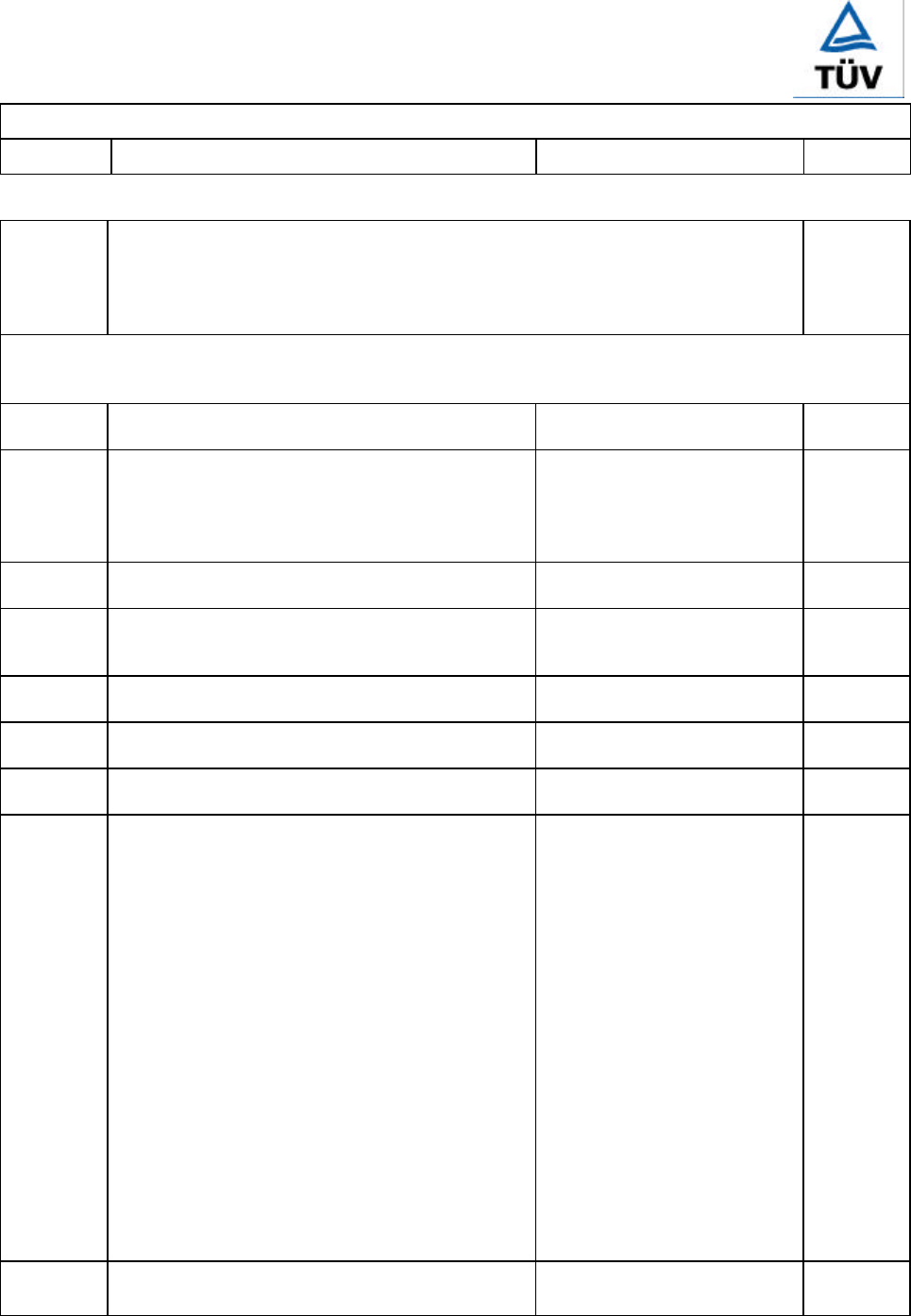
<12002388 001> Page 57
National Deviation
Clause Requirement − Test Result – Remark Verdict
Australian National Differences according to CB Bulletin No. 101A, December 2001
APPENDIX Australian National Differences according to CB Bulletin No. 101A, December
2001 (AS/NZS 3260-1993)
REPORT (IEC Publication 60950 2nd edition, 1991 + Amd.1, 1992 +
Amd.2, 1993 + Amd.3, 1995 + Amd.4, 1996)
P
EXPLANATION FOR ABBREVIATIONS
P=Pass, F=Fail, N=Not applicable. Placed in the column to the right.
1.2.12.2 Add: “TT power systems are not permitted in
Australia or New Zealand.” Added. N
1.2.12.3 Add: “IT power systems are not permitted in
Australia or New Zealand.”
Note: Australia and New Zealand principally use
multiple-earthed neutral (MEN) systems but allow
TN-C for installations using metal-sheathed cables.
Added. N
1.5.1 Add to paragraph 1: “or the other relevant
Australian or New Zealand Standard.” Added. P
1.5.2 Add to the first and third dashed items after the
words “IEC component standard”: “or the other
relevant Australian or New Zealand Standard.”
Added. P
1.7.14 Add to paragraph 1: “In Australia and New Zealand
all safety instructions shall be in English.” User manual is in English. P
2Add after clause 2: “For the limit of direct current
from a.c. appliances, refer to AS/NZS Appendix 3.” See Appendix 3. N
3.2.2 Substitute for table 10: “For sizes of cables and
conduits in Australia, refer to AS 3000.” No power cord provided. N
3.2.4 Substitute for table 11: “For sizes of conductors in
power supply cords use following Table 11:
Table 11
Sizes of conductors in power supply cords
Rated current (A) Cross-section area (mm2)
> 0.2 ≤ 3 0.5*
> 3 ≤ 7.5 0.75
> 7.5 ≤ 10 1
> 10 ≤ 16 1.5
> 16 ≤ 25 2.5
> 25 ≤ 32 4
> 32 ≤ 40 6
> 40 ≤ 63 10
* This nominal cross-section area is only allowed for
class II appliances if the length of the power supply
cord, measured between the point where the cord,
or cord guard, enters the appliance, and the entry to
the plug, does not exceed 2m (0.5mm2 three-core
supply flexible cords are not permitted; see Note 2
to table 2.17 of AS/NZS 3191).
No power cord provided. N
4.4.1 For the Australian alternative resistance to fire test,
refer to Appendix 2.” Not applied for Appendix 2. N
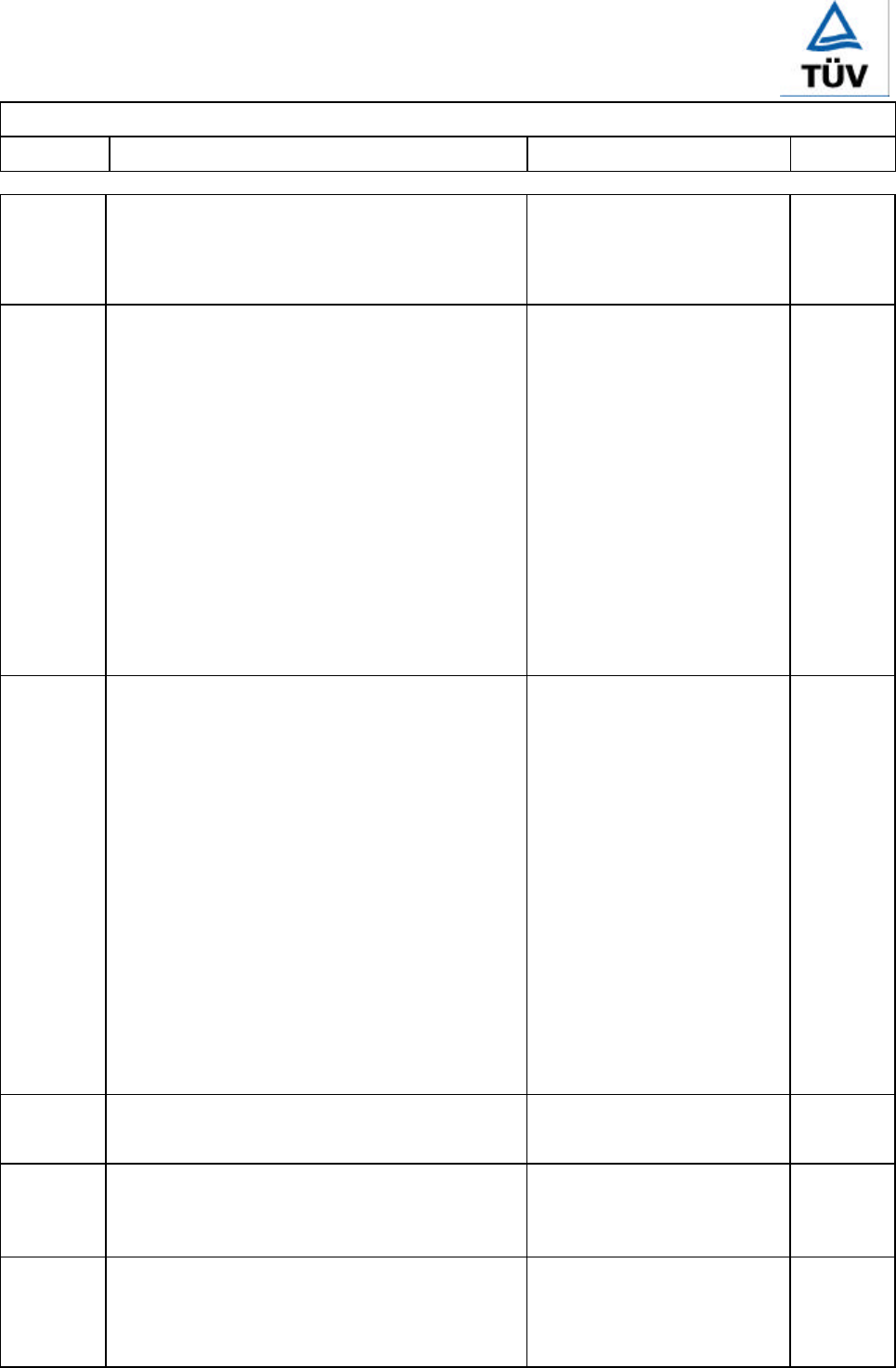
<12002388 001> Page 58
National Deviation
Clause Requirement − Test Result – Remark Verdict
Australian National Differences according to CB Bulletin No. 101A, December 2001
6.4.2 Replace the first paragraph by: “In Australia,
compliance with 6.4.1 is checked by both the test
of 6.4.2.1 and 6.4.2.2”.
Delete the fourth paragraph ‘The choice of
tests....manufacturer’.
No TNV. N
6.4.2.1 Replace Clause 6.4.2.1 by:
Impulse test The electrical separation is subjected to
ten impulses of alternating polarity, using the
impulse test generator of Annex N. The interval
between successive impulses is 60s and the initial
voltage Uu is:
- in case (a) of 6.4.1, 7kV for hand-held telephones
and for handsets; and 2.5kV for other equipment;
and
- in case (b) and (c) 1.5kV.
Notes:
1 The 7 kV impulse is to simulate measured lighting
surges in typical Australian rural and semi-rural
network lines.
2 The value of 2.5kV has been chosen primarily to
ensure adequacy of the insulation concerned, but
not necessarily to simulate likely overvoltages.
No TNV. N
6.4.2.2 Replace Clause 6.4.2.2 by:
Electric strength test The electrical separation is
subjected for 60s to a substantially sinusoidal
voltage having a frequency of 50Hz or 60Hz, or to a
d.c. voltage equal to the peak value of the
prescribed a.c. voltage.
The a.c. test voltage is:
- in case (a) of 6.4.1 3kV
- in case (b) and (c) 1.5kV.
The voltage is gradually raised from zero to the
prescribed voltage and then held at that value for
60s.
NOTE:
1. Where there are capacitors across the insulation
under test, it is recommended that d.c. test voltages
are used.
2. The 3 kV and 1.5kV values have been
determined considering the low frequency induced
voltages from the power supply distribution system.
No TNV. N
Annex A Add. after Annex title:
Alternative resistance to fire test-determination if
ignitability and combustion propagation
Not applied for this Appendix. N
Appendix
2Add. Appendix
ALTERNATE RESISTANCE TO FIRE TEST
DETERMINATION OF IGNITABILITY AND
COMBUSTION PROPAGATION
Not applied for this Appendix. N
X2.0 GENERAL
This test is an alternative to the testes in Annex A
to allow approval of equipment which has
inadequate documentation to verify having been
tested to Annex A.
N
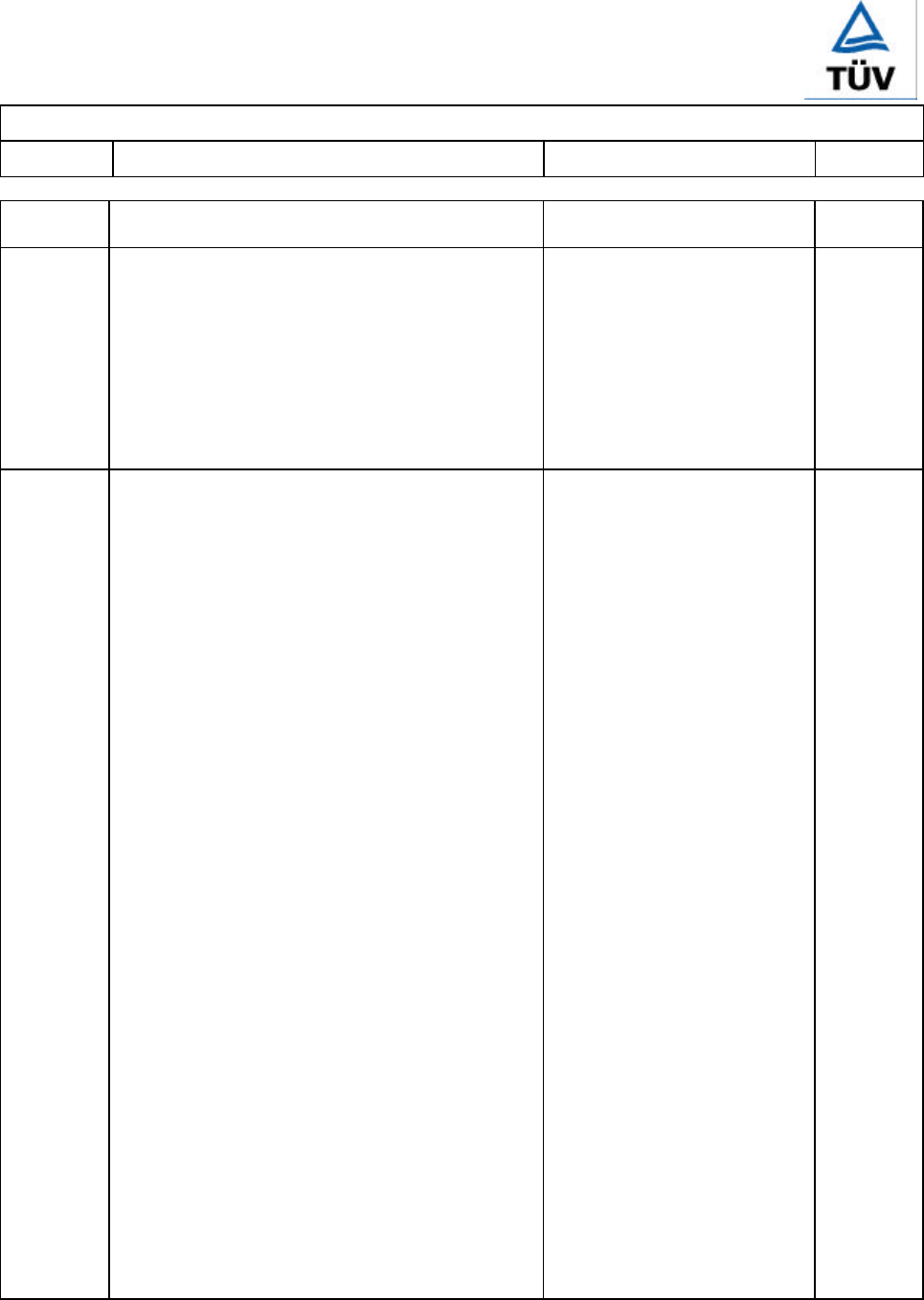
<12002388 001> Page 59
National Deviation
Clause Requirement − Test Result – Remark Verdict
Australian National Differences according to CB Bulletin No. 101A, December 2001
X2.1 SOLID INSULATION MATERIALS AND NON-
METALLIC ENCLOSURES N
X2.1.1 GENERAL REQUIREMENTS Parts of non metallic
material shall be resistant to ignition and spread of
fire.
This requirement does not apply to decorative trims,
knobs wiring insulation and other parts not likely to
be ignited or to propagate flames from inside the
equipment.
Compliance is checked by the tests of Clauses
X2.1.2, X2.1.3 and X2.1.4 as applicable and if
necessary by the test of X2.2
N
X2.1.2 NON-METALLIC MATERIAL
Relevant parts of non-metallic material are subjected
to the glow-wire test of AS/NZS 3350.1, the test
being made at a temperature of 550°C.
The 550°C glow-wire test need not be carried out
on parts which are made of material classified as FH
3-40 mm/min or better according to IEC 60707. The
sample of material submitted to the test of IEC
60707 shall be thicker than the relevant part.
Insulating material of winding bobbins and formers
are subject to the glow-wire test of AS/NZS
3350.1, the test being made a temperature of
650°C.
Base material of printed circuit boards with any
coating or encapsulation to the needle-flame test of
AS/NZS 3350.1, however, flames shall have
extinguished with 15s of removal of the test flame.
The flame shall be applied to an edge of the board
having the lowest heat sink effect, with the board
orientated in its normal position of use and at a
point, if possible, not less than 10mm from a
corner.
The needle-flame test is not carried out on base
material which is made of material classified as FV-0
according to IEC 60707. The sample of material
submitted to the test of IEC 60707 shall be no
thicker than that of the relevant printed circuit
board.
Notes:
1. The test is not carried out on printed circuit
boards contained in a metal enclosure that
prevents flames or burning droplets from
escaping.
2. If the printed circuit board is tested with
components mounted and a component ignites
during the test, this would not constitute a
failure of the printed circuit board material
unless it is ignited by the component.
N
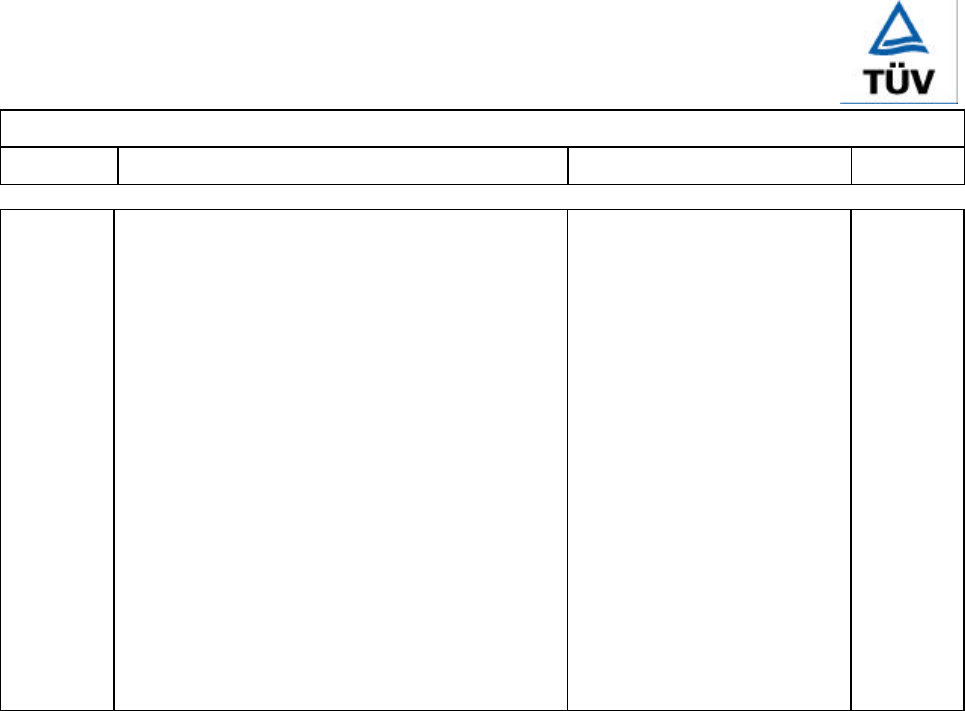
<12002388 001> Page 60
National Deviation
Clause Requirement − Test Result – Remark Verdict
Australian National Differences according to CB Bulletin No. 101A, December 2001
X2.1.3 ATTENDED EQUIPMENT
For equipment which is operated while attended,
parts of insulating material supporting, in contact
with or in close proximity to current carrying
connections, other than those in SELV circuits are
subject to the glow-wire test AS/NZS 3350.1, the
test being made at a temperature of 650°C.
However parts of insulating material supporting, in
contact with or in close proximity to screw
connections which carry a current exceeding 0.5A
during normal operation and which are likely to be
made or remade during installation, user
maintenance or when replacing a supply cord
assembled with the appliance by Type X
attachment, are subject to the glow-wire test
AS/NZS 3350.1, the test being made at a
temperature of 750°C.
N
Notes:
1. The test is not carried out on parts supporting
welded connections.
2. ‘In close proximity’ is considered to be a
distance not exceeding 3mm.
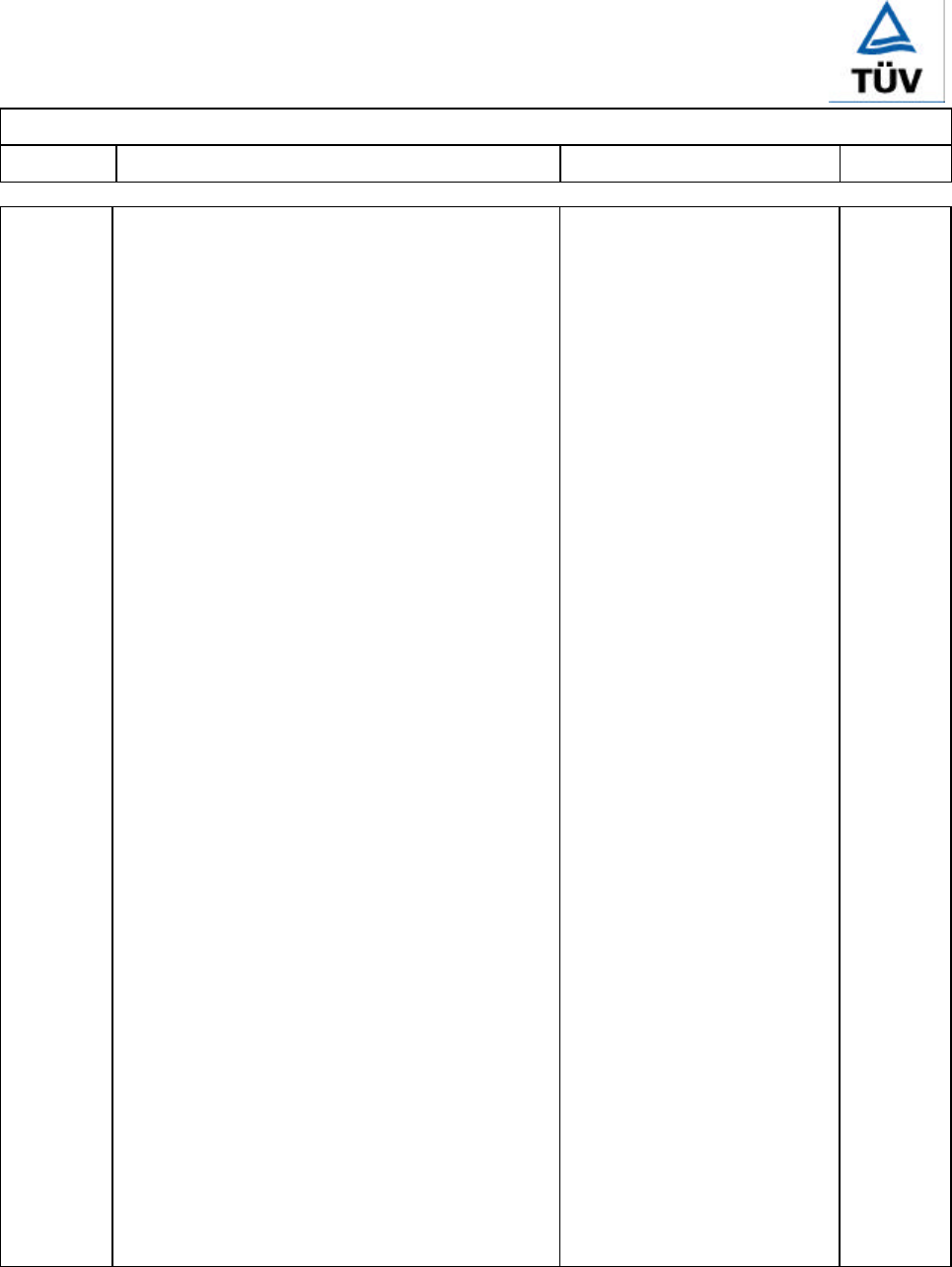
<12002388 001> Page 61
National Deviation
Clause Requirement − Test Result – Remark Verdict
Australian National Differences according to CB Bulletin No. 101A, December 2001
X2.1.4 UNATTENDED EQUIPMENT
For equipment which is operated while unattended,
parts of insulating material supporting, in contact
with or in close proximity to current carrying
connections, other than those in SELV circuits are
subject to the glow-wire test AS/NZS 3350.1, the
test being made at a temperature of 750°C.
However parts of insulating material supporting, in
contact with or in close proximity to screw
connections which carry a current exceeding 0.5A
during normal operation and which are likely to be
made or remade during installation, user
maintenance or when replacing a supply cord
assembled with the appliance by Type X
attachment, are subject to the glow-wire test
AS/NZS 3350.1, the test being made at a
temperature of 850°C.
Notes:
1. The test is not carried out on parts supporting
welded connections.
2. ‘In close proximity’ is considered to be a
distance not exceeding 3mm.
During the application of glow-wire, the height and
duration of flames are measured.
In addition, for parts which withstand the glow-wire
test but which flame during the application of the
glow-wire, the surrounding parts are subject to the
needle-flame test of AS/NZS 3350.1 for the
measured duration of the flame after or 30s,
whichever is the least if -
a) They are positioned within a distance equal to the
height of the flame; and
b) they are likely to be impinged upon by the flame
However, surrounding parts shielded by a separate
barrier which meets the needle-flame test are not
tested.
The needle-flame test is not carried out on parts
which are made of material classified as FV-0 or FV-
1 according to IEC 60707. The sample of material
submitted to the test of IEC 60707 shall be no
thicker than the relevant part.
Note: Parts likely to be impinged upon by the flame
are considered to be those within the envelope of a
vertical cycling having a radius of 10mm and a
height equal to the height of flame, positioned
above the point of the material supporting, in
contact with or in close proximity to connections.
N
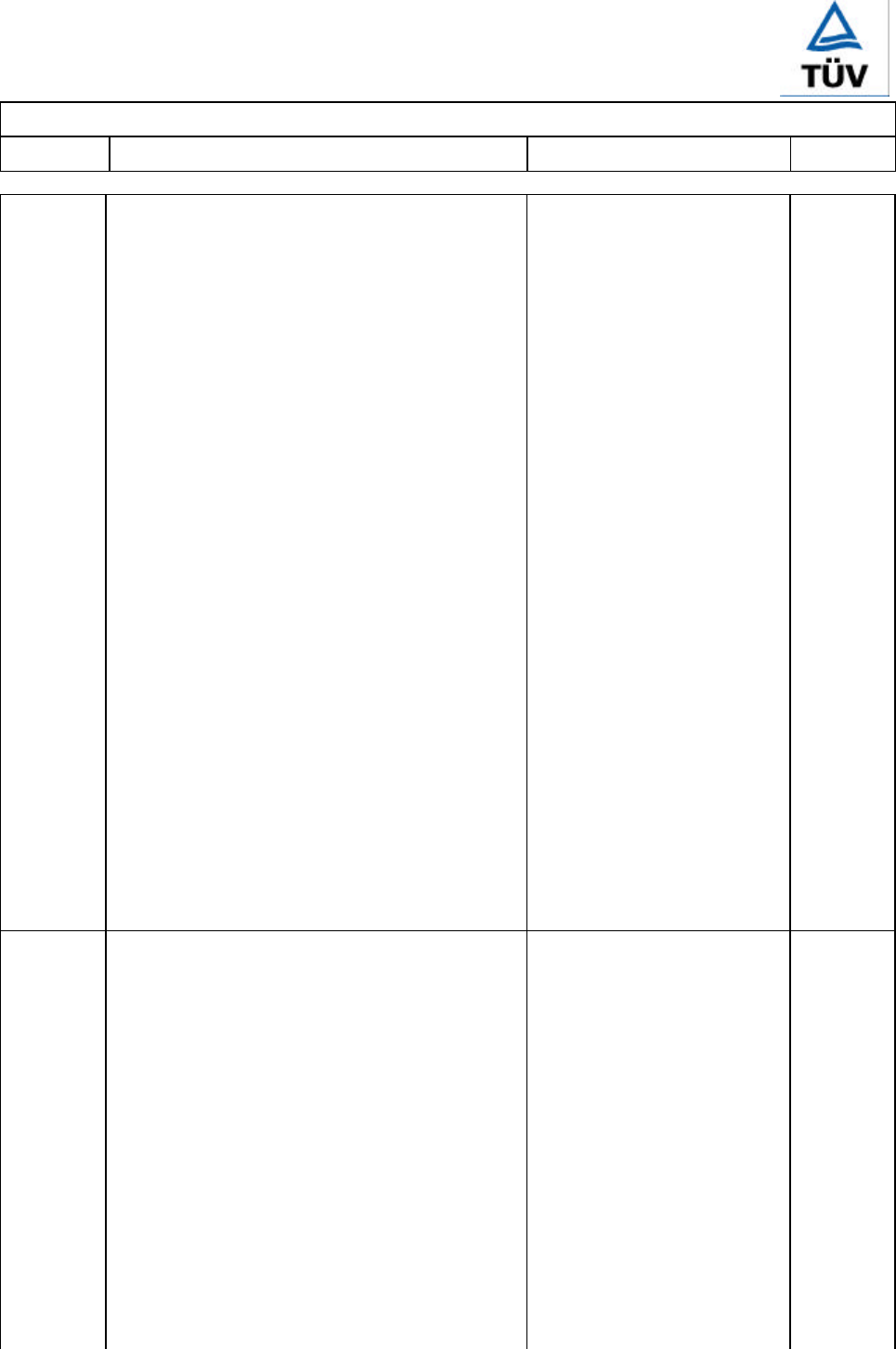
<12002388 001> Page 62
National Deviation
Clause Requirement − Test Result – Remark Verdict
Australian National Differences according to CB Bulletin No. 101A, December 2001
X2.2 ADDITIONAL TEST REQUIREMENTS
If parts, other than enclosures, do not withstand the
test of clauses X2.1.3 or X2.1.4, by failure to
extinguish within 30s after removal of the glow wire
tip, the needle-flame test of AS/NZS 3350.1 is
made on all parts of non-metallic material which are
within a distance of 50mm or which are likely to be
impinged upon by flame during the test of clauses
X2.1.3 or X2.1.4. Parts shielded by a separate
barrier which meets the flame-needle test are not
tested.
Notes:
1. If the enclosure does not withstand the glow-
wire test the appliance is considered to have
failed to meet the requirement of Appendix 2
without the need for consequential testing.
2. If other parts do not withstand the glow-wire
test due to ignition of the tissue paper and if
this indicates that burning or glowing particles
can fall onto an external surface underneath the
appliance, the appliance is considered to have
failed to meet the requirement of Appendix 2
without the need for consequential testing.
3. Parts likely to be impinged upon by the flame
are considered to be those within the envelope
of a vertical cylinder having a radius of 10mm
and a height equal to the height of the flame,
positioned above the point of the material
supporting, in contact with or in close proximity
to connections.
The needle-flame test need not be carried out on
parts which are made of classified as FV-0 or FV-1
according to IEC 60707. The sample of material
submitted to the test of IEC 60707 shall be no
thicker than the relevant part.
N
Appendix
3Add Appendix:
D.C. COMPONENTS FROM A.C. EQUIPMENT
Equipment shall be designed so that in normal use
the value of any direct current in the equipment
neutral will not contribute unduly to the failure of
the installation earth electrode by corrosion.
Any device such as isolating transformer intended to
prevent direct current in the supply shall be an
integral part of the equipment.
No DC component under
normal operation condition. P
Compliance is checked by inspection and by
operating the equipment
(a) at the rated voltage under the conditions
specified in Clause 5.1;
(b) on a supply free from any d.c. component; and
(c) in the maximum d.c. producing mode, if any,
but not exceeding normal load;
and measuring the d.c. component in the supply
neutral caused by the equipment as described
below.
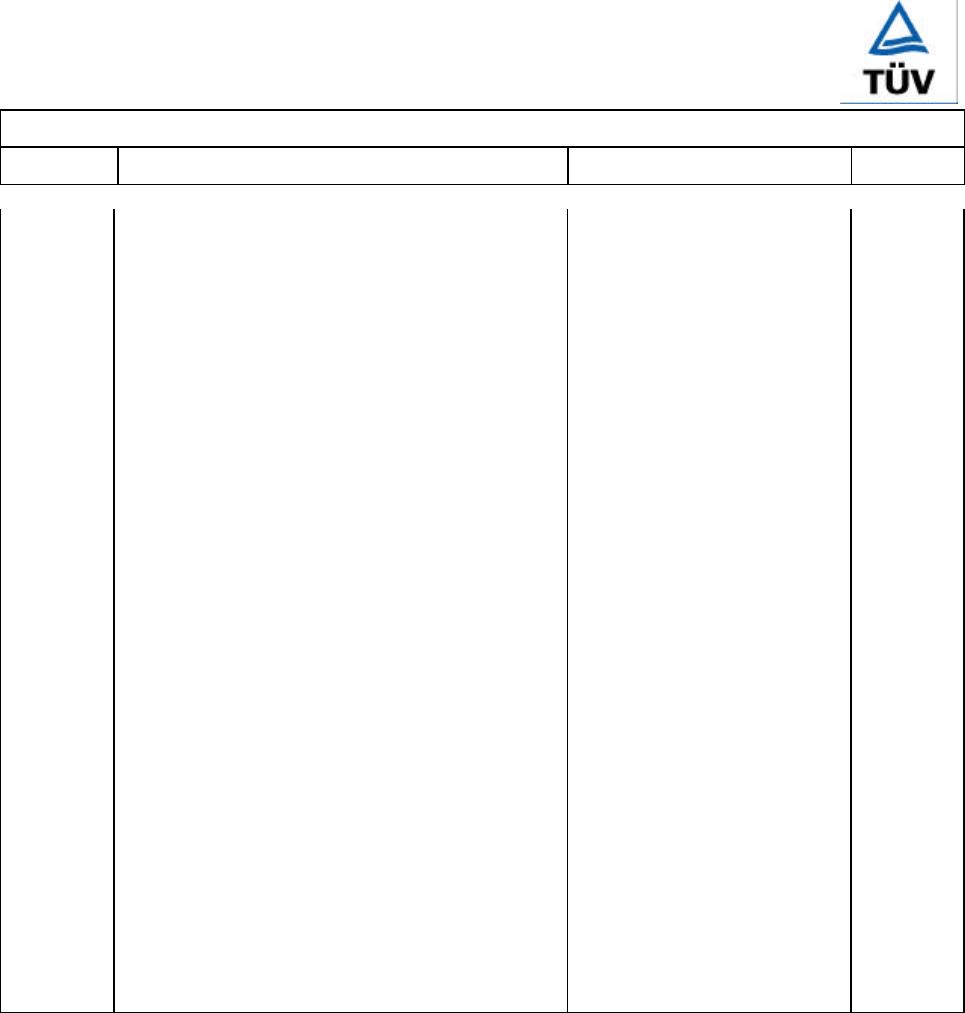
<12002388 001> Page 63
National Deviation
Clause Requirement − Test Result – Remark Verdict
Australian National Differences according to CB Bulletin No. 101A, December 2001
If it is evident from the design of the equipment that
there will be no d.c. component, e.g. equipment
provided with a full-wave mains power supply or a
mains isolating transformer, this test is not
conducted.
The permissible direct current in the equipment
neutral shall not exceed
(i) for equipment considered as operating
continuously ............................... 5 mA; or
(ii) for other than continuously operated
equipment where t is the assessed daily average
operating time, in hours ......(5*24)/t mA
For equipment which is not continuously operated
but includes a component or a device which is
continuously energized, e.g. stand-by control or
remote switching device, the summation of the
product of the direct current from the control device
over 24h and the direct current from the equipment
for its assessed daily average operating time in
hours shall not exceed 120mAh per day.
The maximum value of direct current permitted in
the neutral is 1.44A which could be applicable to
equipment with an assessed average daily operating
time of 5 min. or less.
Notes:
1. When determining the assessed daily average
operating time the approvals authority may
accept evidence supplied by the manufacturer.
2. The d.c. peak value due to transient starting
effects is ignored.
The measuring system used to measure any direct
current produced shall have a sufficiently high
normal (series) mode rejection ratio, by the use of a
low pass filter if necessary, to ensure that an overall
uncertainty of less than 10% can be achieved.
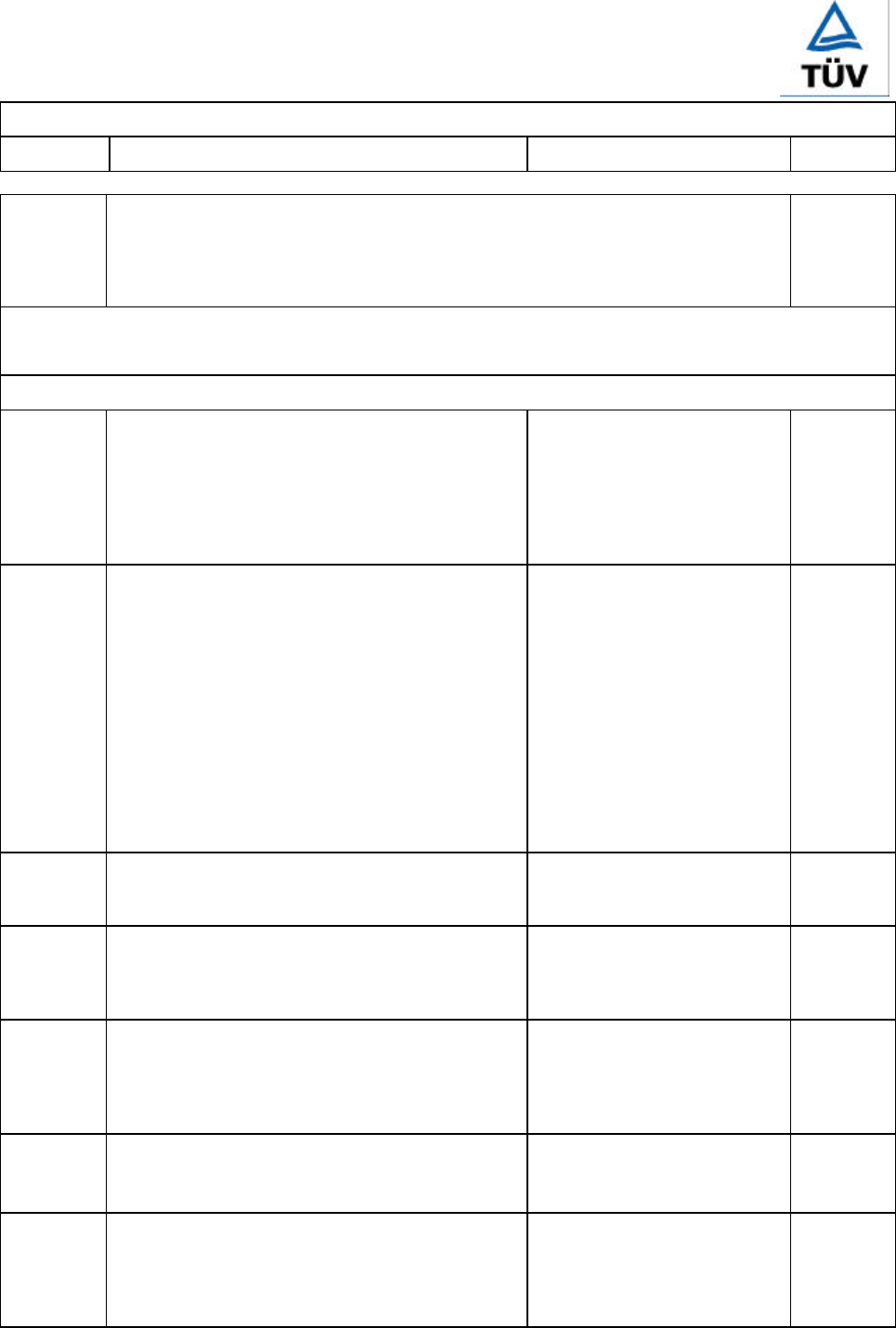
<12002388 001> Page 64
National Deviation
Clause Requirement − Test Result – Remark Verdict
Canadian National Differences according to CB Bulletin No. 101A, December 2001
APPENDIX Canadian National Differences according to CB Bulletin No. 101A, December
2001
(IEC Publication 60950 2nd edition, 1991 + Amd.1, 1992 + Amd.2, 1993
+ Amd.3, 1995 + Amd.4, 1996)
P
EXPLANATION FOR ABBREVIATIONS
P=Pass, F=Fail, N=Not applicable. Placed in the column to the right.
Special National Conditions
1.1.1 All equipment installations are required to be in
accordance with the Canadian Electrical Code
(CEC). Part 1, CAN/CSA C22.1, and with National
Electrical Code (NEC), ANSI/NFPA 70, and, unless
marked or otherwise identified, the Standard for the
Protection of Electronic Computer/Data-Processing
Equipment, ANSI/NFPA 75.
Considered. P
1.7.1 Equipment for use on supply systems with a neutral
and more than one phase conductor (e.g. 120/240
V, 3-wire) require a special marking format for
electrical ratings.
A voltage rating that exceeds an attachment plug
cap rating is only permitted if it does not exceed the
extreme operating conditions in Table 2 of
CAN/CSA C22.2 No. 235, and if it is part of a range
that extended into the Table 2 “Normal Operating
Conditions.” Likewise, a voltage rating shall not be
lower than specified “Normal Operating Condition,”
unless it is part of a range that extends into the
“Normal Operating Conditions.”
Single phase. N
2.5.9 Terminals for permanent wiring are required to be
suitable for U.S./Canadian wire gauge sizes and be
rated 125 percent of the equipment rating.
N
2.5.11 When subject to impedance testing, protective
earthing and bonding are required to be tested to
the additional test conditions that originate in
CAN/CSA C22.2 No. 0.4.
Considered, see IEC 60950
report. P
2.6.2 Motor control devices are required for cord-
connected equipment with a motor if the motor (a)
has a nominal voltage rating greater than 120V, (b)
in rated more than 12 A, or (c) is rated more than
1/3 hp (locked rotor current over 43 A).
Not motor control device. N
2.6.8 Vertically-mounted disconnect switches and circuit
breakers are required to have the “on” position
indicated by the handle in the up position.
No vertically mounted
disconnect switch or circuit
breaker.
N
2.6.11 For computer room applications, equipment with
battery systems capable of supplying 750 VA for
five minutes are required to have a battery
disconnect means that may be connected to the
computer room remote power off circuit.
No battery system. N
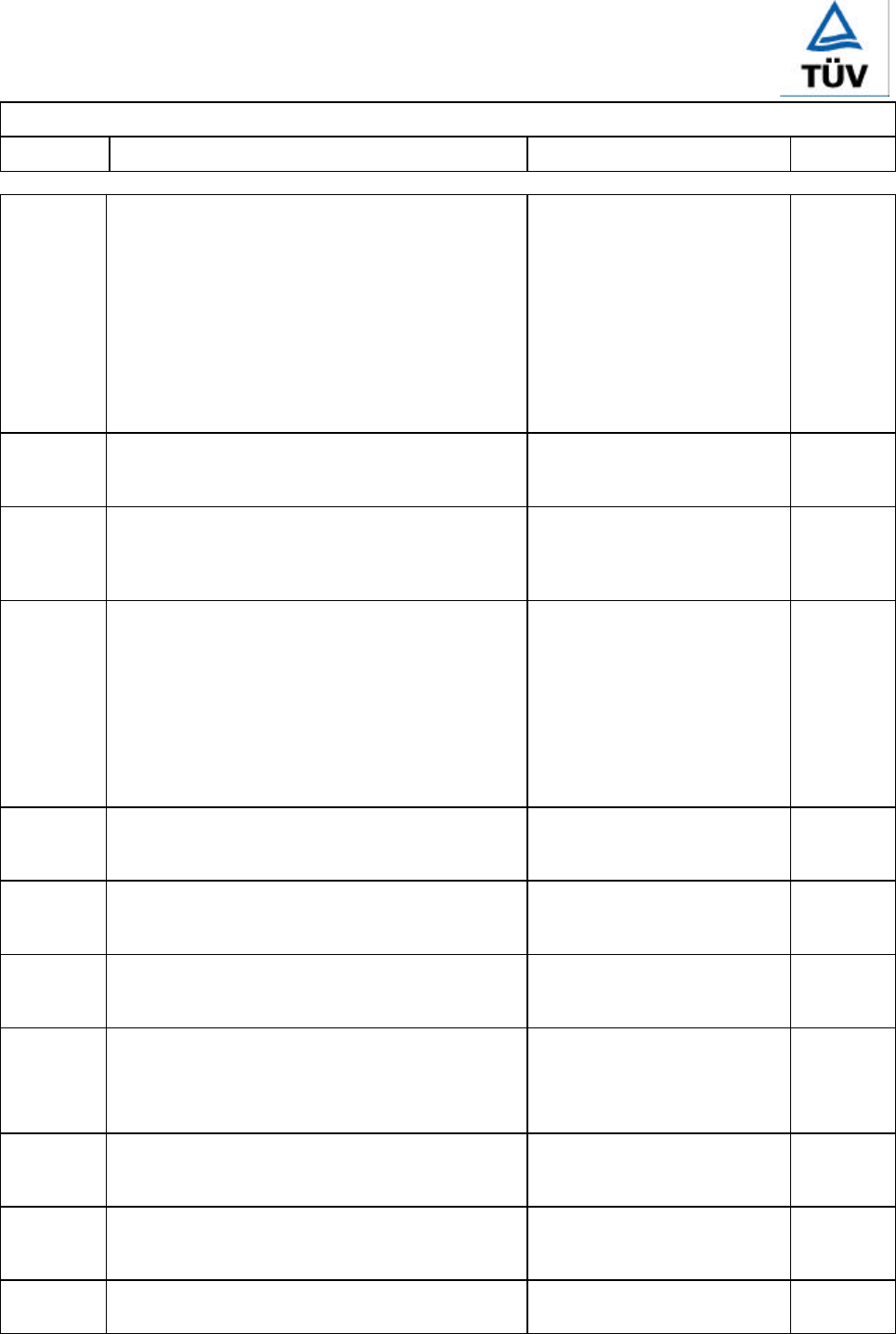
<12002388 001> Page 65
National Deviation
Clause Requirement − Test Result – Remark Verdict
Canadian National Differences according to CB Bulletin No. 101A, December 2001
2.7.1 Suitable NEC/CEC branch circuit protection is
required for all standard supply outlets and medium-
base or smaller lampholders if the supply branch
circuit protection is not suitable.
Power distribution transformers distributing power
at 100 volts or more, and rated 10KVA or more,
required transformer overcurrent protection.
Panelboards provided as part of information
technology equipment are required to have suitable
overcurrent protection.
No power outlet. N
2.7.6 Fuses provided in the earthed circuit conductor
(neutral) are only permitted for equipment rated
125V, 15A.
No fuse in neutral or earth
conductors. N
2.11 Where a fuse is used to provide Class 2, Limited
Power Source, or TNV current limiting, it shall not
be operator-accessible unless it is not
interchangeable.
N
3.1.12 For lengths exceeding 2 m, external interconnecting
flexible cord and cable assemblies are required to be
suitable cable type (e.g. DP, CL2) described in the
NEC.
For lengths 3.05 m or less, external interconnecting
flexible cord and cable assemblies which are not
types specified in the
CEC/NEC are required to have special construction
features and identification markings.
N
3.2 Wiring methods (terminals, leads, etc.) used for the
connection of the equipment to the mains shall be in
accordance with the CEC/NEC.
No power cord provided. N
3.2.1 Power supply cords are required to have attachment
plugs rated not less than 125 percent of the rated
current of the equipment.
No power cord provided. N
3.2.2 Permanent connection of equipment to the mains by
a power supply cord is not permitted. except for
certain equipment,such as ATMs.
No power cord provided. N
3.2.4 Power supply cords are required to be not longer
than 4.5 m in length.
Flexible power supply cords are required to be
compatible with article 400 of the NEC
No power cord provided. N
3.2.8 Permanently connected equipment is required to
have a suitable wiring compartment and wiring
bending space.
No power cord provided. N
3.3 Wiring terminals and associated spacings for field
wiring connections shall comply with CAN/CSA No.
0.
No power cord provided. N
3.3.3 Wiring binding screws are not permitted to attach
conductors larger than 10 AWG (5.3mm²). No wire binding screws used N
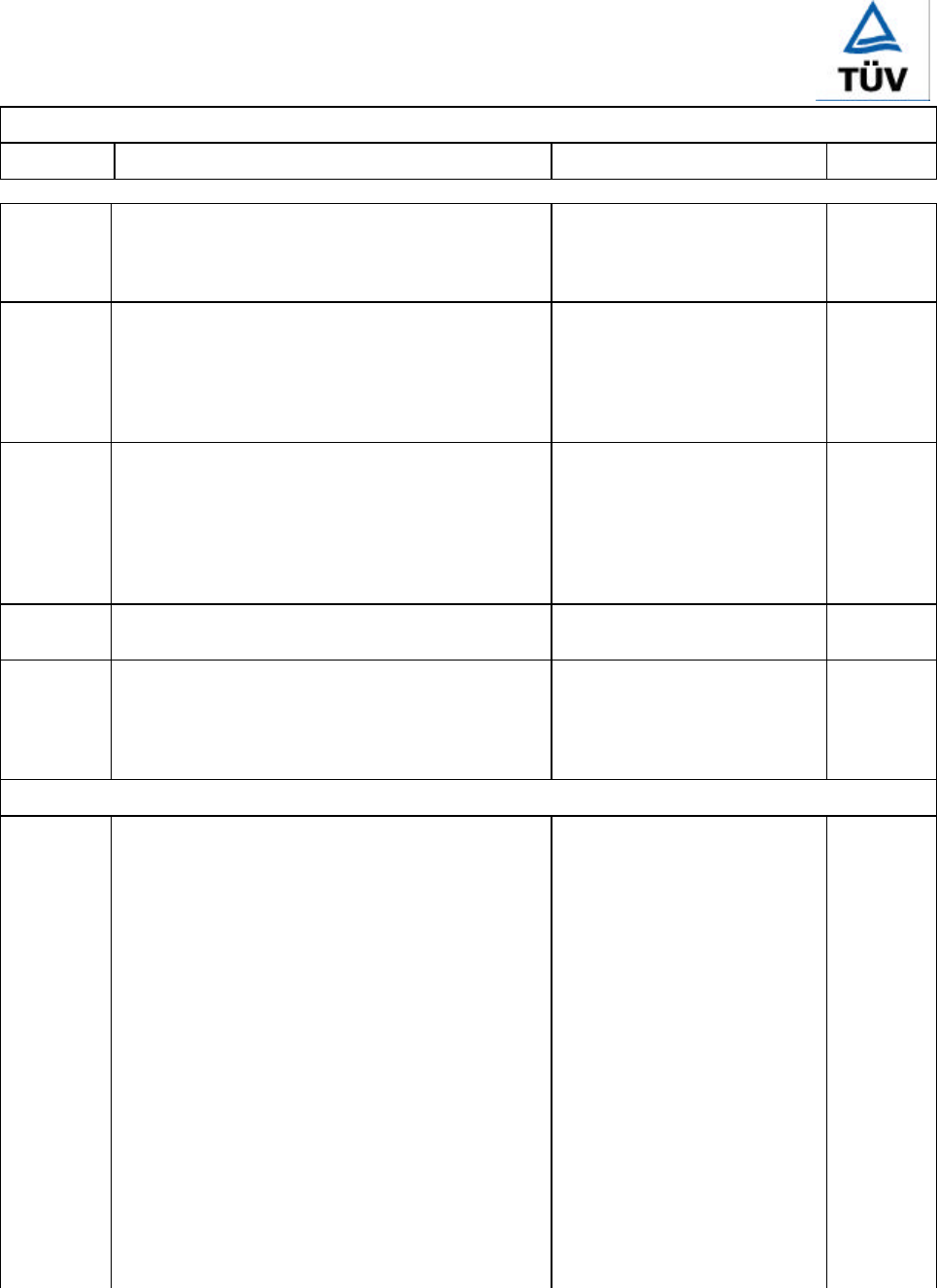
<12002388 001> Page 66
National Deviation
Clause Requirement − Test Result – Remark Verdict
Canadian National Differences according to CB Bulletin No. 101A, December 2001
4.3.12 Equipment with lasers is required to meet Code of
Federal Regulations 21 CFR 1040 and Canadian
Radiation Emitting Devices Act, REDR C1370, as
applicable.
Approved CD-ROM used. P
4.4.1 For computer room application, automated
information storage systems with combustible media
greater than 27 cubic feet are required to have a
provision for connection of either automatic
sprinklers or a gaseous agent extinguishing system
with an extended discharge.
No automated information
storage system. N
4.4.4 For computer room applications, enclosures with
combustible material measuring greater than 0.9 m²
or a single dimension greater than 1.8 m, are
required to have flame spread rating of 50 or less.
For other applications, enclosures with the same
dimensions require a flame spread rating of 200 or
less.
Enclosure is far smaller than
0.9m² or 1.8m in a single
dimension.
N
4.4.8 The maximum quantity of flammable liquid stored in
equipment is required to meet NFPA 30. No liquid. N
Annex H Equipment that produces ionizing radiation is
required to comply with Code of Federal
Regulations, 21 CRF 1020 and/or Canadian
Radiation Emitting Devices Act, REDR C1370, as
applicable.
N
Other Differences
1.5.1 Components of equipment must be suitable for the
application, and must comply with the requirements
of the equipment standard and the Canadian or U.S.
components standards, as far as they may apply.
The acceptance will be based on the following:
A) A component certified by a Canadian or U.S.
NCB to a Canadian or U.S. component standard will
be checked for correct application and use in
accordance with its specified rating. Where
necessary, it will also be subjected to the applicable
tests of the equipment standard.
Components are UL or CSA
approved, see component list
1.5.1.
P
B) A component which has a CB Test Certificate for
compliance with a relevant IEC component standard
will be checked for correct application and use in
accordance with its specified ratings. Where
necessary, it will also be subjected to the applicable
tests of the equipment standard, and to the
applicable tests of the Canadian and U.S.
component standard, under the conditions occurring
in the equipment.
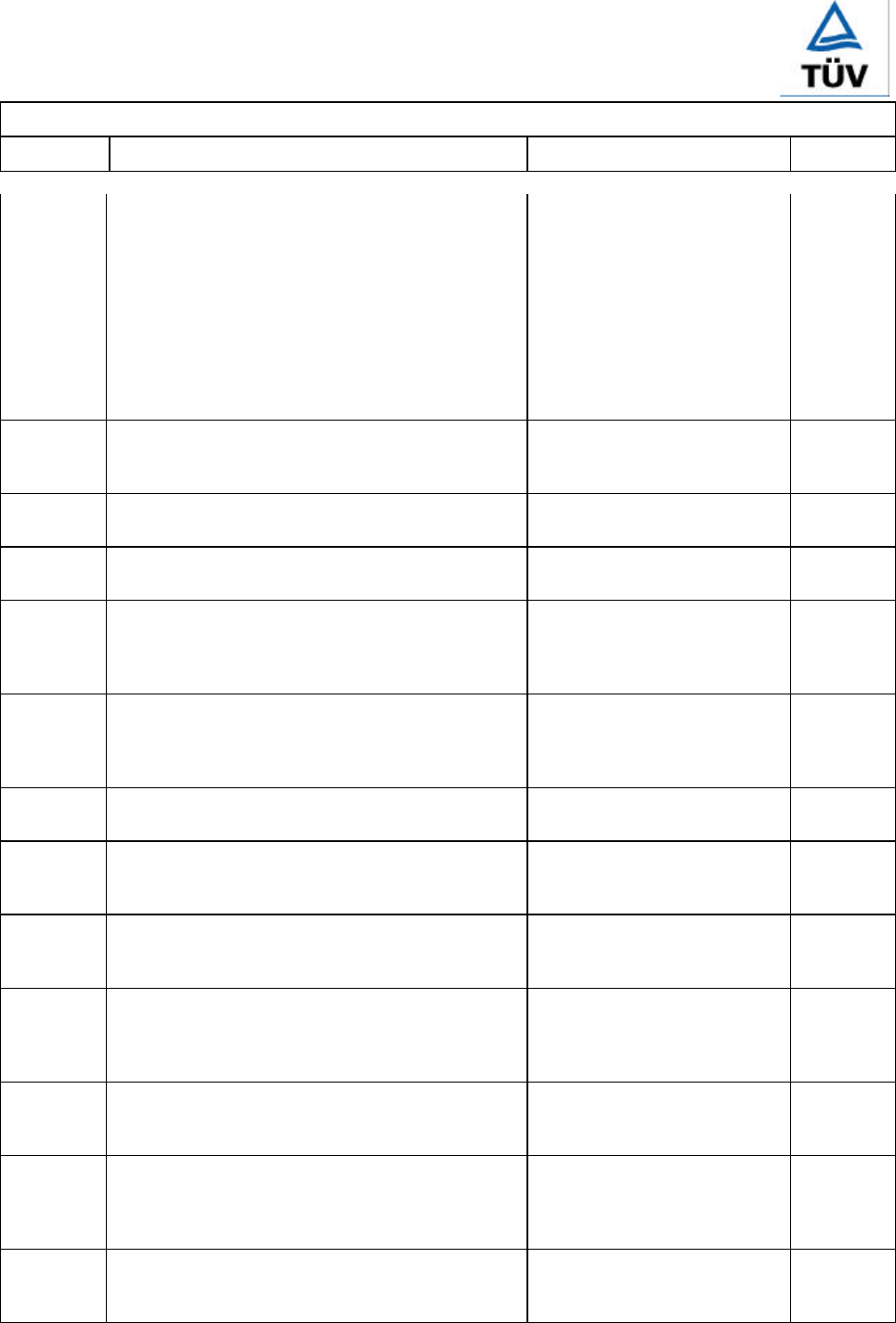
<12002388 001> Page 67
National Deviation
Clause Requirement − Test Result – Remark Verdict
Canadian National Differences according to CB Bulletin No. 101A, December 2001
C) A component which has no approval as in A) or
B) above or which is used not in accordance its
specified ratings, will be subjected to the applicable
tests of the equipment standard, and to the
applicable tests of the Canadian or U.S. component
standard, under the conditions occurring in the
equipment.
D) Some components may require annual re-testing
which may be carried out by the manufacturer, CSA
or another laboratory.
3.4 Equipment connected to a centralized d.c. power
system is required to meet special earthing wiring
and marking requirements.
N
4.1.6 Wall and ceiling mounted equipment is required to
comply with special loading tests. N
4.1.7 Equipment with handles is required to comply with
special loading tests. N
4.2.9 Enclosures around C.R.T´s having a diagonal
dimension of 160 mm or more are required to
reduce the risk of injury due to the implosion of the
CRT.
No CRT. N
6.2.1.1 Under normal operating conditions, the maximum
acceptable TNN-2 and TNV-3 circuit levels for other
than ringing signals are: (Uac/42.4 + Udc/60) < =
1.
No TNV. N
6.2.2.2 Access restrictions to TNV-2 and TNV-3 circuits in
battery compartment also apply to TNV-1 circuits. No TNV. N
6.3.4.3 Equipment intended to receive telecommunication
ringing signals is required to comply with special
leakage current measurement tests.
No TNV. N
6.4.1 Enamel coating on winding wire not considered
electrical separation unless subject to special
investigation.
No TNV. N
6.4.3 Equipment connected to a telecommunications
network and supplied with an earphone intended to
be held against the ear is required to comply with
special acoustic pressure tests.
No TNV. N
6.5 Where a fuse is used to provide current limiting, it
shall not be operator-accessible unless it is not
interchangeable.
No TNV. N
6.6 Equipment intended for connection to
telecommunication network outside plant cable is
required to be protected against overvoltage from
power line crosses.
No TNV. N
M.2 Continuous ringing signals up to 16 mA only are
permitted if subject to special installation and
performance restrictions.
No TNV. N
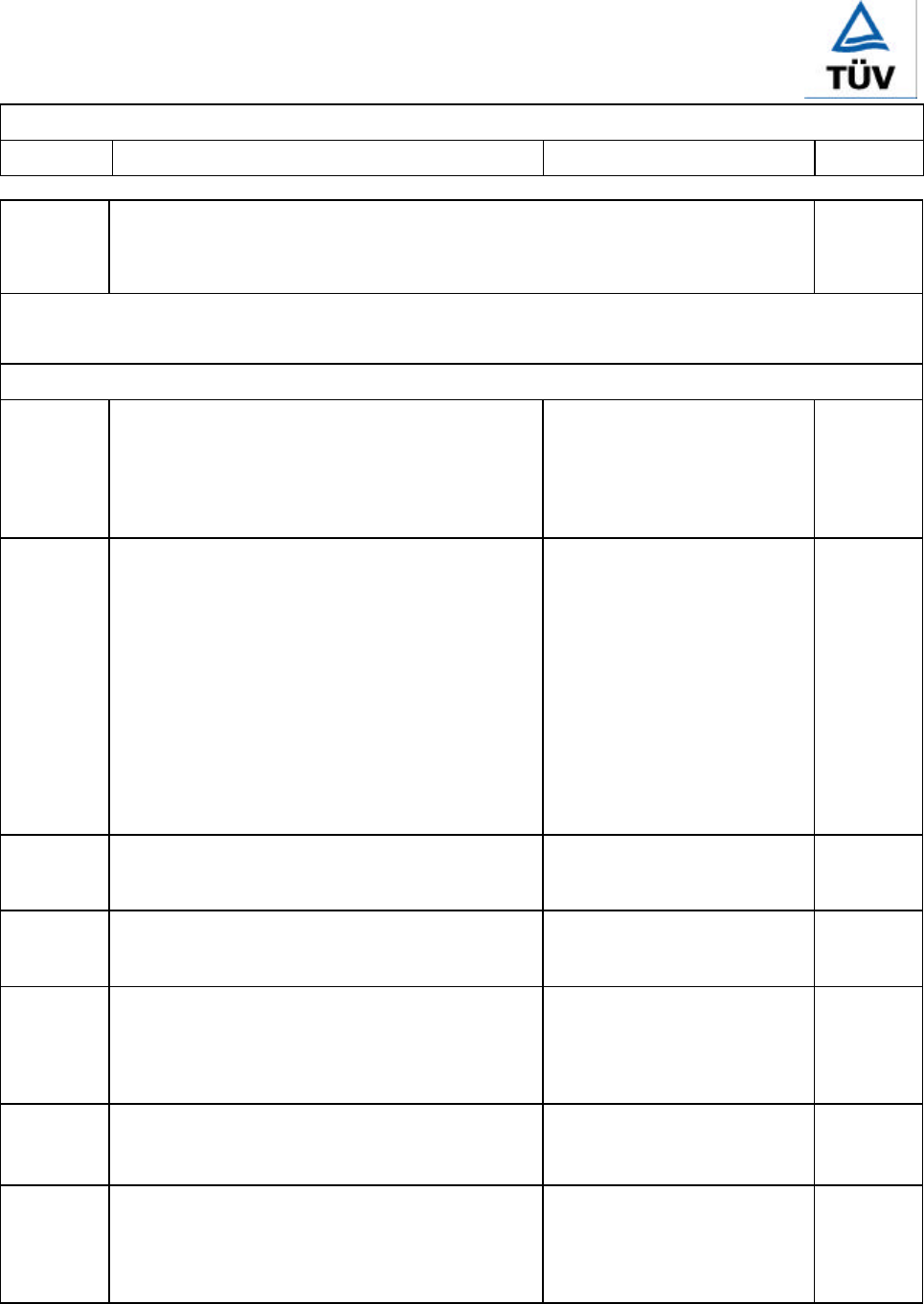
<12002388 001> Page 68
National Deviation
Clause Requirement − Test Result – Remark Verdict
US National Differences according to CB Bulletin No. 101A, December 2001
APPENDIX US National Differences according to CB Bulletin No. 101A, December 2001
for IEC 60950 (1991) 2nd Edition, Amendment No.1 (1992), Amendment No.
2 (1993), Amendment No. 3 (1995) and Amendment No. 4 (1996)
P
EXPLANATION FOR ABBREVIATIONS
P=Pass, F=Fail, N=Not applicable. Placed in the column to the right.
The following national differences are based on national regulatory requirements.
1.1.1 All equipment installations are required to be in
accordance with the National Electrical Code (NEC),
ANSI/NFPA 70, and unless marked or otherwise
identified, the Standard for the Protection Electronic
Computer/Data-Processing Equipment, ANSI/NFPA
75.
Considered. P
1.7.1 Equipment for use on supply systems with a neutral
and more than one phase conductor (e.g.
120/240V, 3-wire) require a special marking format
for electrical rating.
A voltage rating that exceeds an attachment plug
cap rating is only permitted if it does not exceed the
extreme operating conditions in Table 2 of
CAN/CSA C22.2 No. 235, and if it is part of a range
that extends into the Table 2 “Normal Operating
Conditions”. Likewise, a voltage rating shall not be
lower than the specified “Normal Operating
Conditions”, unless it is part of a range that extends
into the “Normal Operating Conditions”.
Single phase. N
2.5.9 Terminals for permanent wiring are required to be
suitable for U.S./Canadian wire gauge sizes and be
rated 125 percent of the equipment rating.
N
2.5.11 The capacity of the connection between the
earthing terminal and parts required to be earthed is
required to comply with CAN/CSA C22.2 No. 0.4.
Considered, see IEC 60950
report. P
2.6.2 Motor control devices are required for cord-
connected equipment with a motor if the motor (a)
has a nominal voltage rating greater than 120V, (b)
is rated more than 12A, or (c) is rated more than
1/3 hp (locked rotor current over 43A).
No motor control device. N
2.6.8 Vertically mounted disconnect switches and circuit
breakers are required to have the “on” position
indicated by the handle in the “up” position.
No vertically mounted
disconnect switch or circuit
breaker.
N
2.6.11 For computer room applications, equipment with
battery systems capable of supplying 750VA for
five minutes are required to have a battery
disconnect means that may be connected to the
computer room remote power-off circuit.
No battery system.N
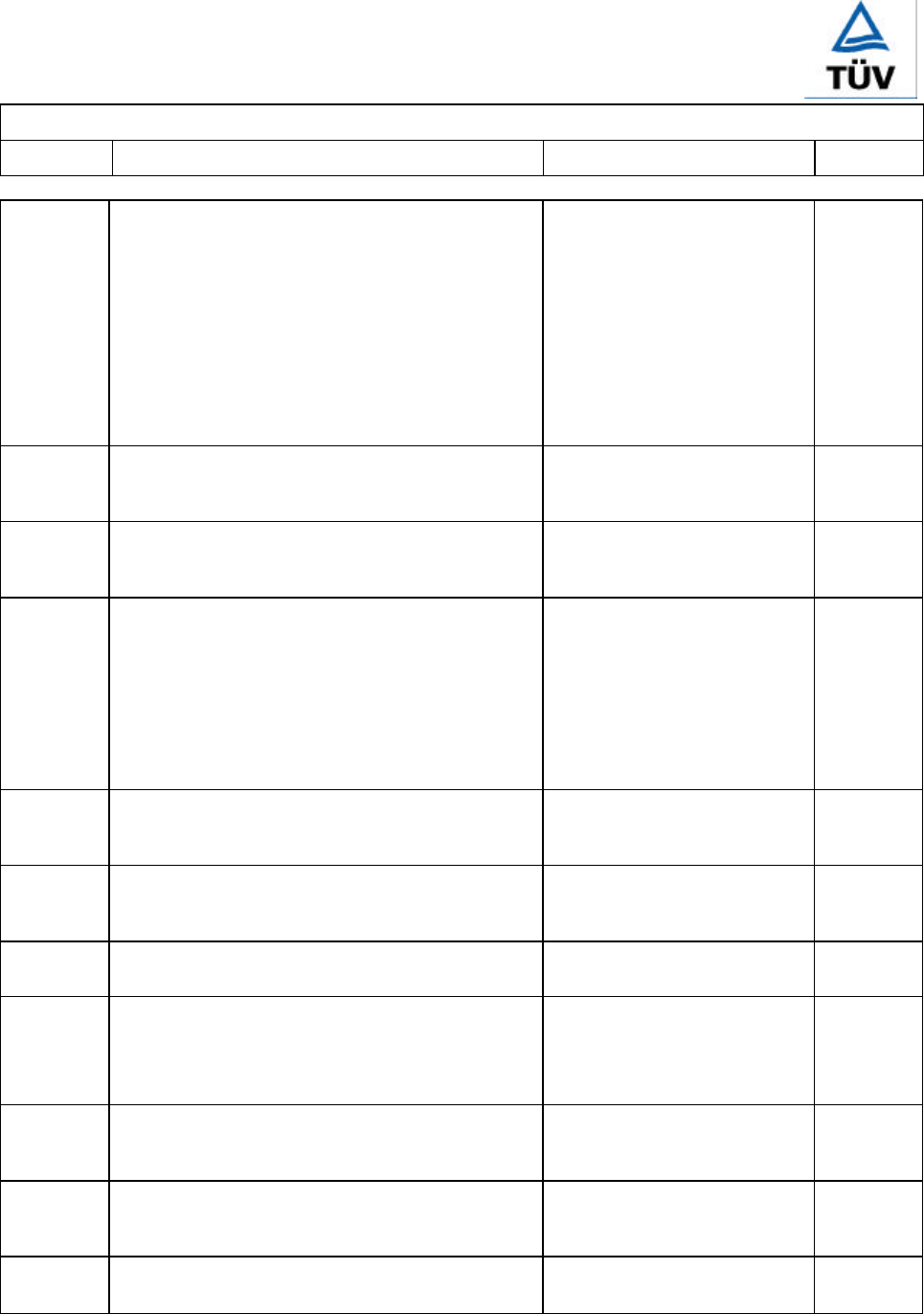
<12002388 001> Page 69
National Deviation
Clause Requirement − Test Result – Remark Verdict
US National Differences according to CB Bulletin No. 101A, December 2001
2.7.1 Suitable NEC/CEC branch circuit protection is
required for all standard supply outlets and medium-
base or smaller lampholders if the supply branch
circuit protection is not suitable.
Power distribution transformers distributing power
at 100 volts or more, and rated 10kVA or more,
require transformer overcurrent protection.
Panelboards provided as part of information
technology equipment are required to have suitable
overcurrent protection.
N
2.7.6 Fuses provided in the earthed circuit conductor
(neutral) are only permitted for equipment rated
125V, 15A.
No fuse in earthing
conductor. N
2.11 Where a fuse is used to provide current limiting, it
shall not be operator-accessible unless it is not
interchangeable.
No fuse used for limited
power. N
3.1.12 For lengths exceeding 3.05m, external
interconnecting flexible cord and cable assemblies
are required to be a suitable cable type (e.g. DP,
CL2) described in the NEC.
For length 3.05m or less, external interconnecting
flexible cord and cable assemblies which are not
types specified in the NEC are required to have
special construction features and identical markings.
No power cord provided. N
3.2 Wiring methods (terminals, leads, etc.) used for the
connection of the equipment to the mains shall be in
accordance with the NEC
No power cord provided. N
3.2.1 Power supply cords are required to have attachment
plugs rated not less than 125 percent of the rated
current of the equipment.
No power cord provided. N
3.2.2 Permanent connection of equipment to the mains by
a power supply cord is not permitted. No power cord provided. N
3.2.4 Power supply cords are required to be no longer
than 4.5m in length.
Flexible power supply cords are required to be
compatible with Article 400 of the NEC.
No power cord provided. N
3.2.8 Permanently connected equipment is required to
have a suitable wiring compartment and wiring
bending space.
No power cord provided. N
3.3 Wiring terminals and associated spacings for field
wiring connections shall comply with CSA C22.2
No. 0.
No power cord provided. N
3.3.3 Wire binding screws are not permitted to attach
supply conductors larger than 10 AWG (5.3mm²). No wire binding screws. N
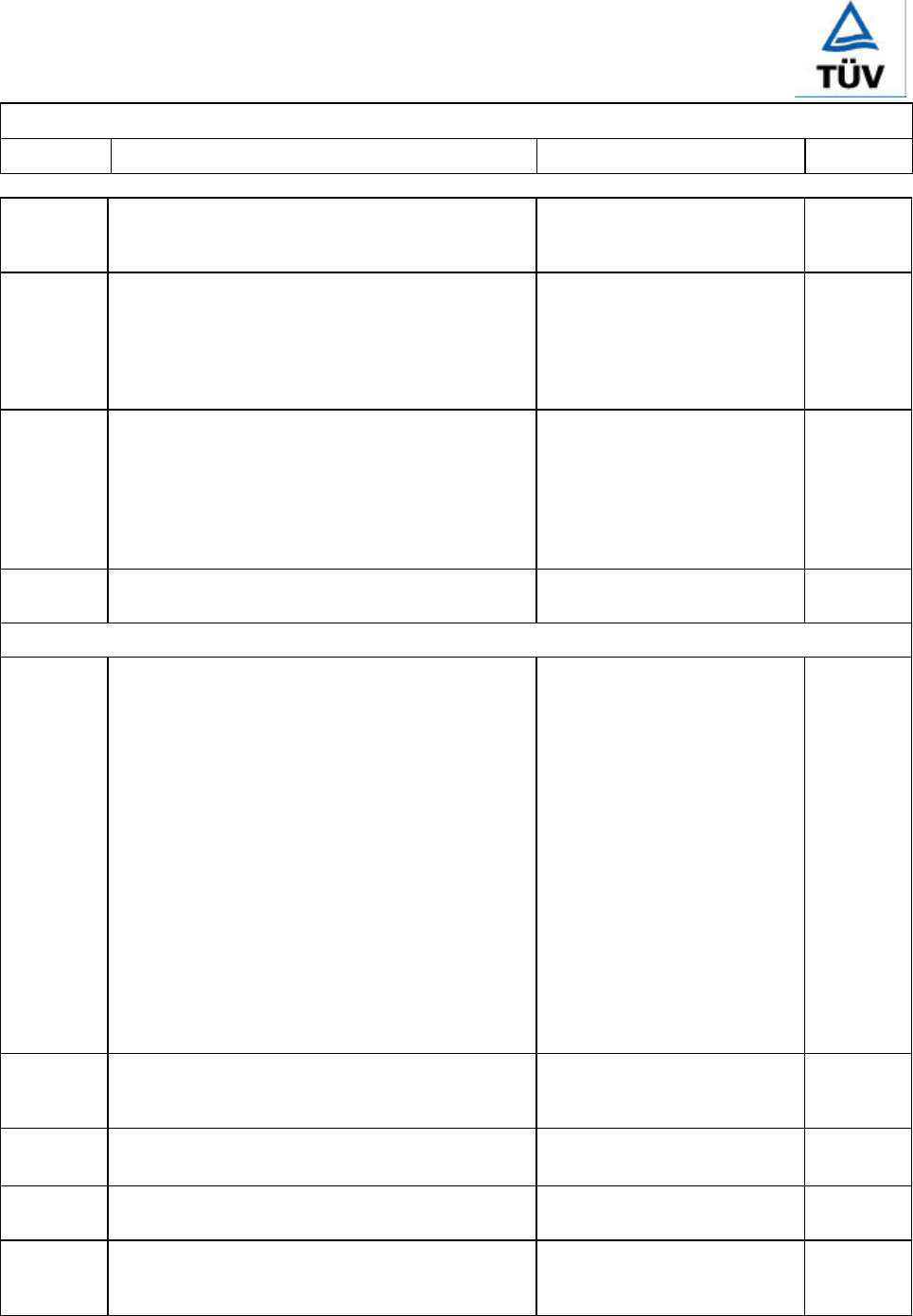
<12002388 001> Page 70
National Deviation
Clause Requirement − Test Result – Remark Verdict
US National Differences according to CB Bulletin No. 101A, December 2001
4.3.12 Equipment with lasers is required to meet Code of
Federal Regulations 21CFR 1040 and Canadian
Radiation Emitting Devices Act, REDR C1370.
Approved CD-ROM used. P
4.4.1 For computer room applications, automated
information storage systems with combustible media
greater than 27 cubic feet are required to have a
provision for connection of either automatic
sprinklers or a gaseous agent extinguishing system
with an extended discharge.
No automated information
storage system. N
4.4.4 For computer room applications, enclosures with
combustible material measuring greater than
0.93mm² or having a single dimension greater than
1.8m are required to have a flame spread rating of
50 or less. For other applications, enclosures with
the same dimensions require a flame spread rating
of 200 or less.
Enclosure is far smaller than
0.9m² or 1.8m in a single
dimension.
N
4.4.8 The maximum quantity of flammable liquid stored in
equipment is required to meet NFPA 30. No liquid. N
The following national differences are based on requirements other than national regulatory requirements.
1.5.1 Some components and materials associated with the
risk of fire, electric shock, or personal injury are
required to have component or material ratings in
accordance with the applicable national (U.S. and
Canadian) component or material requirements.
These components include:
attachment plugs, cathode ray tubes, circuit
breakers, communication circuit accessories, cord
sets and power supply cords, enclosures (outdoor),
flexible cords and cables, fuses, fuseholders,
ground-fault current interrupters, industrial control
equipment, insulating tape, lampholders, limit
controls, printed wiring, protectors for
communication circuits, receptacles, solid state
controls, supplementary protectors, surge
suppressors, switches, thermal cutoffs,
thermostats, tubing, wire connectors, and wire and
cables.
Components are UL
approved, see component list
1.5.1.
P
3.4 Equipment connected to a centralized d.c. power
system is required to meet special earthing, wiring
and marking requirements.
No connection to centralized
d.c. power system. N
4.1.6 Wall and ceiling mounted equipment is required to
comply with special loading tests. No wall or ceiling mounted
equipment. N
4.1.7 Equipment with handles is required to comply with
special loading tests. No handles. N
4.2.9 Enclosures around CRT’s with a face area of
160mm or more are required to reduce the risk of
injury due to the implosion of the CRT.
No CRT. N
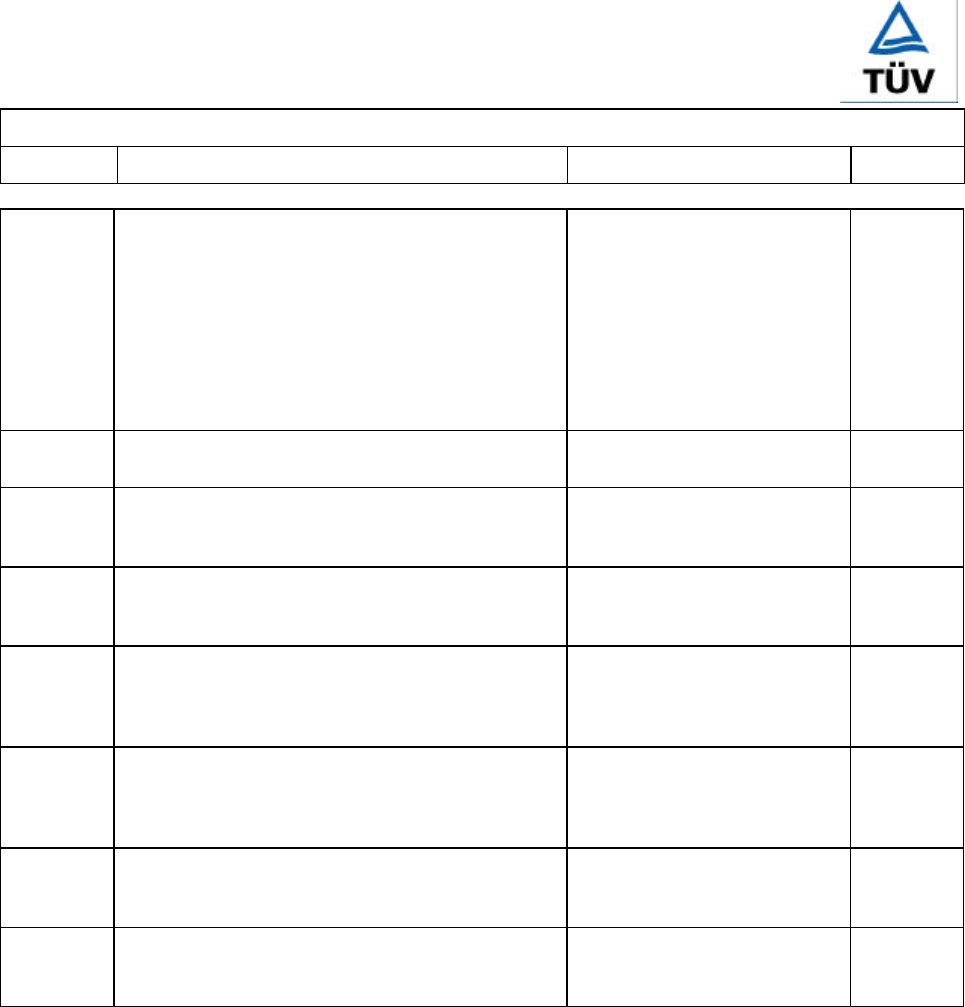
<12002388 001> Page 71
National Deviation
Clause Requirement − Test Result – Remark Verdict
US National Differences according to CB Bulletin No. 101A, December 2001
6.2.1.1 The maximum acceptable TNV circuit levels for
other than ringing signals are:
normal condition-
(Uac/42.4 + Udc/42.4 ≤1 for Udc ≤21.2
(Uac/32.8 + Udc/60) ≤ 1 for Udc >21.2
abnormal conditions-
(Uac/70.7 + Udc/120) ≤1
No TNV. N
6.2.2.2 Access restrictions to TNV-2 and TNV-3 circuits in
battery compartments also apply to TNV-1 circuits. No TNV. N
6.3.4.3 Equipment intended to receive telecommunication
ringing signals is required to comply with special
leakage current measurement test.
No TNV. N
6.4.1 Enamel coating on winding wire are not considered
electrical separation unless subjected to special
investigation.
No TNV. N
6.4.3 Equipment connected to a telecommunication
network and supplied with an earphone intended to
be held against the ear is required to comply with
special acoustic pressure tests.
No TNV. N
6.5 Equipment intended to provide power over the
telecommunication wiring system is required to limit
output current to values which will not damage the
telecommunication wiring system.
No TNV. N
6.6 Equipment intended for connection to
telecommunication network outside plant cable is
required to be protected against overvoltage.
No TNV. N
M.2 Continuous ringing signals up to 16mA only are
permitted if subjected to special installation and
performance restriction.
No TNV. N